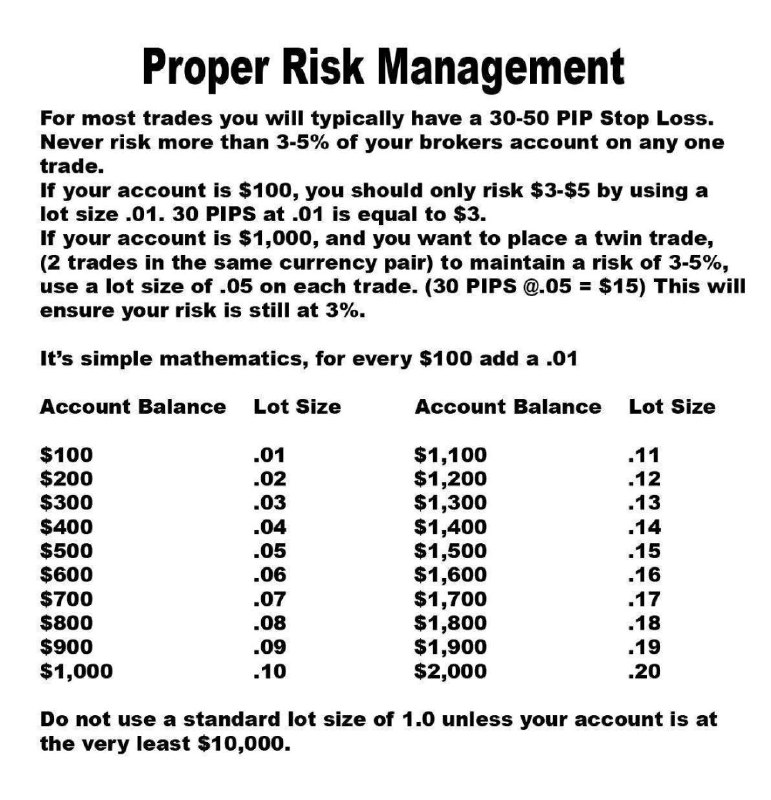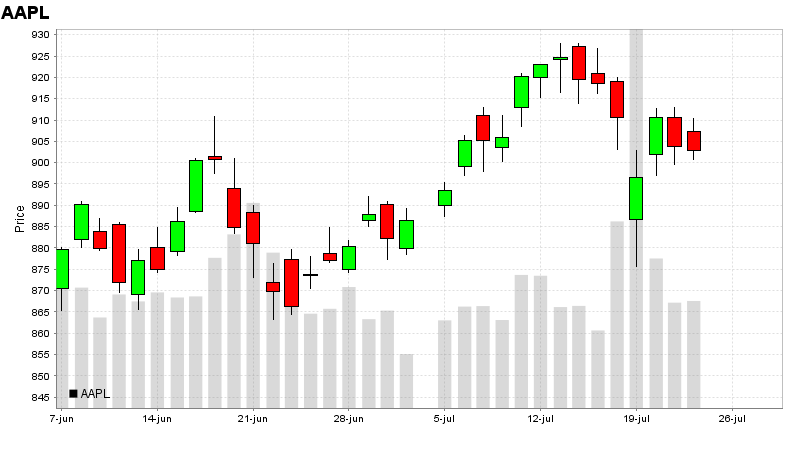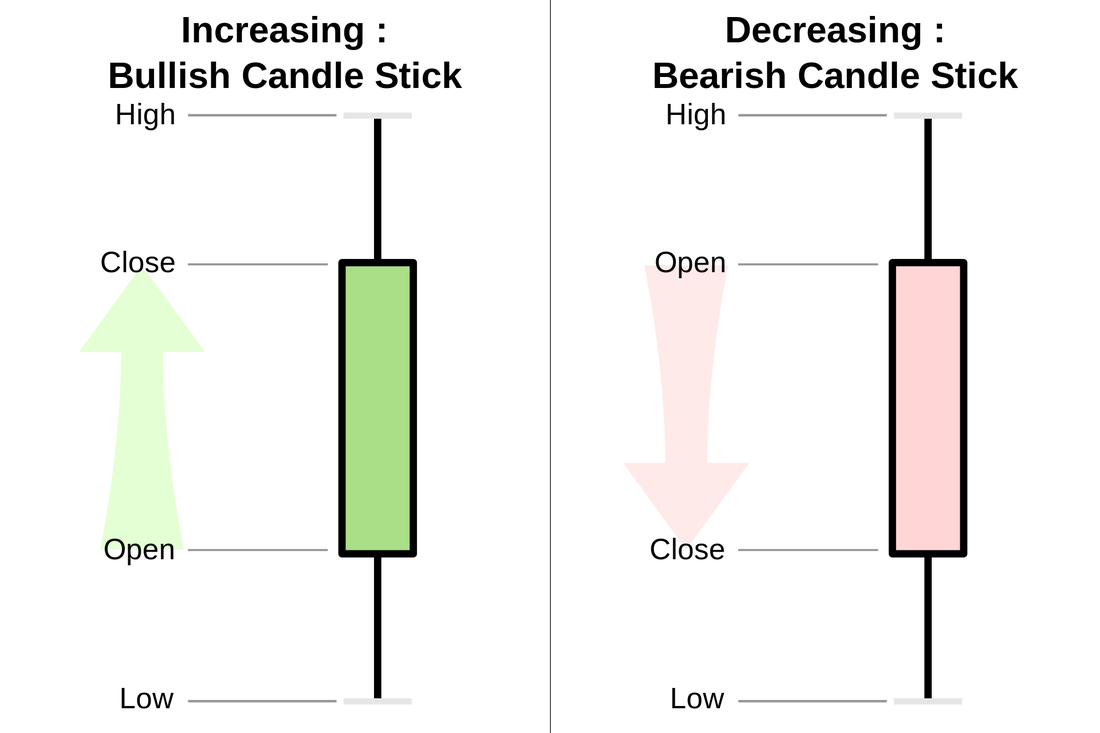What Is a Stock?
A stock is a form of security that indicates the holder has proportionate ownership in the issuing corporation. Corporations issue (sell) stock to raise funds to operate their businesses. There are two main types of stock: common and preferred. Common stock usually entitles the owner to vote at shareholders' meetings and to receive any dividends paid out by the corporation. Preferred stockholders generally do not have voting rights, though they have a higher claim on assets and earnings than the common stockholders. For example, owners of preferred stock receive dividends before common shareholders and have priority in the event that a company goes bankrupt and is liquidated. Stock holders do not own corporations; they own shares issued by corporations.
A stock is a form of security that indicates the holder has proportionate ownership in the issuing corporation. Corporations issue (sell) stock to raise funds to operate their businesses. There are two main types of stock: common and preferred. Common stock usually entitles the owner to vote at shareholders' meetings and to receive any dividends paid out by the corporation. Preferred stockholders generally do not have voting rights, though they have a higher claim on assets and earnings than the common stockholders. For example, owners of preferred stock receive dividends before common shareholders and have priority in the event that a company goes bankrupt and is liquidated. Stock holders do not own corporations; they own shares issued by corporations.
ST
What Is a Share?
A share refers to the stock certificate of a particular company. A single share of the stock represents fractional ownership of the corporation in proportion to the total number of shares. Holding a particular company's share makes you a shareholder.
So if someone says she "owns shares," some people's inclination would be to respond, "shares in what company?". Similarly, an investor might tell his broker to buy him 100 shares of Google. If he said "buy 100 stocks," he'd be referring to a whole collection of companies — 100 different ones, in fact.
A share refers to the stock certificate of a particular company. A single share of the stock represents fractional ownership of the corporation in proportion to the total number of shares. Holding a particular company's share makes you a shareholder.
So if someone says she "owns shares," some people's inclination would be to respond, "shares in what company?". Similarly, an investor might tell his broker to buy him 100 shares of Google. If he said "buy 100 stocks," he'd be referring to a whole collection of companies — 100 different ones, in fact.
ST
What Is The S&P 500?
The S&P 500 (Standard & Poor's 500) a stock market index that measures the stock performance of 500 large companies listed on stock exchanges in the US.
As of September 2018, the S&P 500 was divided into 11 sectors, as follows, with their respective weightings by market capitalization:
The S&P 500 (Standard & Poor's 500) a stock market index that measures the stock performance of 500 large companies listed on stock exchanges in the US.
As of September 2018, the S&P 500 was divided into 11 sectors, as follows, with their respective weightings by market capitalization:
- Communication Services: 9.9%
- Consumer Discretionary: 10.2%
- Consumer Staples: 6.7%
- Energy: 6.0%
- Financials: 13.7%
- Health Care: 14.9%
- Industrials: 9.7%
- Materials: 2.5%
- Real Estate: 2.7%
- Technology: 20.8%
- Utilities: 2.8%
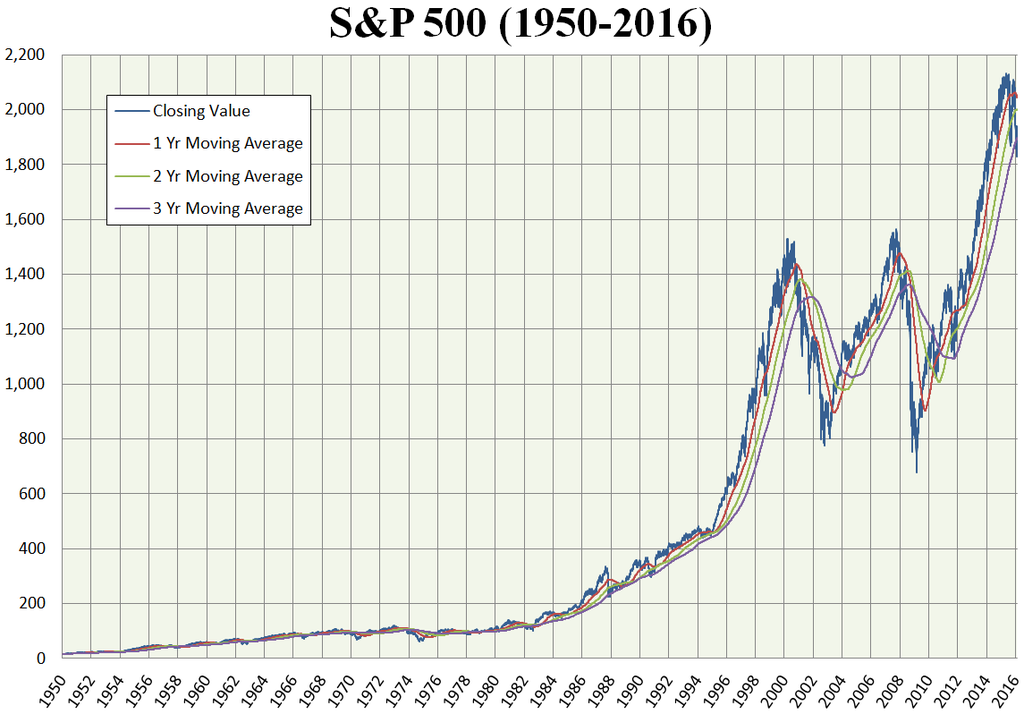
ST
What Is an Audit?
A financial audit is an objective examination and evaluation of the financial statements of an organization to make sure that the financial records are a fair and accurate representation of the transactions they claim to represent.
It is what the IRS issues when they coming for your ass.
A financial audit is an objective examination and evaluation of the financial statements of an organization to make sure that the financial records are a fair and accurate representation of the transactions they claim to represent.
It is what the IRS issues when they coming for your ass.
AU
What Is Accounting?
Accounting is the process of recording financial transactions pertaining to a business. The accounting process includes summarizing, analyzing, and reporting these transactions to oversight agencies, regulators, and tax collection entities. The financial statements used in accounting are a concise summary of financial transactions over an accounting period, summarizing a company's operations, financial position, and cash flows.
Accounting is the process of recording financial transactions pertaining to a business. The accounting process includes summarizing, analyzing, and reporting these transactions to oversight agencies, regulators, and tax collection entities. The financial statements used in accounting are a concise summary of financial transactions over an accounting period, summarizing a company's operations, financial position, and cash flows.
AU
What Are Taxes?
Taxes are involuntary fees levied on individuals or corporations and enforced by a government entity—whether local, regional or national—in order to finance government activities.
Taxes are involuntary fees levied on individuals or corporations and enforced by a government entity—whether local, regional or national—in order to finance government activities.
AU
What Is a W-4 Form?
Form W-4 is an Internal Revenue Service tax form completed by an employee in the United States to indicate his or her tax situation to the employer. The W-4 form tells the employer the correct amount of tax to withhold from an employee's paycheck.
Form W-4 is an Internal Revenue Service tax form completed by an employee in the United States to indicate his or her tax situation to the employer. The W-4 form tells the employer the correct amount of tax to withhold from an employee's paycheck.
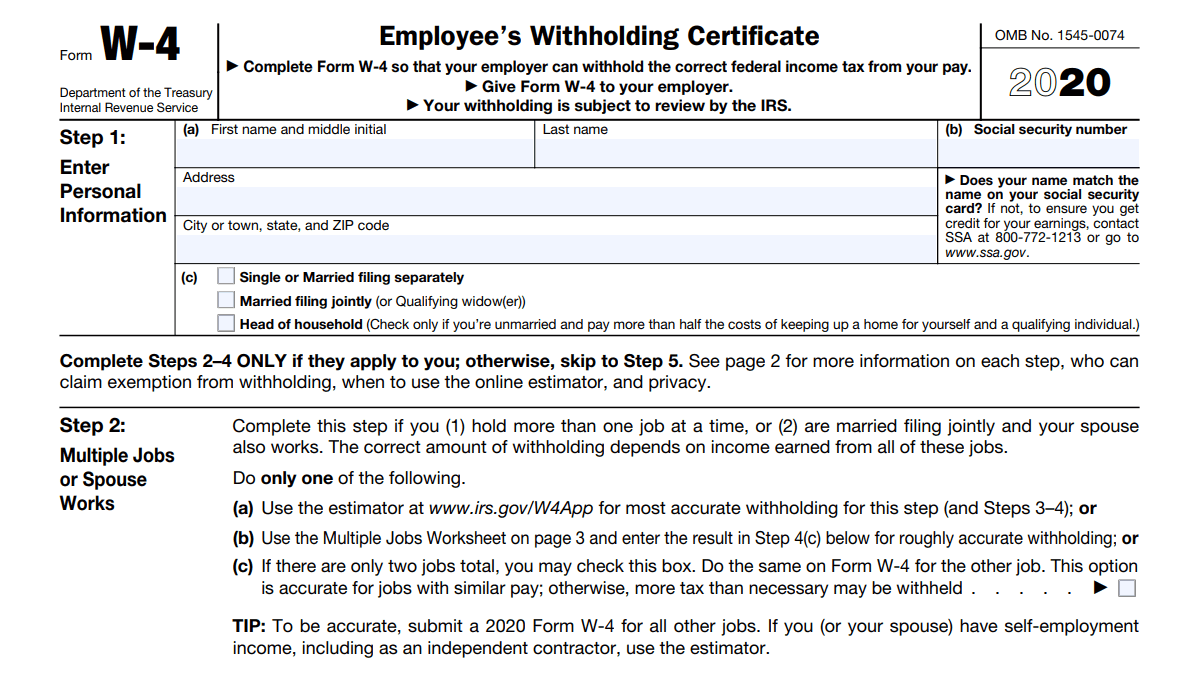
AU
What Is a W-3 Form?
Form W-3 is a transmittal form with totals for all parts of Form W-2. The W-3, along with the W-2, is sent to Social Security Administration each year to show the total earnings for all W-2 forms. The official title of the form is "Transmittal of Wage and Tax Statements." The difference between Form W-2 and Form W-3 is the person(s) who complete the forms. Employees are required to complete Form W-2 while employers are responsible for completing Form W-3.
Form W-3 is a transmittal form with totals for all parts of Form W-2. The W-3, along with the W-2, is sent to Social Security Administration each year to show the total earnings for all W-2 forms. The official title of the form is "Transmittal of Wage and Tax Statements." The difference between Form W-2 and Form W-3 is the person(s) who complete the forms. Employees are required to complete Form W-2 while employers are responsible for completing Form W-3.
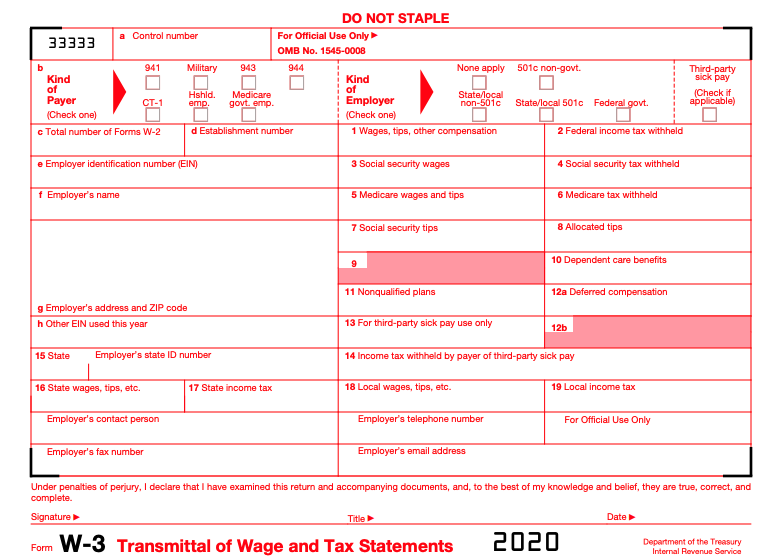
AU
What Is a W-2 Form?
A W-2 form, also known as the Wage and Tax Statement, is the document an employer is required to send to each employee and to the Internal Revenue Service (IRS) at the end of the year. A W-2 reports the employee's annual wages and the amount of taxes withheld from their paychecks.
A W-2 form, also known as the Wage and Tax Statement, is the document an employer is required to send to each employee and to the Internal Revenue Service (IRS) at the end of the year. A W-2 reports the employee's annual wages and the amount of taxes withheld from their paychecks.
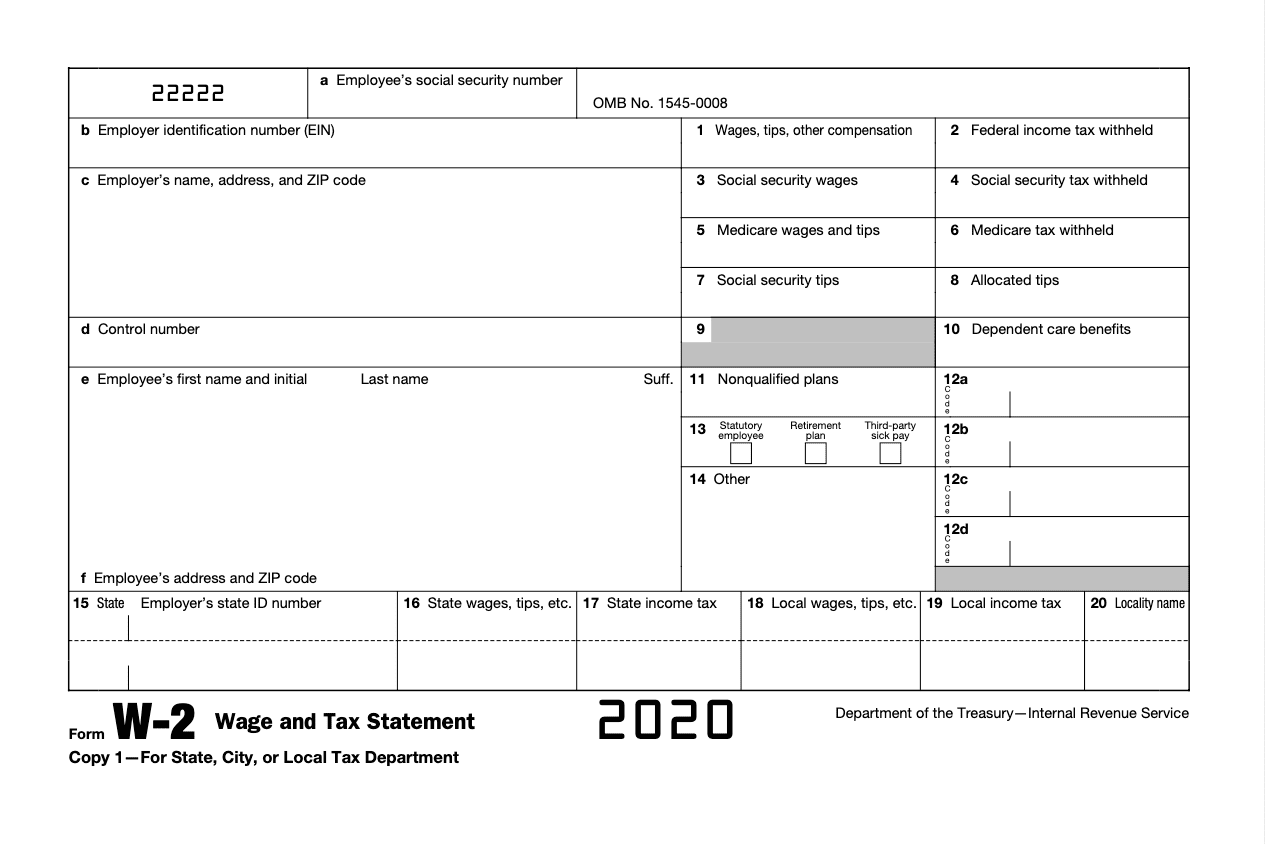
AU
What Is Trial Balance?
A trial balance is a worksheet with two columns, one for debits and one for credits, that ensures a company’s bookkeeping is mathematically correct. The debits and credits include all business transactions for a company over a certain period, including the sum of such accounts as assets, expenses, liabilities, and revenues.
A trial balance is a worksheet with two columns, one for debits and one for credits, that ensures a company’s bookkeeping is mathematically correct. The debits and credits include all business transactions for a company over a certain period, including the sum of such accounts as assets, expenses, liabilities, and revenues.

AU
What Is a Journal Entry?
In manual accounting or bookkeeping systems, business transactions are first recorded in a journal hence the term journal entry. Transactions are listed in an accounting journal that shows a company's debit and credit balances. The journal entry can consist of several recordings, each of which is either a debit or a credit.
In manual accounting or bookkeeping systems, business transactions are first recorded in a journal hence the term journal entry. Transactions are listed in an accounting journal that shows a company's debit and credit balances. The journal entry can consist of several recordings, each of which is either a debit or a credit.
AU
What Is The Double Entry System?
The double-entry system of accounting or bookkeeping means that for every business transaction, amounts must be recorded in a minimum of two accounts. It is a system of book keeping where every entry to an account requires a corresponding and opposite entry to a different account. The double-entry system also requires that for all transactions, the amounts entered as debits must be equal to the amounts entered as credits. The double-entry has two equal and corresponding sides known as debit and credit. The left-hand side is debit and right-hand side is credit.
The double-entry system of accounting or bookkeeping means that for every business transaction, amounts must be recorded in a minimum of two accounts. It is a system of book keeping where every entry to an account requires a corresponding and opposite entry to a different account. The double-entry system also requires that for all transactions, the amounts entered as debits must be equal to the amounts entered as credits. The double-entry has two equal and corresponding sides known as debit and credit. The left-hand side is debit and right-hand side is credit.
AU
What Is an Account?
In accounting, an account is a record in the general ledger that is used to sort and store transactions. For example, companies will have a Cash account in which to record every transaction that increases or decreases the company's cash. Another account, Sales, will collect all of the amounts from the sale of merchandise. Most accounting systems require that every transaction will affect two or more accounts. For example, a cash sale will increase the Cash account and will increase the Sales account.
In accounting, an account is a record in the general ledger that is used to sort and store transactions. For example, companies will have a Cash account in which to record every transaction that increases or decreases the company's cash. Another account, Sales, will collect all of the amounts from the sale of merchandise. Most accounting systems require that every transaction will affect two or more accounts. For example, a cash sale will increase the Cash account and will increase the Sales account.
AU
What Are The Types Of Accounts?
All accounts within the organization can be split into three types. An account can be of one and only one of the following type and not more. Here are the various types of accounts.
Personal: Personal accounts make most intuitive sense. We keep a track of all the transactions that we have undertaken with a particular person in them. We all maintain personal accounts like the money we owe our friends, the grocer and so on.
Real: Real accounts are accounts which have been created to account for tangible things. Accounts such as land and building, machinery a/c etc are called real accounts. Although they are not living beings, we still transact with such entities. Records of such transactions are kept in real accounts.
Nominal: Nominal accounts are a special category of accounts. While the other accounts can hold balance and carry it forward, nominal account are automatically reset to zero as soon as the time period is over. Their balance is carried forward to other accounts and the books for that period are closed. Examples of such accounts are Profit a/c, depreciation a/c etc.
All accounts within the organization can be split into three types. An account can be of one and only one of the following type and not more. Here are the various types of accounts.
Personal: Personal accounts make most intuitive sense. We keep a track of all the transactions that we have undertaken with a particular person in them. We all maintain personal accounts like the money we owe our friends, the grocer and so on.
Real: Real accounts are accounts which have been created to account for tangible things. Accounts such as land and building, machinery a/c etc are called real accounts. Although they are not living beings, we still transact with such entities. Records of such transactions are kept in real accounts.
Nominal: Nominal accounts are a special category of accounts. While the other accounts can hold balance and carry it forward, nominal account are automatically reset to zero as soon as the time period is over. Their balance is carried forward to other accounts and the books for that period are closed. Examples of such accounts are Profit a/c, depreciation a/c etc.
AU
What Are Three Golden Rules Of Accounting?
1. Debit The Receiver, Credit The Giver
This principle is used in the case of personal accounts. When a person gives something to the organization, it becomes an inflow and therefore the person must be credit in the books of accounts. The converse of this is also true, which is why the receiver needs to be debited.
2. Debit What Comes In, Credit What Goes Out
This principle is applied in case of real accounts. Real accounts involve machinery, land and building etc. They have a debit balance by default. Thus when you debit what comes in, you are adding to the existing account balance. This is exactly what needs to be done. Similarly when you credit what goes out, you are reducing the account balance when a tangible asset goes out of the organization.
3. Debit All Expenses And Losses, Credit All Incomes And Gains
This rule is applied when the account in question is a nominal account. The capital of the company is a liability. Therefore it has a default credit balance. When you credit all incomes and gains, you increase the capital and by debiting expenses and losses, you decrease the capital. This is exactly what needs to be done for the system to stay in balance.
The golden rules of accounting allow anyone to be a bookkeeper. They only need to understand the types of accounts and then diligently apply the rules.
1. Debit The Receiver, Credit The Giver
This principle is used in the case of personal accounts. When a person gives something to the organization, it becomes an inflow and therefore the person must be credit in the books of accounts. The converse of this is also true, which is why the receiver needs to be debited.
2. Debit What Comes In, Credit What Goes Out
This principle is applied in case of real accounts. Real accounts involve machinery, land and building etc. They have a debit balance by default. Thus when you debit what comes in, you are adding to the existing account balance. This is exactly what needs to be done. Similarly when you credit what goes out, you are reducing the account balance when a tangible asset goes out of the organization.
3. Debit All Expenses And Losses, Credit All Incomes And Gains
This rule is applied when the account in question is a nominal account. The capital of the company is a liability. Therefore it has a default credit balance. When you credit all incomes and gains, you increase the capital and by debiting expenses and losses, you decrease the capital. This is exactly what needs to be done for the system to stay in balance.
The golden rules of accounting allow anyone to be a bookkeeper. They only need to understand the types of accounts and then diligently apply the rules.
AU
What Is a General Ledger?
A general ledger represents the record-keeping system for a company's financial data with debit and credit account records validated by a trial balance. The general ledger provides a record of each financial transaction that takes place during the life of an operating company.
The general ledger holds account information that is needed to prepare the company's financial statements, and transaction data is segregated by type into accounts for assets, liabilities, owners' equity, revenues, and expenses.
A general ledger represents the record-keeping system for a company's financial data with debit and credit account records validated by a trial balance. The general ledger provides a record of each financial transaction that takes place during the life of an operating company.
The general ledger holds account information that is needed to prepare the company's financial statements, and transaction data is segregated by type into accounts for assets, liabilities, owners' equity, revenues, and expenses.
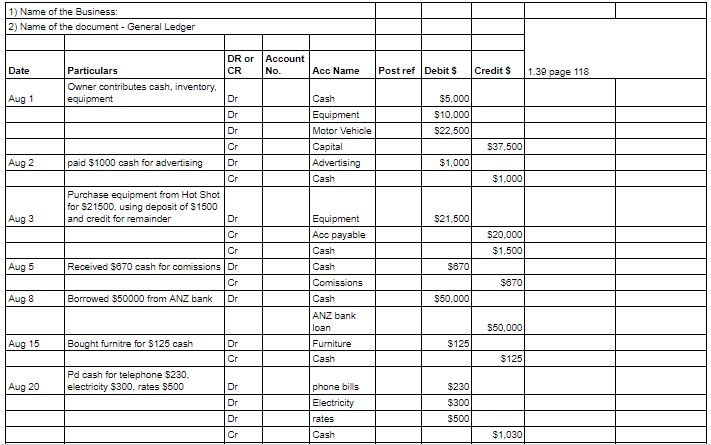
AU
What Are Financial Statements?
Financial statements are written records that convey the business activities and the financial performance of a company. Financial statements are often audited by government agencies, accountants, firms, etc. to ensure accuracy and for tax, financing, or investing purposes. Financial statements include: Balance Sheets, Income Statements, & Cash Flow Statements.
Financial statements are written records that convey the business activities and the financial performance of a company. Financial statements are often audited by government agencies, accountants, firms, etc. to ensure accuracy and for tax, financing, or investing purposes. Financial statements include: Balance Sheets, Income Statements, & Cash Flow Statements.
AU
What Is an Accounts Receivable (AR)?
Accounts receivable are legally enforceable claims for payment held by a business for goods supplied and/or services rendered that customers/clients have ordered but not paid for. These are generally in the form of invoices raised by a business and delivered to the customer for payment within an agreed time frame. AR is any amount of money owed by customers for purchases made on credit.
Accounts receivable are legally enforceable claims for payment held by a business for goods supplied and/or services rendered that customers/clients have ordered but not paid for. These are generally in the form of invoices raised by a business and delivered to the customer for payment within an agreed time frame. AR is any amount of money owed by customers for purchases made on credit.
AU
What Is The VIX?
VIX is the ticker symbol created by the Chicago Board Options Exchange (CBOE). The Volatility Index, or VIX, is a real-time market index that represents the market's expectation of 30-day forward-looking volatility. Derived from the price inputs of the S&P 500 index options, it provides a measure of market risk and investors' sentiments.
VIX is the ticker symbol created by the Chicago Board Options Exchange (CBOE). The Volatility Index, or VIX, is a real-time market index that represents the market's expectation of 30-day forward-looking volatility. Derived from the price inputs of the S&P 500 index options, it provides a measure of market risk and investors' sentiments.
ST
What Is Forex?
Foreign Exchange (forex or FX) is the trading of one currency for another. For example, one can swap the U.S. dollar for the euro. Foreign exchange transactions can take place on the foreign exchange market, also known as the Forex Market.
Foreign Exchange (forex or FX) is the trading of one currency for another. For example, one can swap the U.S. dollar for the euro. Foreign exchange transactions can take place on the foreign exchange market, also known as the Forex Market.
FE
What Is The Foreign Exchange Market?
The foreign exchange market is a global decentralized or over-the-counter market for the trading of currencies. This market determines foreign exchange rates for every currency. It includes all aspects of buying, selling and exchanging currencies at current or determined prices.
The foreign exchange market is a global decentralized or over-the-counter market for the trading of currencies. This market determines foreign exchange rates for every currency. It includes all aspects of buying, selling and exchanging currencies at current or determined prices.
FE
What Is US30?
The Wall Street 30, also known as US30, Dow Jones 30, DJ30, or simply the Dow, is one of the most widely recognized stock market indices in the world. Historically, the index was created to track the movements of the largest industrial companies in America, however today it is comprised of thirty companies from all different sectors.
The index often faces criticism because it is a price-weighted average, which means a higher priced stock will have a greater influence over the index than those with a lower price and thus does not take into account percentage change. Additionally, many feel its inclusion of merely 30 stocks is not an accurate representation of the overall U.S. market performance. That being said, the companies it is comprised of are some of the largest household names not only in the United States, but also the world, such as Intel, Exxon Mobil and Goldman Sachs. This index is mainly traded through the foreign exchange market.
The Wall Street 30, also known as US30, Dow Jones 30, DJ30, or simply the Dow, is one of the most widely recognized stock market indices in the world. Historically, the index was created to track the movements of the largest industrial companies in America, however today it is comprised of thirty companies from all different sectors.
The index often faces criticism because it is a price-weighted average, which means a higher priced stock will have a greater influence over the index than those with a lower price and thus does not take into account percentage change. Additionally, many feel its inclusion of merely 30 stocks is not an accurate representation of the overall U.S. market performance. That being said, the companies it is comprised of are some of the largest household names not only in the United States, but also the world, such as Intel, Exxon Mobil and Goldman Sachs. This index is mainly traded through the foreign exchange market.
FE
What Economic Factors Affect The Forex Market?
Macroeconomic statistics, such as inflation, have the greatest impact on forex markets.
Stock, bond, commodity, and other capital markets also have a strong influence on exchange rates.
International trade numbers, such as trade deficits and surpluses, play a vital role in forex markets.
Political news can also be important for forex traders, especially when unexpected outcomes occur.
FE
What Is a Lot?
Forex is commonly traded in specific amounts called lots, or basically the number of currency units you will buy or sell. The standard size for a lot is 100,000 units of currency, and now, there are also mini, micro, and nano lot sizes that are 10,000, 1,000, and 100 units. Again, a standard lot represents 100,000 units of any currency, whereas a mini-lot represents 10,000, and a micro-lot represents 1,000 units of any currency. A one-pip movement for a standard lot corresponds with a $10 change. For example, if you buy $100,000 against the Japanese yen at a rate of ¥110.00 and the exchange rate moves to ¥110.50, which is a 50 pip movement, you have made $500. Conversely, if the exchange rate falls 50 pips to ¥109.50 your net profit and loss is minus $500.
Forex is commonly traded in specific amounts called lots, or basically the number of currency units you will buy or sell. The standard size for a lot is 100,000 units of currency, and now, there are also mini, micro, and nano lot sizes that are 10,000, 1,000, and 100 units. Again, a standard lot represents 100,000 units of any currency, whereas a mini-lot represents 10,000, and a micro-lot represents 1,000 units of any currency. A one-pip movement for a standard lot corresponds with a $10 change. For example, if you buy $100,000 against the Japanese yen at a rate of ¥110.00 and the exchange rate moves to ¥110.50, which is a 50 pip movement, you have made $500. Conversely, if the exchange rate falls 50 pips to ¥109.50 your net profit and loss is minus $500.
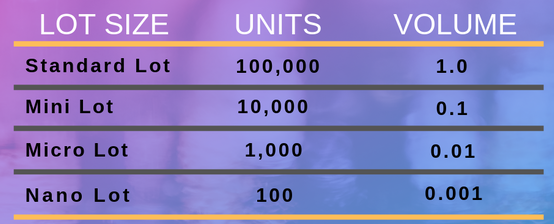
FE
What Is a Pip?
A pip, short for point in percentage, represents a tiny measure of the change in a currency pair in the forex market. Pips are the most basic unit of measure in forex trading. It can be measured in terms of the quote or in terms of the underlying currency. A pip is a standardized unit and is the smallest amount by which a currency quote can change. It is usually $0.0001 for U.S.-dollar related currency pairs, which is more commonly referred to as 1/100th of 1%, or one basis point. In practical terms, a pip is one-hundredth of one percent, or the fourth decimal place (0.0001). Most currency pairs are quoted to the fourth (sometimes fifth) decimal place. A pip represents the fourth number. Even though a pip is a very small unit of measurement, forex traders are usually heavily leveraged and even a one pip difference can equate to significant profit or loss.
A pip, short for point in percentage, represents a tiny measure of the change in a currency pair in the forex market. Pips are the most basic unit of measure in forex trading. It can be measured in terms of the quote or in terms of the underlying currency. A pip is a standardized unit and is the smallest amount by which a currency quote can change. It is usually $0.0001 for U.S.-dollar related currency pairs, which is more commonly referred to as 1/100th of 1%, or one basis point. In practical terms, a pip is one-hundredth of one percent, or the fourth decimal place (0.0001). Most currency pairs are quoted to the fourth (sometimes fifth) decimal place. A pip represents the fourth number. Even though a pip is a very small unit of measurement, forex traders are usually heavily leveraged and even a one pip difference can equate to significant profit or loss.
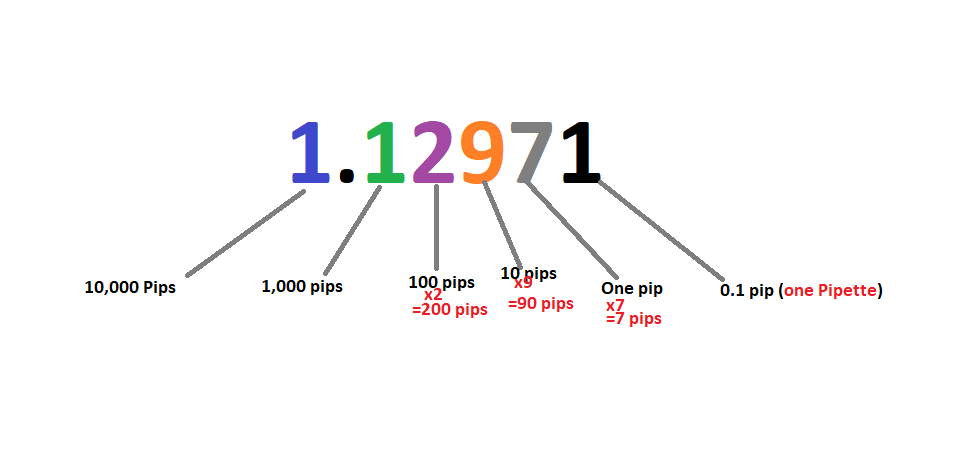
FE
What Are The Forex Market Sessions?
The forex market can be broken up into four major trading sessions: the Sydney session, the Tokyo session, the London session, and the New York session. The international currency market isn't dominated by a single market exchange but involves a global network of exchanges and brokers around the world. Forex trading hours are based on when trading is open in each participating country. Each session is 9 hours long. According to Central Daylight Time (CDT), here are the times for the Forex Market Sessions:
The forex market can be broken up into four major trading sessions: the Sydney session, the Tokyo session, the London session, and the New York session. The international currency market isn't dominated by a single market exchange but involves a global network of exchanges and brokers around the world. Forex trading hours are based on when trading is open in each participating country. Each session is 9 hours long. According to Central Daylight Time (CDT), here are the times for the Forex Market Sessions:
- New York Session (8AM to 5PM)
- Sydney Session (5PM to 2AM)
- Tokyo Session (7PM to 4AM)
- London Session (3AM to 12PM)
FE
What Is a Currency Pair?
A currency pair is the quotation of two different currencies, with the value of one currency being quoted against the other. The first listed currency of a currency pair is called the base currency, and the second currency is called the quote currency. The EUR/USD currency pair is considered the most liquid currency pair in the world. The USD/JPY is the second most popular currency pair in the world.
A currency pair is the quotation of two different currencies, with the value of one currency being quoted against the other. The first listed currency of a currency pair is called the base currency, and the second currency is called the quote currency. The EUR/USD currency pair is considered the most liquid currency pair in the world. The USD/JPY is the second most popular currency pair in the world.
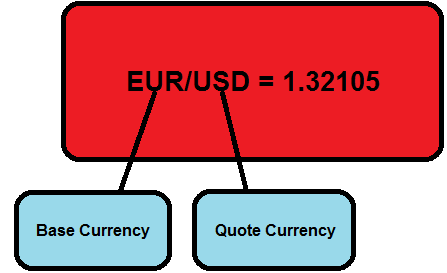
FE
What Is an Account Currency?
Account currency is simply the currency the brokerage account is recorded in. For example, as a forex trader, my account cash value is in USD. Typically, you open an account, deposit money denominated in your home country currency, and then buy and sell currency pairs. All your profits and losses will be converted into that particular currency.
Account currency is simply the currency the brokerage account is recorded in. For example, as a forex trader, my account cash value is in USD. Typically, you open an account, deposit money denominated in your home country currency, and then buy and sell currency pairs. All your profits and losses will be converted into that particular currency.
FE
What Is an Expert Advisor?
In the world of foreign exchange (forex) trading, an expert advisor (EA) is a piece of software that tells you when to make trades or even automatically initiates and executes trades according to preprogrammed instructions. Expert advisors are most often deployed on the MetaTrader 4 or 5 forex trading platforms. You can use an existing EA or create your own based on the trading parameters you like. These EAs are written in a programming language called MetaQuotes Language (MQL). Both MetaTrader and MQL were developed by MetaQuotes Software Corp.
In the world of foreign exchange (forex) trading, an expert advisor (EA) is a piece of software that tells you when to make trades or even automatically initiates and executes trades according to preprogrammed instructions. Expert advisors are most often deployed on the MetaTrader 4 or 5 forex trading platforms. You can use an existing EA or create your own based on the trading parameters you like. These EAs are written in a programming language called MetaQuotes Language (MQL). Both MetaTrader and MQL were developed by MetaQuotes Software Corp.
FE
What Is a Fractional Pip?
Fractional pips, known as "pipettes", exist to allow for tighter spreads. A fractional pip is equivalent to 1/10 of a pip, making it possible to view the EUR/USD currency pair with pipettes to five decimal places, while currency pairs with the yen as the quote currency to three decimal places.
Fractional pips, known as "pipettes", exist to allow for tighter spreads. A fractional pip is equivalent to 1/10 of a pip, making it possible to view the EUR/USD currency pair with pipettes to five decimal places, while currency pairs with the yen as the quote currency to three decimal places.

FE
What Is Pip Value?
In foreign exchange (forex) trading, pip value can be a confusing topic. A pip is a unit of measurement for currency movement and is the fourth decimal place in most currency pairs. For example, if the EUR/USD moves from 1.1015 to 1.1016, that's a one pip movement. Most brokers provide fractional pip pricing, so you'll also see a fifth decimal place such as in 1.10165, where the 5 is equal to five-tenths of a pip, or five pipettes. How much of a profit or loss a pip of movement produces depends on both the currency pair you are trading and the currency you funded your trading account with. Pip value matters because it affects risk. If you don't know what the pip value is, you can't precisely calculate the ideal position size for a trade and you may end up risking too much or too little on a trade.
The most heavily traded currency pairs in the world involve the U.S. dollar (USD). When USD is listed second in a pair, pip values are fixed and don't change if you have an account funded with U.S. dollars. The fixed pip amounts are: USD$10 for a standard lot, which is 100,000 units of currency. USD$1 for a mini lot, which is 10,000 units of currency. USD$0.10 for a micro lot, which is 1,000 units of currency. These pip values apply to any pair where the USD is listed second, such as the euro/U.S. dollar (EUR/USD), British pound/U.S. dollar (GBP/USD), Australian dollar/U.S. dollar (AUD/USD), and New Zealand dollar/ U.S. dollar (NZD/USD).
In foreign exchange (forex) trading, pip value can be a confusing topic. A pip is a unit of measurement for currency movement and is the fourth decimal place in most currency pairs. For example, if the EUR/USD moves from 1.1015 to 1.1016, that's a one pip movement. Most brokers provide fractional pip pricing, so you'll also see a fifth decimal place such as in 1.10165, where the 5 is equal to five-tenths of a pip, or five pipettes. How much of a profit or loss a pip of movement produces depends on both the currency pair you are trading and the currency you funded your trading account with. Pip value matters because it affects risk. If you don't know what the pip value is, you can't precisely calculate the ideal position size for a trade and you may end up risking too much or too little on a trade.
The most heavily traded currency pairs in the world involve the U.S. dollar (USD). When USD is listed second in a pair, pip values are fixed and don't change if you have an account funded with U.S. dollars. The fixed pip amounts are: USD$10 for a standard lot, which is 100,000 units of currency. USD$1 for a mini lot, which is 10,000 units of currency. USD$0.10 for a micro lot, which is 1,000 units of currency. These pip values apply to any pair where the USD is listed second, such as the euro/U.S. dollar (EUR/USD), British pound/U.S. dollar (GBP/USD), Australian dollar/U.S. dollar (AUD/USD), and New Zealand dollar/ U.S. dollar (NZD/USD).
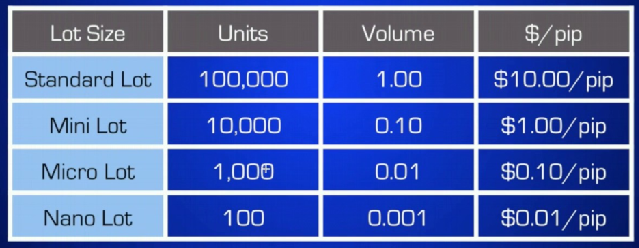
FE
What Is Cross Rate?
A cross rate is the currency exchange rate between two currencies (cross pair) when neither are the official currencies of the country in which the exchange rate quote is given. In practice, a cross rate (cross pair) is usually a currency pair that doesn't involve the U.S. dollar.
A cross rate is the currency exchange rate between two currencies (cross pair) when neither are the official currencies of the country in which the exchange rate quote is given. In practice, a cross rate (cross pair) is usually a currency pair that doesn't involve the U.S. dollar.
FE
What Are The Major Forex Pairs?
The four major currency pairs are the EUR/USD, USD/JPY, GBP/USD, and USD/CHF. These four major pairs are deliverable currencies and are part of the g10 currency group. While these currencies do a significant amount of volume related to economic transactions, they are some of the most heavily traded pairs in the world, along with the commodity currency pairs: USD/CAD, AUD/USD, and NZD/USD. The EUR/USD is by far the most heavily traded currency pair in the world and is popular among speculators due to its large daily volume.
The four major currency pairs are the EUR/USD, USD/JPY, GBP/USD, and USD/CHF. These four major pairs are deliverable currencies and are part of the g10 currency group. While these currencies do a significant amount of volume related to economic transactions, they are some of the most heavily traded pairs in the world, along with the commodity currency pairs: USD/CAD, AUD/USD, and NZD/USD. The EUR/USD is by far the most heavily traded currency pair in the world and is popular among speculators due to its large daily volume.
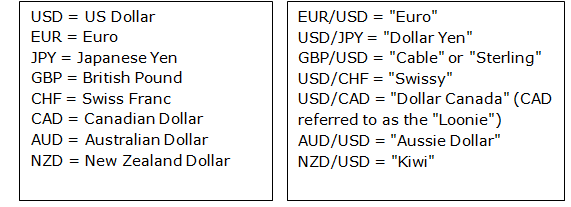
FE
Can You Trade Options In The Forex Market?
Yes! Forex options trade over-the-counter (OTC), and traders can choose prices and expiration dates which suit their hedging or profit strategy needs. Unlike futures, where the trader must fulfill the terms of the contract, options traders do not have that obligation at expiration. These options vary widely from one product to another depending on which entity is offering the option. Because of the risk of loss when writing options, most retail forex brokers do not allow traders to sell options contracts without high levels of capital for protection. Forex options come in two varieties, so-called vanilla options and SPOT options. SPOT options are binary in nature and pay out (or not) depending on the final condition of the option.
Yes! Forex options trade over-the-counter (OTC), and traders can choose prices and expiration dates which suit their hedging or profit strategy needs. Unlike futures, where the trader must fulfill the terms of the contract, options traders do not have that obligation at expiration. These options vary widely from one product to another depending on which entity is offering the option. Because of the risk of loss when writing options, most retail forex brokers do not allow traders to sell options contracts without high levels of capital for protection. Forex options come in two varieties, so-called vanilla options and SPOT options. SPOT options are binary in nature and pay out (or not) depending on the final condition of the option.
FE
What Is Single Payment Options Trading (SPOT)?
Single payment options trading (SPOT) is a type of option product that not only lets investors request that certain conditions be met in order to receive desired payouts, but also gives investors the opportunity to govern the size of payouts they wish to receive if said conditions are met. The broker providing SPOT products will determine the likelihood that the conditions will be met and charge commissions accordingly. This type of arrangement is often referred to as a "binary option" because only the following two types of payouts are possible for the investor: The conditions set out by both parties come to fruition, and the investor collects the agreed-upon payout amount. Or, the event does not occur as planned, and the investor loses the full premium paid to the broker. SPOT is most commonly found in Forex markets.
Single payment options trading (SPOT) is a type of option product that not only lets investors request that certain conditions be met in order to receive desired payouts, but also gives investors the opportunity to govern the size of payouts they wish to receive if said conditions are met. The broker providing SPOT products will determine the likelihood that the conditions will be met and charge commissions accordingly. This type of arrangement is often referred to as a "binary option" because only the following two types of payouts are possible for the investor: The conditions set out by both parties come to fruition, and the investor collects the agreed-upon payout amount. Or, the event does not occur as planned, and the investor loses the full premium paid to the broker. SPOT is most commonly found in Forex markets.
FE
What Is a Quote?
A forex quote is the price of one currency in terms of another currency. These quotes always involve currency pairs because you are buying one currency by selling another. For example, the price of one Euro may cost $1.1404 when viewing the EUR/USD currency pair.
A forex quote is the price of one currency in terms of another currency. These quotes always involve currency pairs because you are buying one currency by selling another. For example, the price of one Euro may cost $1.1404 when viewing the EUR/USD currency pair.
FE
What Is a Bond?
A bond is a fixed income instrument that represents a loan made by an investor to a borrower (typically corporate or governmental). A bond could be thought of as an I.O.U. between the lender and borrower that includes the details of the loan and its payments. Bonds are used by companies, municipalities, states, and sovereign governments to finance projects and operations. Owners of bonds are debtholders, or creditors, of the issuer. Bond details include the end date when the principal of the loan is due to be paid to the bond owner and usually includes the terms for variable or fixed interest payments made by the borrower.
Once again bonds are issued by governments and corporations when they want to raise money. By buying a bond, you're giving the issuer a loan, and they agree to pay you back the face value of the loan on a specific date, and to pay you periodic interest payments along the way, usually twice a year. There are two ways to make money by investing in bonds. The first is to hold those bonds until their maturity date and collect interest payments on them. Bond interest is usually paid twice a year. The second way to profit from bonds is to sell them at a price that's higher than what you pay initially.
A bond is a fixed income instrument that represents a loan made by an investor to a borrower (typically corporate or governmental). A bond could be thought of as an I.O.U. between the lender and borrower that includes the details of the loan and its payments. Bonds are used by companies, municipalities, states, and sovereign governments to finance projects and operations. Owners of bonds are debtholders, or creditors, of the issuer. Bond details include the end date when the principal of the loan is due to be paid to the bond owner and usually includes the terms for variable or fixed interest payments made by the borrower.
Once again bonds are issued by governments and corporations when they want to raise money. By buying a bond, you're giving the issuer a loan, and they agree to pay you back the face value of the loan on a specific date, and to pay you periodic interest payments along the way, usually twice a year. There are two ways to make money by investing in bonds. The first is to hold those bonds until their maturity date and collect interest payments on them. Bond interest is usually paid twice a year. The second way to profit from bonds is to sell them at a price that's higher than what you pay initially.
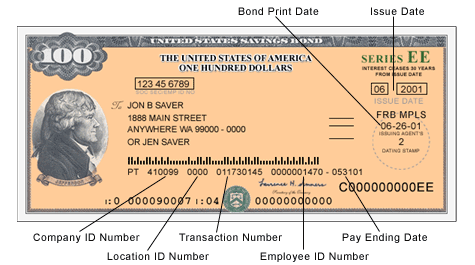
BO
What Is a Treasury Bond?
A Treasury bond (T-bond) is a government debt security issued by the federal government that earns interest until maturity, at which point the owner is also paid a par amount equal to the principal. United States Treasury securities are government debt instruments issued by the United States Department of the Treasury to finance government spending as an alternative to taxation. Treasury securities are often referred to simply as Treasurys.
A Treasury bond (T-bond) is a government debt security issued by the federal government that earns interest until maturity, at which point the owner is also paid a par amount equal to the principal. United States Treasury securities are government debt instruments issued by the United States Department of the Treasury to finance government spending as an alternative to taxation. Treasury securities are often referred to simply as Treasurys.

BO
What Is a Savings Bond?
A U.S. savings bond is a government bond that offers a fixed rate of interest over a fixed period of time. Many people find these bonds attractive because they are not subject to state or local income taxes. These bonds cannot easily be transferred and are non-negotiable.
When the government sells bonds, it is in effect taking a loan from the public, which it promises to pay back at some predetermined date in the future. As compensation for providing it with capital, the government makes interest payments to its bondholders.
A U.S. savings bond is a government bond that offers a fixed rate of interest over a fixed period of time. Many people find these bonds attractive because they are not subject to state or local income taxes. These bonds cannot easily be transferred and are non-negotiable.
When the government sells bonds, it is in effect taking a loan from the public, which it promises to pay back at some predetermined date in the future. As compensation for providing it with capital, the government makes interest payments to its bondholders.

BO
What Are TIPS?
Treasury Inflation-Protected Security (TIPS) is a Treasury bond that is indexed to an inflationary gauge to protect investors from the decline in the purchasing power of their money. The principal value of TIPS rises as inflation rises. Inflation is the pace at which prices increase throughout the U.S. economy as measured by the Consumer Price Index or CPI. Inflation becomes an issue when when there isn't a commensurate rise in real wage growth to offset the negative effects of rising prices. TIPS are issued with maturities of five, 10, and 30 years and are considered a low-risk investment because the U.S. government backs them. The principal amount is protected since investors will never receive less than the originally invested principal. You can buy Treasury Inflation-Protected Securities (TIPS) directly from the U.S. Treasury or through a bank, broker, or dealer.
Treasury Inflation-Protected Security (TIPS) is a Treasury bond that is indexed to an inflationary gauge to protect investors from the decline in the purchasing power of their money. The principal value of TIPS rises as inflation rises. Inflation is the pace at which prices increase throughout the U.S. economy as measured by the Consumer Price Index or CPI. Inflation becomes an issue when when there isn't a commensurate rise in real wage growth to offset the negative effects of rising prices. TIPS are issued with maturities of five, 10, and 30 years and are considered a low-risk investment because the U.S. government backs them. The principal amount is protected since investors will never receive less than the originally invested principal. You can buy Treasury Inflation-Protected Securities (TIPS) directly from the U.S. Treasury or through a bank, broker, or dealer.
BO
What Are The Differences Between Bonds, Notes, And Bills?
Technically, bills, notes, and bonds are all bonds. They are all backed by the full faith and credit of the U.S. government. They are all issued electronically (you don’t get a fancy piece of paper as you do with savings bonds). They can all be purchased either directly from the Treasury or through a broker.
The major difference among them is the time you need to wait to collect your principal:
Treasury bills have maturities of a year or less.
Treasury notes are issued with maturities from two to ten years.
Treasury bonds are long-term investments that have maturities of 10 to 30 years from their issue date.
The bills, like savings bonds, are sold at a discount from their face value. You get the full amount when the bill matures. The notes and bonds, on the other hand, are sold at their face value, have a fixed interest rate, and kick off interest payments once every six months. The minimum denomination for all three is $1,000, and you can buy them all in any increment of $1,000.
Technically, bills, notes, and bonds are all bonds. They are all backed by the full faith and credit of the U.S. government. They are all issued electronically (you don’t get a fancy piece of paper as you do with savings bonds). They can all be purchased either directly from the Treasury or through a broker.
The major difference among them is the time you need to wait to collect your principal:
Treasury bills have maturities of a year or less.
Treasury notes are issued with maturities from two to ten years.
Treasury bonds are long-term investments that have maturities of 10 to 30 years from their issue date.
The bills, like savings bonds, are sold at a discount from their face value. You get the full amount when the bill matures. The notes and bonds, on the other hand, are sold at their face value, have a fixed interest rate, and kick off interest payments once every six months. The minimum denomination for all three is $1,000, and you can buy them all in any increment of $1,000.
BO
What Is Term to Maturity?
A bond's term to maturity is the length of time during which the owner will receive interest payments on the investment. When the bond reaches maturity the principal is repaid. When the bond reaches maturity, the owner is repaid its par, or face, value. Also, the further a bond is from its maturity date, the larger the difference between its purchase price and its redemption value, which is also referred to as its principal, par, or face value.
A bond's term to maturity is the length of time during which the owner will receive interest payments on the investment. When the bond reaches maturity the principal is repaid. When the bond reaches maturity, the owner is repaid its par, or face, value. Also, the further a bond is from its maturity date, the larger the difference between its purchase price and its redemption value, which is also referred to as its principal, par, or face value.

BO
BO
What Is Maturity Date?
The maturity date is the date on which the principal amount of a note, draft, acceptance bond or other debt instrument becomes due. On this date, which is generally printed on the certificate of the instrument in question, the principal investment is repaid to the investor, while the interest payments that were regularly paid out during the life of the bond, cease to roll in. The maturity date also refers to the termination date (due date) on which an installment loan must be paid back in full.
The maturity date is the date on which the principal amount of a note, draft, acceptance bond or other debt instrument becomes due. On this date, which is generally printed on the certificate of the instrument in question, the principal investment is repaid to the investor, while the interest payments that were regularly paid out during the life of the bond, cease to roll in. The maturity date also refers to the termination date (due date) on which an installment loan must be paid back in full.
BO
What Are The Risks Of Investing In a Bond?
As an investor, you should be aware of some of the pitfalls that come with investing in the bond market. Although bonds are considered safe, there are pitfalls like interest rate risk — one of the primary risks associated with the bond market. Reinvestment risk means a bond or future cash flows will need to be reinvested in a security with a lower yield. Default risk occurs when the issuer can't pay the interest or principal in a timely manner or at all. Inflation risk occurs when the rate of price increases in the economy deteriorates the returns associated with the bond.
As an investor, you should be aware of some of the pitfalls that come with investing in the bond market. Although bonds are considered safe, there are pitfalls like interest rate risk — one of the primary risks associated with the bond market. Reinvestment risk means a bond or future cash flows will need to be reinvested in a security with a lower yield. Default risk occurs when the issuer can't pay the interest or principal in a timely manner or at all. Inflation risk occurs when the rate of price increases in the economy deteriorates the returns associated with the bond.
BO
What Is a Corporate Bond?
Corporate bonds are bonds issued by companies that want to raise additional cash. You can buy corporate bonds on the primary market through a brokerage firm, bank, bond trader, or a broker.
Corporate bonds are bonds issued by companies that want to raise additional cash. You can buy corporate bonds on the primary market through a brokerage firm, bank, bond trader, or a broker.
BO
What Is a Municipal Bond?
A municipal bond is a debt security issued by a state, municipality or county to finance its capital expenditures, including the construction of highways, bridges or schools. Municipal bonds are exempt from federal taxes and most state and local taxes, making them especially attractive to people in high income tax brackets.
A municipal bond is a debt security issued by a state, municipality or county to finance its capital expenditures, including the construction of highways, bridges or schools. Municipal bonds are exempt from federal taxes and most state and local taxes, making them especially attractive to people in high income tax brackets.
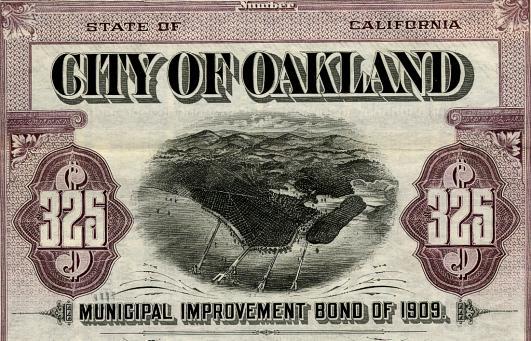
BO
What Is Cryptocurrency?
A cryptocurrency is a digital asset designed to work as a medium of exchange that uses strong cryptography to secure financial transactions, control the creation of additional units, and verify the transfer of assets.
A cryptocurrency is a digital asset designed to work as a medium of exchange that uses strong cryptography to secure financial transactions, control the creation of additional units, and verify the transfer of assets.
CC
What Is Bitcoin?
Bitcoin is a cryptocurrency. It is a decentralized digital currency without a central bank or single administrator that can be sent from user to user on the peer-to-peer bitcoin network without the need for intermediaries.
Bitcoin is a cryptocurrency. It is a decentralized digital currency without a central bank or single administrator that can be sent from user to user on the peer-to-peer bitcoin network without the need for intermediaries.

CC
What Is a Cryptocurrency Wallet?
A cryptocurrency wallet is a device, physical medium, program or a service which stores the public and/or private keys and can be used to track ownership, receive or spend cryptocurrencies. The cryptocurrency itself is not in the wallet. The wallet stores private and public keys, which are necessary to send and receive coins. There are hardware, software and paper wallets. Hardware and paper wallets are typically considered more secure than software wallets, although there are pros and cons associated with each. If you lose your private key and can’t access your wallet through back-up methods, you will never be able to recover your coins and they are effectively removed from circulation.
A cryptocurrency wallet is a device, physical medium, program or a service which stores the public and/or private keys and can be used to track ownership, receive or spend cryptocurrencies. The cryptocurrency itself is not in the wallet. The wallet stores private and public keys, which are necessary to send and receive coins. There are hardware, software and paper wallets. Hardware and paper wallets are typically considered more secure than software wallets, although there are pros and cons associated with each. If you lose your private key and can’t access your wallet through back-up methods, you will never be able to recover your coins and they are effectively removed from circulation.
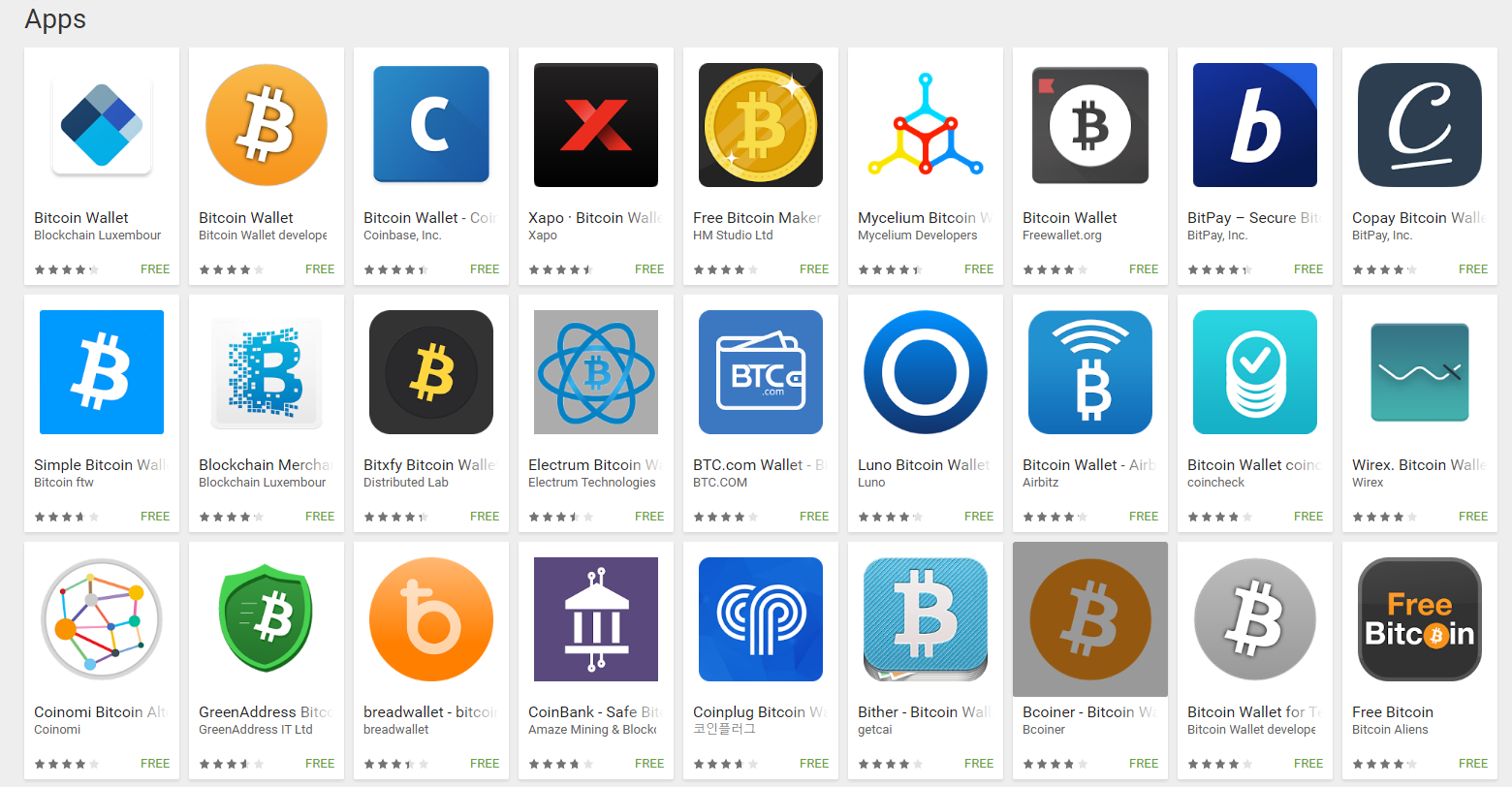
CC
What Is a Smart Contract?
A smart contract is a computer protocol intended to digitally facilitate, verify, or enforce the negotiation or performance of a contract. It is an agreement that is written in computer code and automatically executes when certain conditions are met. Some networks, most notably Ethereum, support smart contracts while others do not. Smart contracts allow the performance of credible transactions without third parties. These transactions are trackable and irreversible.
A smart contract is a computer protocol intended to digitally facilitate, verify, or enforce the negotiation or performance of a contract. It is an agreement that is written in computer code and automatically executes when certain conditions are met. Some networks, most notably Ethereum, support smart contracts while others do not. Smart contracts allow the performance of credible transactions without third parties. These transactions are trackable and irreversible.
CC
What Is an Initial Coin Offering (ICO)?
An ICO, also known as a token sale, is a means of crowdfunding where a company offers a new coin in exchange for fiat currency (U.S. dollars for example) or a digital currency (Bitcoin, Ether, Litecoin, etc.) Typically, the funds they received are used to develop the new concept, and the token they issued will be used to transact on their network once it is launched. Both China and South Korea have banned ICOs, and the SEC has stated that they could be considered the offer and sale of securities depending on the circumstances of the offering.
An ICO, also known as a token sale, is a means of crowdfunding where a company offers a new coin in exchange for fiat currency (U.S. dollars for example) or a digital currency (Bitcoin, Ether, Litecoin, etc.) Typically, the funds they received are used to develop the new concept, and the token they issued will be used to transact on their network once it is launched. Both China and South Korea have banned ICOs, and the SEC has stated that they could be considered the offer and sale of securities depending on the circumstances of the offering.
CC
What Is a Blockchain?
At its most basic level, blockchain is literally just a chain of blocks, but not in the traditional sense of those words. When we say the words “block” and “chain” in this context, we are actually talking about digital information (the “block”) stored in a public database (the “chain”). “Blocks” on the blockchain are made up of digital pieces of information. Blocks store information about transactions like the date, time, and dollar amount of your most recent purchase from Amazon. They store information about who is participating in transactions, and they also store information that distinguishes them from other blocks.
At its most basic level, blockchain is literally just a chain of blocks, but not in the traditional sense of those words. When we say the words “block” and “chain” in this context, we are actually talking about digital information (the “block”) stored in a public database (the “chain”). “Blocks” on the blockchain are made up of digital pieces of information. Blocks store information about transactions like the date, time, and dollar amount of your most recent purchase from Amazon. They store information about who is participating in transactions, and they also store information that distinguishes them from other blocks.

CC
What Is Hodl?
Hodl is slang in the cryptocurrency community for holding the cryptocurrency rather than selling it. A person who does this is known as a Hodler. It originated in a December 2013 post on the Bitcoin Forum message board by an apparently inebriated user who posted with a typo in the subject, "I AM HODLING."
Hodl is slang in the cryptocurrency community for holding the cryptocurrency rather than selling it. A person who does this is known as a Hodler. It originated in a December 2013 post on the Bitcoin Forum message board by an apparently inebriated user who posted with a typo in the subject, "I AM HODLING."

CC
What Is a Fork?
A fork in a blockchain can occur in any crypto-technology platform. You may think of the blocks in blockchains as cryptographic keys that move memory. Because the miners in a blockchain set the rules that move the memory in the network, these miners understand the new rules. However, all of the miners need to agree about the new rules and about what comprises a valid block in the chain. So when you want to change those rules you need to "fork it"—like a fork in a road—to indicate that there's been a change in or a diversion to the protocol. The developers can then update all of the software to reflect the new rules.
It is through this forking process that various digital currencies with names similar to bitcoin have come to be: bitcoin cash, bitcoin gold, and others. For the casual cryptocurrency investor, it can be difficult to tell the difference between these cryptocurrencies and to map the various forks onto a timeline.
A fork in a blockchain can occur in any crypto-technology platform. You may think of the blocks in blockchains as cryptographic keys that move memory. Because the miners in a blockchain set the rules that move the memory in the network, these miners understand the new rules. However, all of the miners need to agree about the new rules and about what comprises a valid block in the chain. So when you want to change those rules you need to "fork it"—like a fork in a road—to indicate that there's been a change in or a diversion to the protocol. The developers can then update all of the software to reflect the new rules.
It is through this forking process that various digital currencies with names similar to bitcoin have come to be: bitcoin cash, bitcoin gold, and others. For the casual cryptocurrency investor, it can be difficult to tell the difference between these cryptocurrencies and to map the various forks onto a timeline.
CC
What Is a Cryptocurrency Address?
A Bitcoin address is a unique identifier that serves as a virtual location where the cryptocurrency can be sent. People can send the cryptocurrency to Bitcoin addresses similarly to the way fiat currencies can often be sent to email addresses. However, the Bitcoin address is not intended to be permanent, but just a token for use in a single transaction. Unlike a digital wallet, a Bitcoin address cannot hold a balance. The address itself consists of 26-35 alphanumeric characters. This string is the public half of an asymmetric key pair. The standard format for a Bitcoin address is P2PKH (pay to public key hash).
A Bitcoin address is a unique identifier that serves as a virtual location where the cryptocurrency can be sent. People can send the cryptocurrency to Bitcoin addresses similarly to the way fiat currencies can often be sent to email addresses. However, the Bitcoin address is not intended to be permanent, but just a token for use in a single transaction. Unlike a digital wallet, a Bitcoin address cannot hold a balance. The address itself consists of 26-35 alphanumeric characters. This string is the public half of an asymmetric key pair. The standard format for a Bitcoin address is P2PKH (pay to public key hash).

CC
What Is an Altcoin?
Altcoins are the other cryptocurrencies launched after the success of Bitcoin. Generally, they sell themselves as better alternatives to Bitcoin. The term "altcoins" refers to all cryptocurrencies other than Bitcoin. As of early 2020, there were more than 5,000 cryptocurrencies by some estimates. According to CoinMarketCap, altcoins accounted for over 34% of the total cryptocurrency market in February 2020.
Altcoins are the other cryptocurrencies launched after the success of Bitcoin. Generally, they sell themselves as better alternatives to Bitcoin. The term "altcoins" refers to all cryptocurrencies other than Bitcoin. As of early 2020, there were more than 5,000 cryptocurrencies by some estimates. According to CoinMarketCap, altcoins accounted for over 34% of the total cryptocurrency market in February 2020.
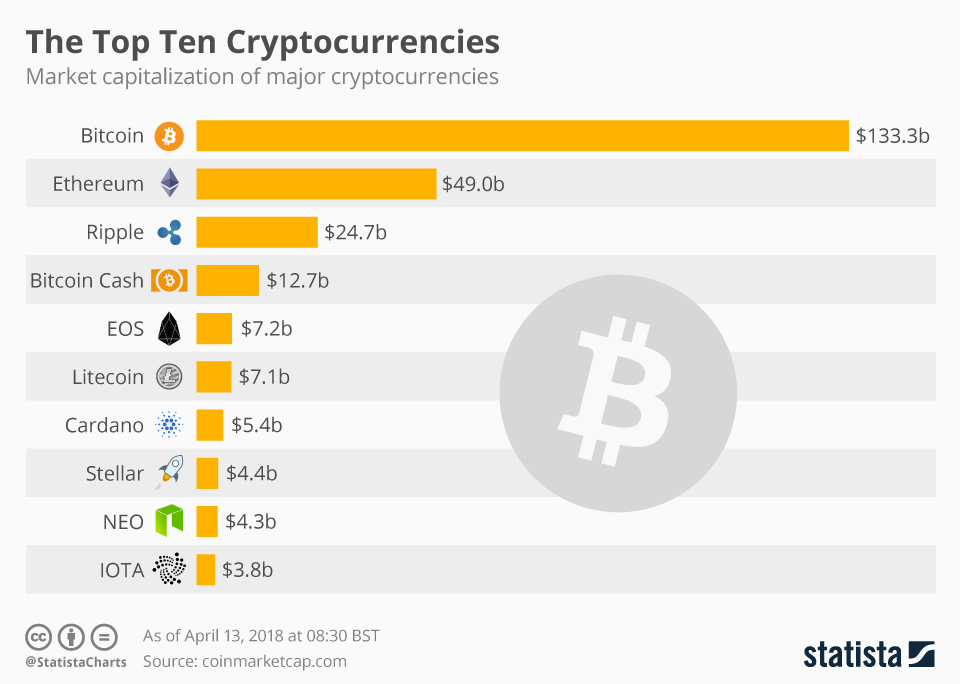
CC
What Is a Hardware Cryptocurrency Wallet?
A hardware wallet is a special type of bitcoin wallet which stores the user's private keys in a secure hardware device. They have major advantages over standard software wallets: private keys are often stored in a protected area of a microcontroller, and cannot be transferred out of the device in plaintext.
A hardware wallet is a special type of bitcoin wallet which stores the user's private keys in a secure hardware device. They have major advantages over standard software wallets: private keys are often stored in a protected area of a microcontroller, and cannot be transferred out of the device in plaintext.
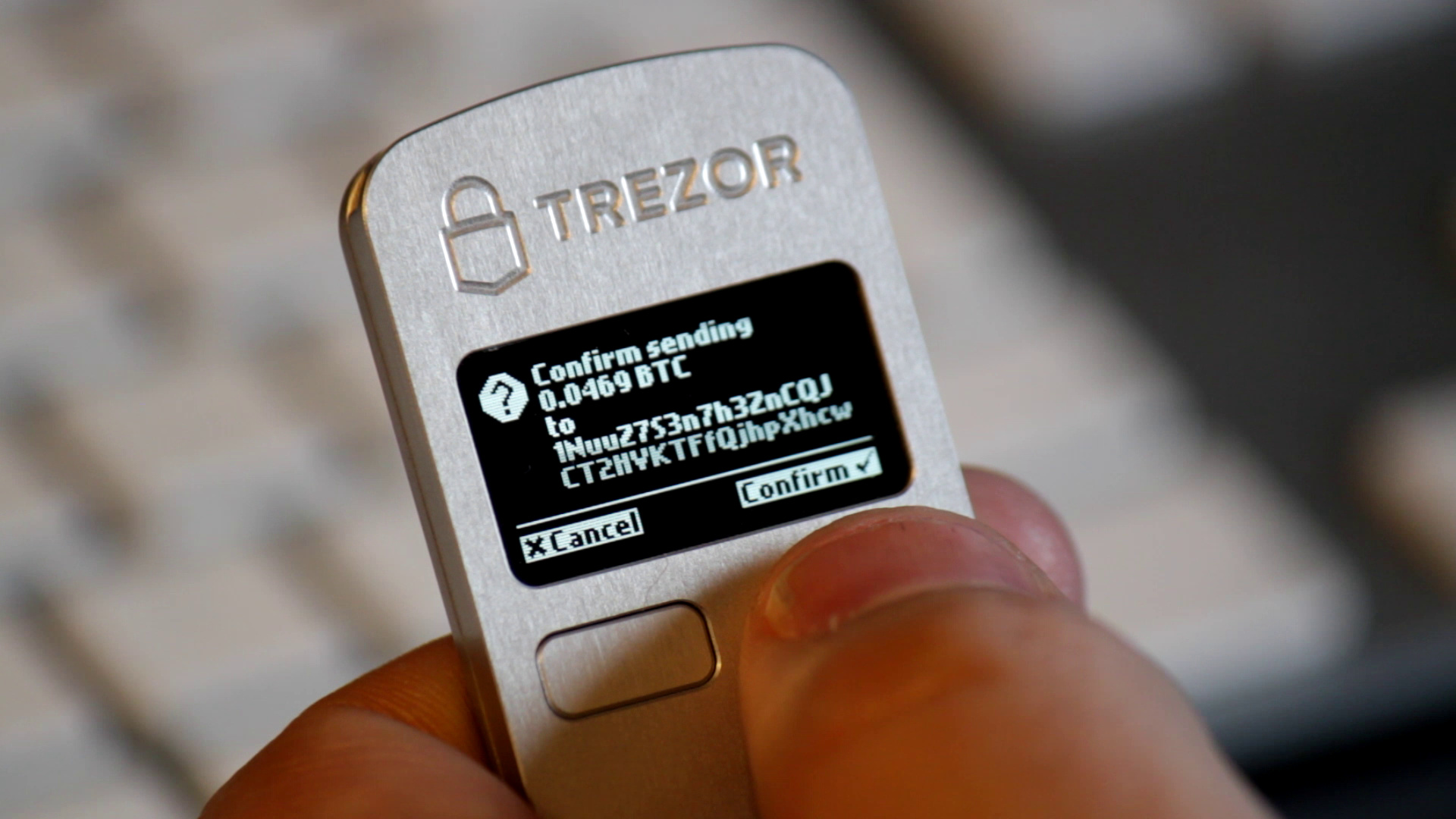
CC
BP: Immense Upside Potential Even If Dividends Are Temporarily Suspended
What Are Dividend Aristocrats?
A Dividend Aristocrat is a company in the S&P 500 that has paid and increased its base dividend every year for at least 25 consecutive years. S&P Dow Jones Indices, which owns the S&P 500 index, reviews the list of qualifying companies every year and updates the list of companies that carry Dividend Aristocrat status. Their impressive track records of dividend growth make Dividend Aristocrats some of the most attractive dividend stocks to own.
A Dividend Aristocrat is a company in the S&P 500 that has paid and increased its base dividend every year for at least 25 consecutive years. S&P Dow Jones Indices, which owns the S&P 500 index, reviews the list of qualifying companies every year and updates the list of companies that carry Dividend Aristocrat status. Their impressive track records of dividend growth make Dividend Aristocrats some of the most attractive dividend stocks to own.
DI
What Is Trading?
Trading involves more frequent transactions, such as the buying and selling of stocks, commodities, currency pairs, or other instruments. While investors may be content with annual returns of 10% to 15%, traders might seek a 10% return each month. Trading involves short-term strategies to maximize returns daily, monthly, or quarterly. The goal is to generate returns that outperform buy-and-hold investing. Long term investors are more likely to ride out short-term losses, while traders will attempt to make transactions that can help them profit quickly from fluctuating markets.
Trading involves more frequent transactions, such as the buying and selling of stocks, commodities, currency pairs, or other instruments. While investors may be content with annual returns of 10% to 15%, traders might seek a 10% return each month. Trading involves short-term strategies to maximize returns daily, monthly, or quarterly. The goal is to generate returns that outperform buy-and-hold investing. Long term investors are more likely to ride out short-term losses, while traders will attempt to make transactions that can help them profit quickly from fluctuating markets.
TR
What Are The Types of Traders?
A trader's style refers to the timeframe or holding period in which stocks, commodities, or other trading instruments are bought and sold. Traders generally fall into one of four categories:
Position Trader: Positions are held from months to years.
Swing Trader: Positions are held from days to weeks.
Day Trader: Positions are held throughout the day only with no overnight positions.
Scalp Trader: Positions are held for seconds to minutes with no overnight positions.
A trader's style refers to the timeframe or holding period in which stocks, commodities, or other trading instruments are bought and sold. Traders generally fall into one of four categories:
Position Trader: Positions are held from months to years.
Swing Trader: Positions are held from days to weeks.
Day Trader: Positions are held throughout the day only with no overnight positions.
Scalp Trader: Positions are held for seconds to minutes with no overnight positions.
TR
What Is Support & Resistance (S&R)?
Resistance: price level where an up trend can be expected to pause due to sell off in the stock. When the stock supply and demand hit equilibrium, the price stops rising... thus forming resistance.
Support: price level where a down trend can be expected to pause due to a concentration of demand. As the stock drops, demand increases. When it hits equilibrium, the price stops dropping... thus forming support.
Resistance: price level where an up trend can be expected to pause due to sell off in the stock. When the stock supply and demand hit equilibrium, the price stops rising... thus forming resistance.
Support: price level where a down trend can be expected to pause due to a concentration of demand. As the stock drops, demand increases. When it hits equilibrium, the price stops dropping... thus forming support.

TR
What Is the Bid Ask Spread?
The bid–ask spread, is the difference between the prices quoted for an immediate sale and an immediate purchase for stocks, futures contracts, options, or currency pairs. The size of the bid–ask spread in a security is one measure of the liquidity of the market and of the size of the transaction cost.
The bid–ask spread, is the difference between the prices quoted for an immediate sale and an immediate purchase for stocks, futures contracts, options, or currency pairs. The size of the bid–ask spread in a security is one measure of the liquidity of the market and of the size of the transaction cost.
TR
What Is an IOU?
An IOU is usually an informal document acknowledging debt. An IOU differs from a promissory note in that an IOU is not a negotiable instrument and does not specify repayment terms such as the time of repayment. IOUs usually specify the debtor, the amount owed, and sometimes the creditor. IOU meaning I Owe You.
An IOU is usually an informal document acknowledging debt. An IOU differs from a promissory note in that an IOU is not a negotiable instrument and does not specify repayment terms such as the time of repayment. IOUs usually specify the debtor, the amount owed, and sometimes the creditor. IOU meaning I Owe You.
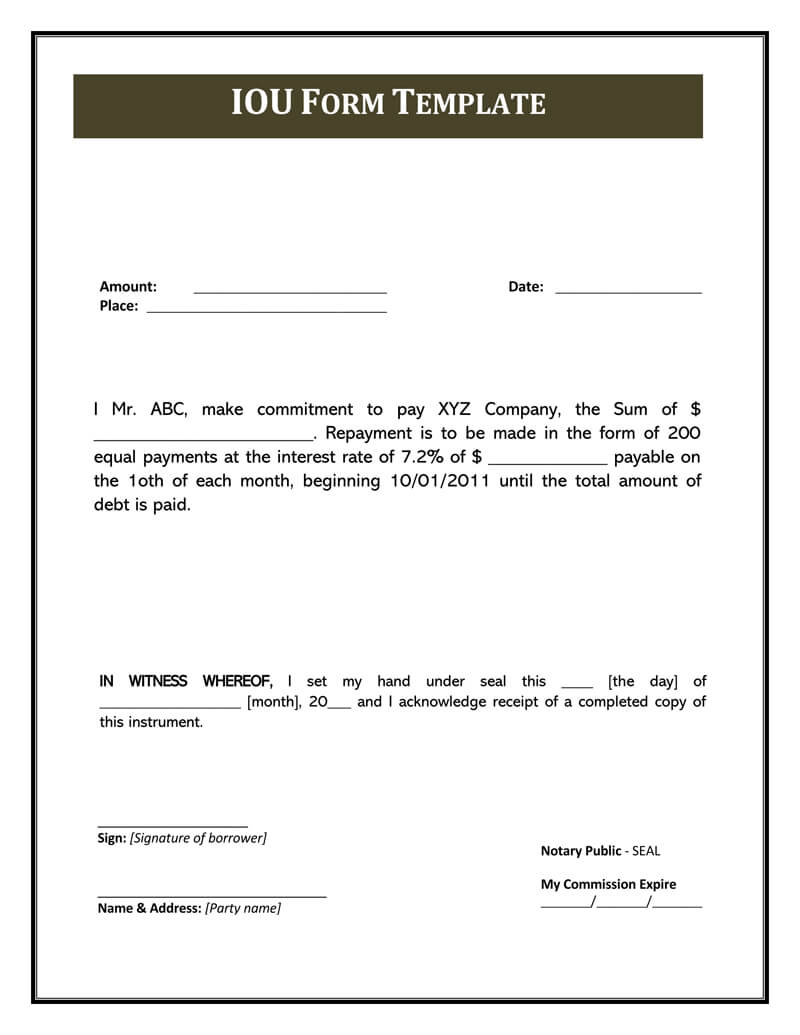
FI
What Is Compound Interest?
Compound interest is the addition of interest to the principal sum of a loan or deposit, or in other words, interest on interest. It is the result of reinvesting interest, rather than paying it out, so that interest in the next period is then earned on the principal sum plus previously accumulated interest.
Compound interest is the addition of interest to the principal sum of a loan or deposit, or in other words, interest on interest. It is the result of reinvesting interest, rather than paying it out, so that interest in the next period is then earned on the principal sum plus previously accumulated interest.
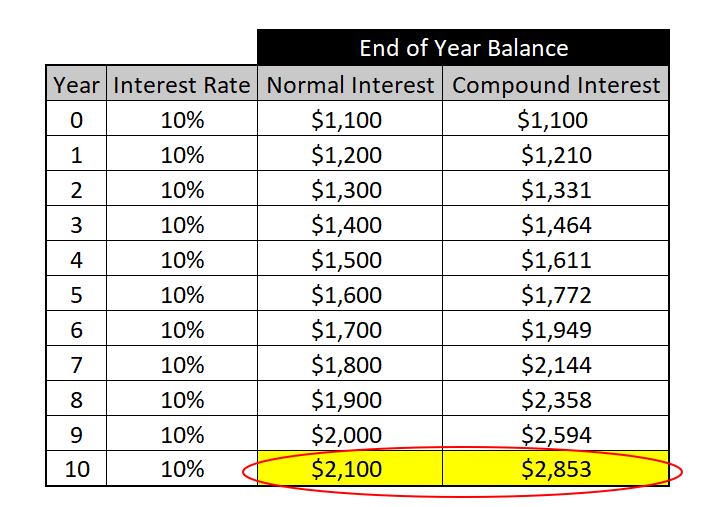
FI
What Are Futures?
Futures are derivative financial contracts that obligate the parties to transact an asset at a predetermined future date and price. Here, the buyer must purchase or the seller must sell the underlying asset at the set price, regardless of the current market price at the expiration date. Underlying assets include physical commodities or other financial instruments. Futures contracts detail the quantity of the underlying asset and are standardized to facilitate trading on a futures exchange. Futures can be used for hedging or trade speculation.
Futures are derivative financial contracts that obligate the parties to transact an asset at a predetermined future date and price. Here, the buyer must purchase or the seller must sell the underlying asset at the set price, regardless of the current market price at the expiration date. Underlying assets include physical commodities or other financial instruments. Futures contracts detail the quantity of the underlying asset and are standardized to facilitate trading on a futures exchange. Futures can be used for hedging or trade speculation.
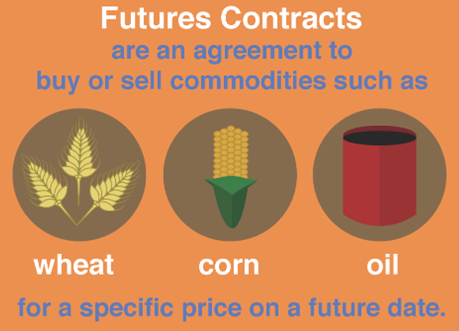
FU
What Are Stock (Market) Futures?
Stock market futures, also called market futures or equity index futures, are futures contracts that track a specific benchmark index like the S&P 500. While commodity futures require delivery of the underlying goods (IE: corn, sugar, crude oil), market futures contracts get settled with cash or get rolled over. Market futures allow traders to trade the direction of the underlying equity index, hedge equity positions and be used as a lead indicator for the markets and stocks. Unlike options that can expire worthless when out of the money, expiring market futures are rolled over into the next expiration month contract. Market futures contracts expire on the third Friday of each quarterly month, starting from March. Expiring contracts are rolled over to the next expiration month on the second Thursday of the week.
Stock market futures, also called market futures or equity index futures, are futures contracts that track a specific benchmark index like the S&P 500. While commodity futures require delivery of the underlying goods (IE: corn, sugar, crude oil), market futures contracts get settled with cash or get rolled over. Market futures allow traders to trade the direction of the underlying equity index, hedge equity positions and be used as a lead indicator for the markets and stocks. Unlike options that can expire worthless when out of the money, expiring market futures are rolled over into the next expiration month contract. Market futures contracts expire on the third Friday of each quarterly month, starting from March. Expiring contracts are rolled over to the next expiration month on the second Thursday of the week.
FU
What Is a Commodity?
A commodity is a basic good used in commerce that is interchangeable with other commodities of the same type. It is a raw material or primary agricultural product that can be bought and sold, such as copper or coffee. Commodities are most often used as inputs in the production of other goods or services. Investors and traders can buy and sell commodities directly in the spot (cash) market or via derivatives such as futures and options. Owning commodities in a broader portfolio is encouraged as a diversifier and a hedge against inflation.
A commodity is a basic good used in commerce that is interchangeable with other commodities of the same type. It is a raw material or primary agricultural product that can be bought and sold, such as copper or coffee. Commodities are most often used as inputs in the production of other goods or services. Investors and traders can buy and sell commodities directly in the spot (cash) market or via derivatives such as futures and options. Owning commodities in a broader portfolio is encouraged as a diversifier and a hedge against inflation.

FU
What Is a Delivery Date?
A delivery date is the final date by which the underlying commodity for a futures or forward contract must be delivered for the terms of the contract to be fulfilled. Most futures contracts are used as a hedge to reduce the risk of adverse price movements in a commodity and are closed out with an offsetting position (selling to offset a long position and buying to offset a short position) before the actual delivery date.
A delivery date is the final date by which the underlying commodity for a futures or forward contract must be delivered for the terms of the contract to be fulfilled. Most futures contracts are used as a hedge to reduce the risk of adverse price movements in a commodity and are closed out with an offsetting position (selling to offset a long position and buying to offset a short position) before the actual delivery date.
FU
What Is a Forward Contract?
Unlike standard futures contracts, a forward contract can be customized to a commodity, amount and delivery date. Commodities traded can be grains, precious metals, natural gas, oil, or even poultry. A forward contract settlement can occur on a cash or delivery basis. Forward contracts do not trade on a centralized exchange and are therefore regarded as over-the-counter (OTC) instruments. While their OTC nature makes it easier to customize terms, the lack of a centralized clearinghouse also gives rise to a higher degree of default risk. As a result, forward contracts are not as easily available to the retail investor as futures contracts.
Unlike standard futures contracts, a forward contract can be customized to a commodity, amount and delivery date. Commodities traded can be grains, precious metals, natural gas, oil, or even poultry. A forward contract settlement can occur on a cash or delivery basis. Forward contracts do not trade on a centralized exchange and are therefore regarded as over-the-counter (OTC) instruments. While their OTC nature makes it easier to customize terms, the lack of a centralized clearinghouse also gives rise to a higher degree of default risk. As a result, forward contracts are not as easily available to the retail investor as futures contracts.
FU
What Is Backwardation?
Backwardation is when the current price of an underlying asset is higher than prices trading in the futures market. Backwardation can occur as a result of a higher demand for an asset currently than the contracts maturing in the coming months through the futures market. Traders use backwardation to make a profit by selling short at the current price and buy at the lower futures price. Backwardation is sometimes confused with an inverted futures curve. In essence, a futures market expects higher prices at longer maturities and lower prices as you move closer to the present day when you converge at the present spot price.
Backwardation is when the current price of an underlying asset is higher than prices trading in the futures market. Backwardation can occur as a result of a higher demand for an asset currently than the contracts maturing in the coming months through the futures market. Traders use backwardation to make a profit by selling short at the current price and buy at the lower futures price. Backwardation is sometimes confused with an inverted futures curve. In essence, a futures market expects higher prices at longer maturities and lower prices as you move closer to the present day when you converge at the present spot price.
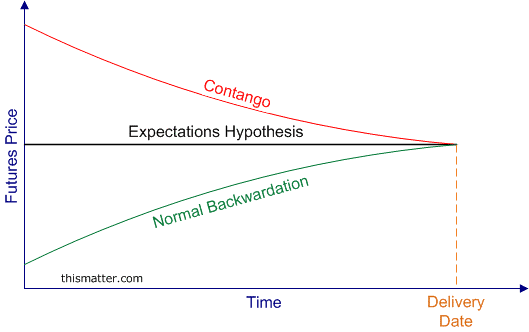
FU
What Is a Clearinghouse?
Clearing houses provide clearing and settlement services for futures traded at an exchange. They act as the neutral counterparty between every buyer and seller, ensuring the soundness and integrity of every trade. Clearing is a fundamental benefit in the futures markets. Long before a trade is cleared through a clearing house, clearing firms check the financial strength of both parties to the trade, whether they’re a big institution or an individual trader.
They also provide access to trading platforms, where the buyer and seller agree on the price, quantity and maturity of the contract. Then, when the contract is cleared by matching these offsetting (one buy, one sell) positions together, the clearing house guarantees that both buyer and seller get paid. This offsetting or “netting” process takes risk out of the financial system as a whole.
Clearing houses provide clearing and settlement services for futures traded at an exchange. They act as the neutral counterparty between every buyer and seller, ensuring the soundness and integrity of every trade. Clearing is a fundamental benefit in the futures markets. Long before a trade is cleared through a clearing house, clearing firms check the financial strength of both parties to the trade, whether they’re a big institution or an individual trader.
They also provide access to trading platforms, where the buyer and seller agree on the price, quantity and maturity of the contract. Then, when the contract is cleared by matching these offsetting (one buy, one sell) positions together, the clearing house guarantees that both buyer and seller get paid. This offsetting or “netting” process takes risk out of the financial system as a whole.
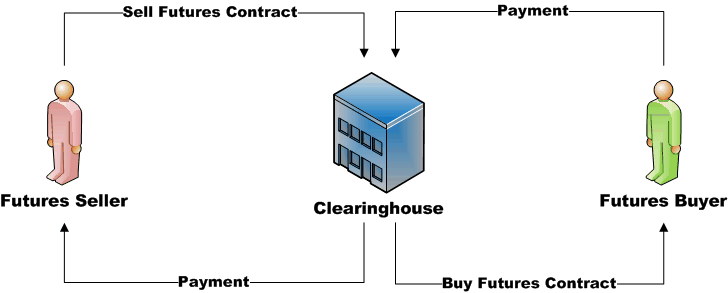
FU
What Is Contango?
The opposite of backwardation is contango, where the futures contract price is higher than the expected price at some future expiration. Again, contango is a situation where the futures price of a commodity is higher than the spot price. It usually occurs when an asset price is expected to rise over time. In all futures market scenarios, the futures prices will usually converge toward the spot prices as the contracts approach expiration. Contango tends to cause losses for investors in commodity ETFs that use futures contracts, but these losses can be avoided by buying ETFs that hold actual commodities.
The opposite of backwardation is contango, where the futures contract price is higher than the expected price at some future expiration. Again, contango is a situation where the futures price of a commodity is higher than the spot price. It usually occurs when an asset price is expected to rise over time. In all futures market scenarios, the futures prices will usually converge toward the spot prices as the contracts approach expiration. Contango tends to cause losses for investors in commodity ETFs that use futures contracts, but these losses can be avoided by buying ETFs that hold actual commodities.
FU
What Are Forward Curves?
The forward curve is a function graph in finance that defines the prices at which a contract for future delivery or payment can be concluded today. For example, a futures contract forward curve is prices being plotted as a function of the amount of time between now and the expiry date of the futures contract (with the spot price being the price at time zero). The forward curve represents a term structure of prices.
The forward curve is a function graph in finance that defines the prices at which a contract for future delivery or payment can be concluded today. For example, a futures contract forward curve is prices being plotted as a function of the amount of time between now and the expiry date of the futures contract (with the spot price being the price at time zero). The forward curve represents a term structure of prices.
FU
What Is a Delivery Month (Contract Month)?
The term delivery month refers to a key characteristic of a futures contract that designates when the contract expires, and when the underlying asset must be delivered or settled. Delivery dates are displayed by exchanges. The exchange on which the futures contract is traded establishes a delivery location and the date within the delivery month when the delivery can take place. Not all futures contracts require physical delivery of a commodity, and many are settled in cash. The delivery month is also called the contract month.Traders must exit their position as close to the delivery month as possible otherwise they must take delivery of the commodity.
The term delivery month refers to a key characteristic of a futures contract that designates when the contract expires, and when the underlying asset must be delivered or settled. Delivery dates are displayed by exchanges. The exchange on which the futures contract is traded establishes a delivery location and the date within the delivery month when the delivery can take place. Not all futures contracts require physical delivery of a commodity, and many are settled in cash. The delivery month is also called the contract month.Traders must exit their position as close to the delivery month as possible otherwise they must take delivery of the commodity.

FU
What Is a First Notice Day (FND)?
In futures trading, the first day of a delivery month on which notices can be issued by the sellers to the clearing house and by the clearing house to the buyers indicating that the sellers intend to deliver (the financial instruments or physical commodities) in fulfillment of their futures contracts. In practice, most derivatives traders close out or roll over their expiring positions to avoid the prospect of physical delivery.
If the first business day of the delivery month was Monday, Oct. 1, first notice day would typically fall one to three business days prior, so it could be Wednesday, Sept. 26, Thursday, Sept.27, or Friday, Sept. 28. Most investors close out their positions before first notice day because they don't want to own physical commodities. According to Futures Magazine, less than 1% of futures contracts actually go to physical delivery.
In futures trading, the first day of a delivery month on which notices can be issued by the sellers to the clearing house and by the clearing house to the buyers indicating that the sellers intend to deliver (the financial instruments or physical commodities) in fulfillment of their futures contracts. In practice, most derivatives traders close out or roll over their expiring positions to avoid the prospect of physical delivery.
If the first business day of the delivery month was Monday, Oct. 1, first notice day would typically fall one to three business days prior, so it could be Wednesday, Sept. 26, Thursday, Sept.27, or Friday, Sept. 28. Most investors close out their positions before first notice day because they don't want to own physical commodities. According to Futures Magazine, less than 1% of futures contracts actually go to physical delivery.
FU
What Is Convergence?
Convergence is the movement of the price of a futures contract toward the spot price of the underlying cash commodity as the delivery date approaches. It simply means that, on the last day that a futures contract can be delivered to fulfill the terms of the contract, the price of the futures and the price of the underlying commodity will be nearly equal. The two prices must converge. If not, an arbitrage opportunity exists and the possibility for a risk-free profit.
Convergence is the movement of the price of a futures contract toward the spot price of the underlying cash commodity as the delivery date approaches. It simply means that, on the last day that a futures contract can be delivered to fulfill the terms of the contract, the price of the futures and the price of the underlying commodity will be nearly equal. The two prices must converge. If not, an arbitrage opportunity exists and the possibility for a risk-free profit.
FU
What Is P/L Open & P/L Day?
P/L stands for Profit/Loss. P/L Day is the amount of money made or lost on your position from last night's close to the current mark plus any intra-day profit and loss. P/L Open is the amount of money made or lost on your position since the inception of the trade.
P/L stands for Profit/Loss. P/L Day is the amount of money made or lost on your position from last night's close to the current mark plus any intra-day profit and loss. P/L Open is the amount of money made or lost on your position since the inception of the trade.
TR
What Is Economics?
In its most simple and concise definition, economics is the study of how society uses its limited resources. Economics is the social science that studies the production, distribution, and consumption of goods and services. Economics focuses on the behaviour and interactions of economic agents and how economies work.
In its most simple and concise definition, economics is the study of how society uses its limited resources. Economics is the social science that studies the production, distribution, and consumption of goods and services. Economics focuses on the behaviour and interactions of economic agents and how economies work.
EC
What Is a Stimulus Package?
A stimulus package is a package of economic measures put together by a government to stimulate a floundering economy. The objective of a stimulus package is to reinvigorate the economy and prevent or reverse a recession by boosting employment and spending.
A stimulus package is a package of economic measures put together by a government to stimulate a floundering economy. The objective of a stimulus package is to reinvigorate the economy and prevent or reverse a recession by boosting employment and spending.
EC
What Is a Supply Chain?
A supply chain is a network between a company and its suppliers to produce and distribute a specific product to the final buyer. This network includes different activities, people, entities, information, and resources. The entities in the supply chain include producers, vendors, warehouses, transportation companies, distribution centers, and retailers. The supply chain also represents the steps it takes to get the product or service from its original state to the customer. The functions in a supply chain include product development, marketing, operations, distribution, finance, and customer service. Supply chain management results in lower costs and a faster production cycle.
A supply chain is a network between a company and its suppliers to produce and distribute a specific product to the final buyer. This network includes different activities, people, entities, information, and resources. The entities in the supply chain include producers, vendors, warehouses, transportation companies, distribution centers, and retailers. The supply chain also represents the steps it takes to get the product or service from its original state to the customer. The functions in a supply chain include product development, marketing, operations, distribution, finance, and customer service. Supply chain management results in lower costs and a faster production cycle.

EC
What Exactly Is Capital Gain?
Capital gain is a rise in the value of a capital asset (investment or real estate) that gives it a higher worth than the purchase price. The gain is not realized until the asset is sold. A capital gain may be short-term (one year or less) or long-term (more than one year) and must be claimed on income taxes.
Capital gain is a rise in the value of a capital asset (investment or real estate) that gives it a higher worth than the purchase price. The gain is not realized until the asset is sold. A capital gain may be short-term (one year or less) or long-term (more than one year) and must be claimed on income taxes.
FI
What Is a Margin Account?
A margin account is a brokerage account in which the broker lends the investor money to buy more securities than what they could otherwise buy with the balance in their account. Using margin to purchase securities is effectively like using the current cash or securities already in your account as collateral for a loan.
A margin account is a brokerage account in which the broker lends the investor money to buy more securities than what they could otherwise buy with the balance in their account. Using margin to purchase securities is effectively like using the current cash or securities already in your account as collateral for a loan.
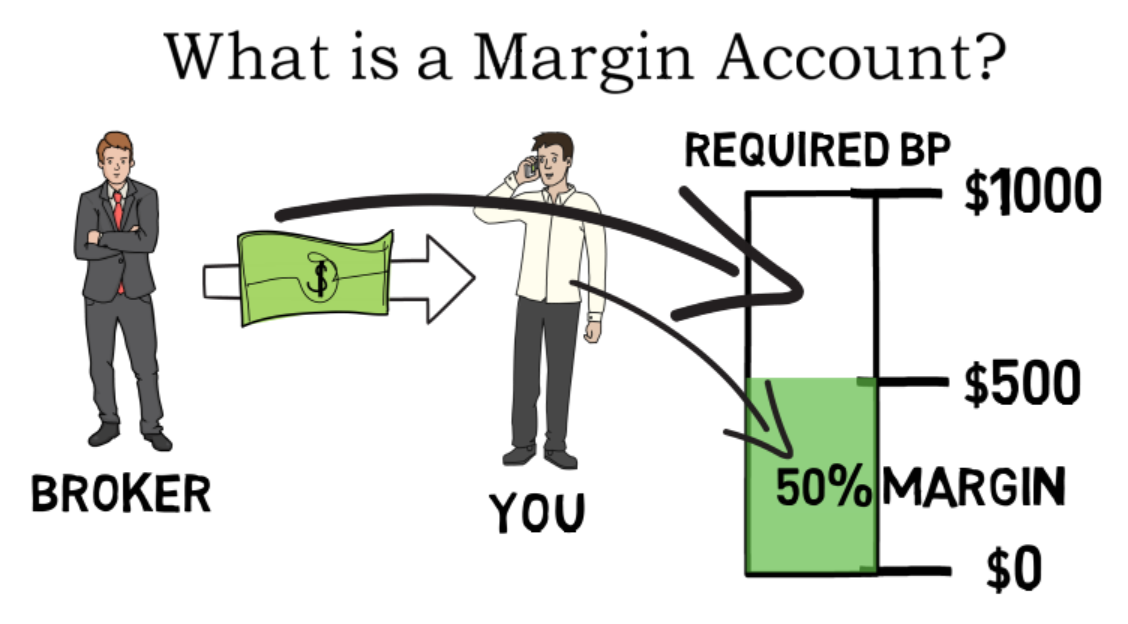
TR
What Is Open Interest?
Open interest is the total number of outstanding derivative contracts, such as options or futures that have not been settled for an asset. The total open interest does not count, and total every buy and sell contract. Instead, open interest provides a more accurate picture of the options trading activity, and whether money flows into the futures and options market are increasing or decreasing.
Open interest is the total number of outstanding derivative contracts, such as options or futures that have not been settled for an asset. The total open interest does not count, and total every buy and sell contract. Instead, open interest provides a more accurate picture of the options trading activity, and whether money flows into the futures and options market are increasing or decreasing.
OP
40 Things Every Dividend Investor Should Know
What Is Included In Investment Portfolios?
A portfolio investment is ownership of a stock, bond, or other financial asset with the expectation that it will earn a return or grow in value over time, or both. It entails passive or hands-off ownership of assets as opposed to direct investment, which would involve an active management role. In fact, a portfolio investment can be any possession that is purchased for the purpose of generating a return in the short or long term.
A portfolio investment is ownership of a stock, bond, or other financial asset with the expectation that it will earn a return or grow in value over time, or both. It entails passive or hands-off ownership of assets as opposed to direct investment, which would involve an active management role. In fact, a portfolio investment can be any possession that is purchased for the purpose of generating a return in the short or long term.
FI
What Is a Holder?
Refers to the investor who owns an options contract. A call holder pays for the option to buy the stock based on the parameters of the contract. A put holder has the right to sell the stock.
Holders are purchasing the right to buy or sell shares, but they aren’t obligated to do anything. Their contract grants them the freedom to decide when — or if — to exercise the option, or to sell the contract before it expires. If they end up with an out-of-the-money option, they can walk away and let the contract expire. They lose only the amount they paid for the option (the premium) plus the cost of trade commissions.
Refers to the investor who owns an options contract. A call holder pays for the option to buy the stock based on the parameters of the contract. A put holder has the right to sell the stock.
Holders are purchasing the right to buy or sell shares, but they aren’t obligated to do anything. Their contract grants them the freedom to decide when — or if — to exercise the option, or to sell the contract before it expires. If they end up with an out-of-the-money option, they can walk away and let the contract expire. They lose only the amount they paid for the option (the premium) plus the cost of trade commissions.
OP
What Is a Writer?
Refers to the investor who is selling the options contract. The writer receives the premium from the holder in exchange for the promise to buy or sell the specified shares at the strike price, if the holder exercises the option.
Writers don’t have much flexibility compared to Holders. For example, when a call holder decides to exercise an option, the writer is obligated to fulfill the order and sell the stock at the strike price. If the writer doesn’t already own enough shares of the stock, he’ll have to buy shares at the going market price — even if it’s higher than the strike price — and sell them at a loss to the call holder.
Refers to the investor who is selling the options contract. The writer receives the premium from the holder in exchange for the promise to buy or sell the specified shares at the strike price, if the holder exercises the option.
Writers don’t have much flexibility compared to Holders. For example, when a call holder decides to exercise an option, the writer is obligated to fulfill the order and sell the stock at the strike price. If the writer doesn’t already own enough shares of the stock, he’ll have to buy shares at the going market price — even if it’s higher than the strike price — and sell them at a loss to the call holder.
OP
What Is FDIC Insurance Coverage?
The Federal Deposit Insurance Corporation (FDIC) is an independent agency of the United States government that protects the funds depositors place in banks and savings associations. FDIC insurance is backed by the full faith and credit of the United States government. Since the FDIC was established in 1933, no depositor has lost a penny of FDIC-insured funds.
The standard deposit insurance coverage limit is $250,000 per depositor, per FDIC-insured bank, per ownership category. Deposits held in different ownership categories are separately insured, up to at least $250,000, even if held at the same bank.
The Federal Deposit Insurance Corporation (FDIC) is an independent agency of the United States government that protects the funds depositors place in banks and savings associations. FDIC insurance is backed by the full faith and credit of the United States government. Since the FDIC was established in 1933, no depositor has lost a penny of FDIC-insured funds.
The standard deposit insurance coverage limit is $250,000 per depositor, per FDIC-insured bank, per ownership category. Deposits held in different ownership categories are separately insured, up to at least $250,000, even if held at the same bank.
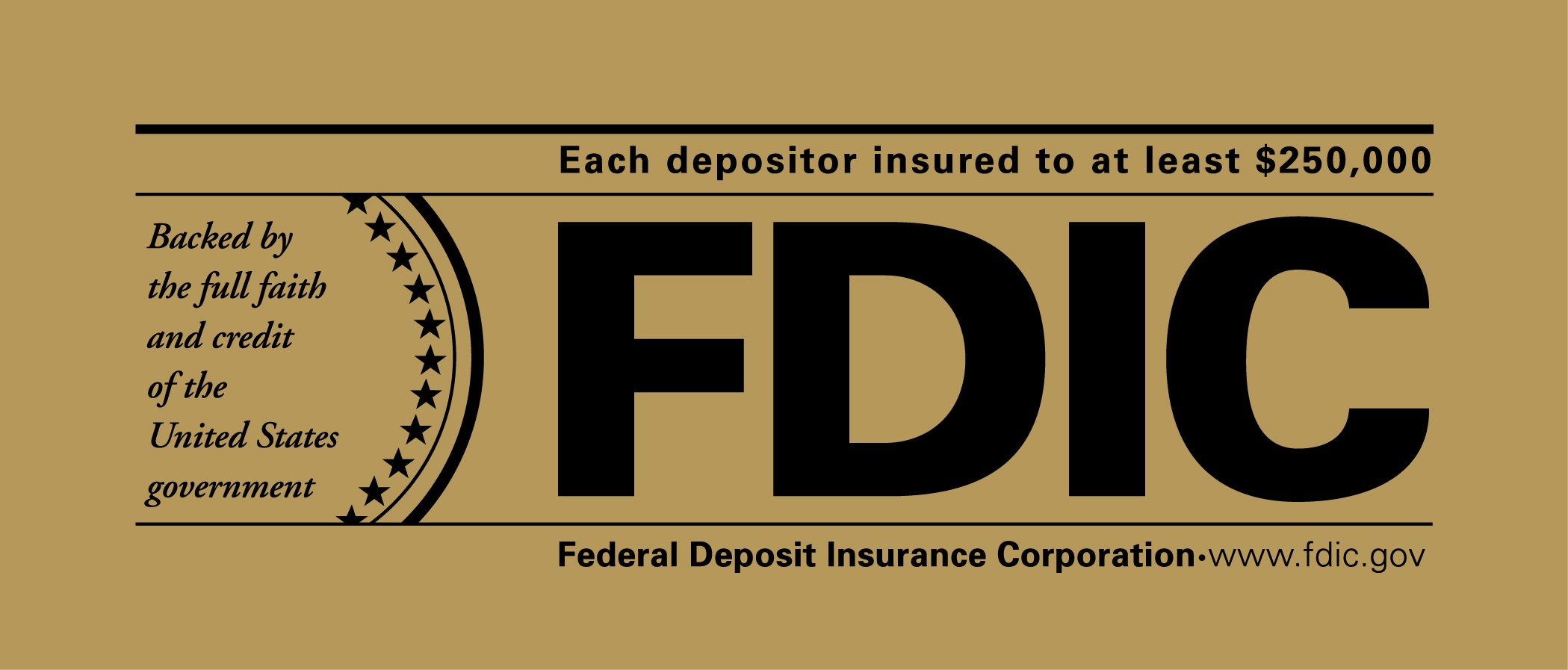
FI
What Is SIPC Insurance Coverage?
Securities Investor Protection Corporation (SIPC) coverage provides protection to customers who hold cash and securities such as stocks, bonds or mutual funds in an account at SIPC-member brokerage firms in the event the brokerage firm fails. SIPC does not cover losses due to a decline in value of securities.
Securities Investor Protection Corporation (SIPC) coverage provides protection to customers who hold cash and securities such as stocks, bonds or mutual funds in an account at SIPC-member brokerage firms in the event the brokerage firm fails. SIPC does not cover losses due to a decline in value of securities.

TR
What Is Moneyness?
In finance, moneyness is the relative position of the current price of an underlying asset with respect to the strike price of a derivative, most commonly used with put and call options and is an indicator as to whether the option would make money if it were exercised immediately. Moneyness can be measured with respect to the underlying stock or other asset's current/spot price or its future price.
In finance, moneyness is the relative position of the current price of an underlying asset with respect to the strike price of a derivative, most commonly used with put and call options and is an indicator as to whether the option would make money if it were exercised immediately. Moneyness can be measured with respect to the underlying stock or other asset's current/spot price or its future price.

OP
What Is Out-The-Money?
Out of the money (OTM) is a term used to describe an option contract that only contains intrinsic value. These options will have a delta less than 50.0. An OTM call option will have a strike price that is higher than the market price of the underlying asset. Alternatively, an OTM put option has a strike price that is lower than the market price of the underlying asset. OTM options may be contrasted with in the money (ITM) options. Being out of the money doesn't mean a trader can't make a profit on that option. A trader could have bought a far out of the money option, but now that option is moving closer to being in the money (ITM). That option could end up being worth more than the trader paid for the option, even though it is currently out of the money. At expiry, though, an option is worthless if it is OTM.
Out of the money (OTM) is a term used to describe an option contract that only contains intrinsic value. These options will have a delta less than 50.0. An OTM call option will have a strike price that is higher than the market price of the underlying asset. Alternatively, an OTM put option has a strike price that is lower than the market price of the underlying asset. OTM options may be contrasted with in the money (ITM) options. Being out of the money doesn't mean a trader can't make a profit on that option. A trader could have bought a far out of the money option, but now that option is moving closer to being in the money (ITM). That option could end up being worth more than the trader paid for the option, even though it is currently out of the money. At expiry, though, an option is worthless if it is OTM.
OP
What Is At-The-Money?
At the money (ATM) is a situation where an option's strike price is identical to the price of the underlying security. Both call and put options can be simultaneously ATM. For example, if SPX stock is trading at $75, then the SPX $75 call option is at the money and so is the SPX $75 put option. Some traders would consider an option contract to be slightly OTM or ITM if the contract is one or two contracts away from being ATM.
At the money (ATM) is a situation where an option's strike price is identical to the price of the underlying security. Both call and put options can be simultaneously ATM. For example, if SPX stock is trading at $75, then the SPX $75 call option is at the money and so is the SPX $75 put option. Some traders would consider an option contract to be slightly OTM or ITM if the contract is one or two contracts away from being ATM.
OP
What Is In-The-Money?
An in the money call option means the option holder has the opportunity to buy the security below its current market price. Alternatively, an in the money put option means the option holder can sell the security above its current market price. In the money options contracts have higher premiums. An option that is ITM does not necessarily mean the trader is making a profit on the trade. The expense of buying the option and any commission fees must also be considered. In the money options may be contrasted with out of the money (OTM) options.
An in the money call option means the option holder has the opportunity to buy the security below its current market price. Alternatively, an in the money put option means the option holder can sell the security above its current market price. In the money options contracts have higher premiums. An option that is ITM does not necessarily mean the trader is making a profit on the trade. The expense of buying the option and any commission fees must also be considered. In the money options may be contrasted with out of the money (OTM) options.
OP
What Makes My Net Worth?
In a nutshell, your net worth is really everything you own of significance (your assets) minus what you owe in debts (your liabilities). Assets include cash and investments, your home and other real estate, cars or anything else of value you own. Liabilities are what you owe on those assets — including car loans, your mortgage, and student loan debt.
Net worth is a measure of your financial health because it basically says what you would have left over if you sold all of your assets to pay all of your debts. Every financial move you make should be aimed at increasing your net worth. This means either increasing assets, or decreasing liabilities.
In a nutshell, your net worth is really everything you own of significance (your assets) minus what you owe in debts (your liabilities). Assets include cash and investments, your home and other real estate, cars or anything else of value you own. Liabilities are what you owe on those assets — including car loans, your mortgage, and student loan debt.
Net worth is a measure of your financial health because it basically says what you would have left over if you sold all of your assets to pay all of your debts. Every financial move you make should be aimed at increasing your net worth. This means either increasing assets, or decreasing liabilities.
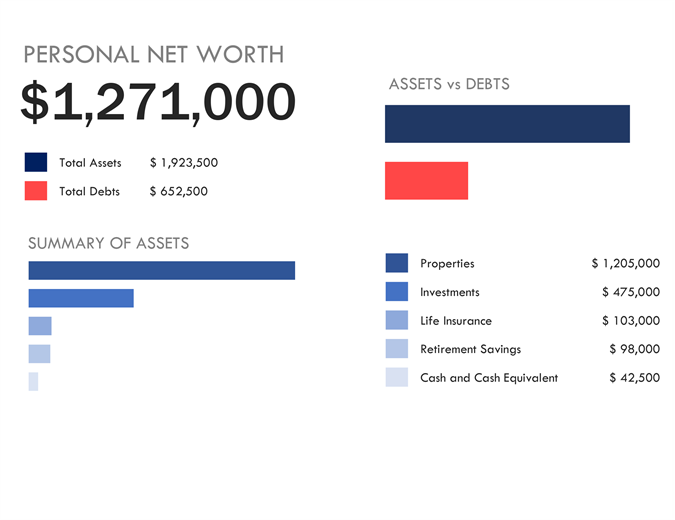
FI
What Does It Mean To Exercise an Option?
"Exercising the option" means the buyer is opting to take advantage of the right to buy or sell the shares at the strike price prior to an option contract's expiration. The difference between sell to close and exercise is that with a sell to close you transfer the right to exercise to a new party. With exercise you get to buy/sell the stocks at the agreed price.
"Exercising the option" means the buyer is opting to take advantage of the right to buy or sell the shares at the strike price prior to an option contract's expiration. The difference between sell to close and exercise is that with a sell to close you transfer the right to exercise to a new party. With exercise you get to buy/sell the stocks at the agreed price.
OP
What Is a Call Option?
Call options are financial contracts that give the option buyer the right, but not the obligation, to buy a stock, bond, commodity or other asset or instrument at a specified price within a specific time period. A call buyer profits when the underlying asset increases in price.
Call options are financial contracts that give the option buyer the right, but not the obligation, to buy a stock, bond, commodity or other asset or instrument at a specified price within a specific time period. A call buyer profits when the underlying asset increases in price.
OP
What Is a Put Option?
In finance, a put or put option is a stock market instrument which gives the holder the right to sell an asset, at a specified price, by a specified date to a given party. The purchase of a put option is interpreted as a negative sentiment about the future value of the underlying stock
In finance, a put or put option is a stock market instrument which gives the holder the right to sell an asset, at a specified price, by a specified date to a given party. The purchase of a put option is interpreted as a negative sentiment about the future value of the underlying stock
OP
What Is The Ticker Of an Option (Option Symbol)?
An option ticker is a code by which options are identified on an options exchange or a futures exchange. An option ticker can be broken down into six parts. The components of an option's symbol are: Root symbol (ticker symbol) + Expiration Year (yy) + Expiration Month (mm) + Expiration Day (dd) + Call/Put Indicator (C or P) + Strike Price. As seen in this example, Yahoo had a call option expiring on April the 16th of 2015 at a strike price of $30.00: YHOO150416C00030000. The decimal point falls 3 places from the right in the options symbol: 00000.000
An option ticker is a code by which options are identified on an options exchange or a futures exchange. An option ticker can be broken down into six parts. The components of an option's symbol are: Root symbol (ticker symbol) + Expiration Year (yy) + Expiration Month (mm) + Expiration Day (dd) + Call/Put Indicator (C or P) + Strike Price. As seen in this example, Yahoo had a call option expiring on April the 16th of 2015 at a strike price of $30.00: YHOO150416C00030000. The decimal point falls 3 places from the right in the options symbol: 00000.000
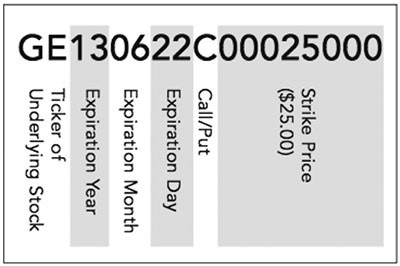
OP
Hugh's Trading Room 1
Question:
I noticed that sometimes when I buy an option and the market goes against me but later comes back to the level I bought it at, the option is completely not the same in terms of price. Even if there's a good market move in my favor on the same day I bought it, it doesn't impact my option as much. Why is that?
Answer:
There are three things that come into action. 1. Theta 2. Volatility 3. Bid Ask Spread.
Question:
I noticed that sometimes when I buy an option and the market goes against me but later comes back to the level I bought it at, the option is completely not the same in terms of price. Even if there's a good market move in my favor on the same day I bought it, it doesn't impact my option as much. Why is that?
Answer:
There are three things that come into action. 1. Theta 2. Volatility 3. Bid Ask Spread.
TR
Hugh's Trading Room 2
Question:
How much of my account should I risk per trade in terms of percentage?
Answer:
No more than 15%. As you become more experienced, the more that number can go up or down & be flexible. But when starting out, 15% is a good number.
Question:
How much of my account should I risk per trade in terms of percentage?
Answer:
No more than 15%. As you become more experienced, the more that number can go up or down & be flexible. But when starting out, 15% is a good number.
TR
What Is Going Long?
A long position, also known as simply long, is the buying of a stock, commodity, or currency with the expectation that it will rise in value. An investor who hopes to benefit from an upward price movement in an asset will "go long" with the expectation that your purchase will rise in value. It's the opposite of going short, which is when you expect the value to fall.
A long position, also known as simply long, is the buying of a stock, commodity, or currency with the expectation that it will rise in value. An investor who hopes to benefit from an upward price movement in an asset will "go long" with the expectation that your purchase will rise in value. It's the opposite of going short, which is when you expect the value to fall.

TR
What Is Shorting?
A short, or a short position, is created when a trader sells a security first with the intention of repurchasing it or covering it later at a lower price. A trader may decide to short a security when she believes that the price of that security is likely to decrease in the near future. Shorting is a strategy used when an investor anticipates the price of a security will fall in the short term.
A short, or a short position, is created when a trader sells a security first with the intention of repurchasing it or covering it later at a lower price. A trader may decide to short a security when she believes that the price of that security is likely to decrease in the near future. Shorting is a strategy used when an investor anticipates the price of a security will fall in the short term.

TR
What Is Strike Price?
A strike price is the set price at which a derivative contract can be bought or sold when it is exercised. For call options, the strike price is where the security can be bought by the option holder; for put options, the strike price is the price at which the security can be sold. Strike price is also known as the exercise price. The price difference between the underlying stock price and the strike price determines an option's value.
A strike price is the set price at which a derivative contract can be bought or sold when it is exercised. For call options, the strike price is where the security can be bought by the option holder; for put options, the strike price is the price at which the security can be sold. Strike price is also known as the exercise price. The price difference between the underlying stock price and the strike price determines an option's value.
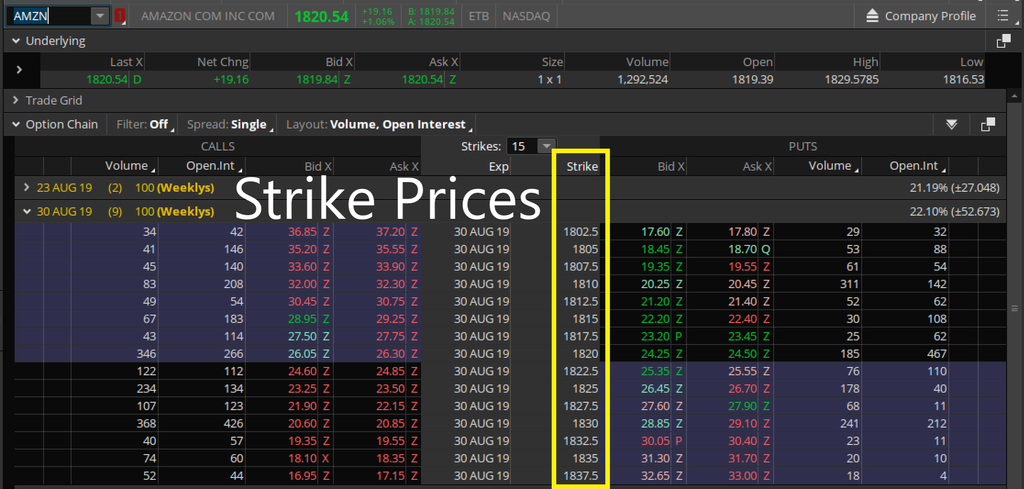
OP
What Is Asset Allocation?
Asset allocation is the implementation of an investment strategy that attempts to balance risk versus reward by adjusting the percentage of each asset in an investment portfolio according to the investor's risk tolerance, goals, and investment time frame. The focus is on the characteristics of the overall portfolio.
Asset allocation is the implementation of an investment strategy that attempts to balance risk versus reward by adjusting the percentage of each asset in an investment portfolio according to the investor's risk tolerance, goals, and investment time frame. The focus is on the characteristics of the overall portfolio.
FI
What Is Theta?
Theta is a measure of the rate of decline in the value of an option due to the passage of time. It can also be referred to as an option's time decay. If everything is held constant, the option loses value as time moves closer to the maturity of the option. In other words, the theta will decrease even more as you get closer to expiration. Again, theta is a measurement of time decay. It shows you how much the option is likely to decrease in value every day, all other things being equal. A theta of -0.2836 means that the option will decrease about 28 cents in value every day.
Theta is a measure of the rate of decline in the value of an option due to the passage of time. It can also be referred to as an option's time decay. If everything is held constant, the option loses value as time moves closer to the maturity of the option. In other words, the theta will decrease even more as you get closer to expiration. Again, theta is a measurement of time decay. It shows you how much the option is likely to decrease in value every day, all other things being equal. A theta of -0.2836 means that the option will decrease about 28 cents in value every day.
OP
What Is Rebalancing?
Rebalancing is the process of realigning the weightings of a portfolio of assets. Rebalancing involves periodically buying or selling assets in a portfolio to maintain an original or desired level of asset allocation or risk.
For example, say an original target asset allocation was 50% stocks and 50% bonds. If the stocks performed well during the period, it could have increased the stock weighting of the portfolio to 70%. The investor may then decide to sell some stocks and buy bonds to get the portfolio back to the original target allocation of 50/50.
Rebalancing is the process of realigning the weightings of a portfolio of assets. Rebalancing involves periodically buying or selling assets in a portfolio to maintain an original or desired level of asset allocation or risk.
For example, say an original target asset allocation was 50% stocks and 50% bonds. If the stocks performed well during the period, it could have increased the stock weighting of the portfolio to 70%. The investor may then decide to sell some stocks and buy bonds to get the portfolio back to the original target allocation of 50/50.
FI
What Is Delta?
Delta measures the degree to which an option is exposed to shifts in the price of the underlying asset (i.e. stock) or commodity (i.e. futures contract). Delta is the amount an option price is expected to move based on a $1 change in the underlying stock. Generally speaking, an at-the-money option usually has a delta at approximately 0.5 (Calls) or -0.5 (Puts). Calls have positive delta, between 0 and 1. Inverse occurs for puts, they have a delta of -. Delta is subject to change given changes in implied volatility. And, delta tends to increase as you get closer to expiration for near or at-the-money options.
Delta measures the degree to which an option is exposed to shifts in the price of the underlying asset (i.e. stock) or commodity (i.e. futures contract). Delta is the amount an option price is expected to move based on a $1 change in the underlying stock. Generally speaking, an at-the-money option usually has a delta at approximately 0.5 (Calls) or -0.5 (Puts). Calls have positive delta, between 0 and 1. Inverse occurs for puts, they have a delta of -. Delta is subject to change given changes in implied volatility. And, delta tends to increase as you get closer to expiration for near or at-the-money options.
OP
What Is Dividend Yield?
The dividend yield or dividend-price ratio of a share is the dividend per share, divided by the price per share. It is also a company's total annual dividend payments divided by its market capitalization, assuming the number of shares is constant. It is often expressed as a percentage.
The dividend yield or dividend-price ratio of a share is the dividend per share, divided by the price per share. It is also a company's total annual dividend payments divided by its market capitalization, assuming the number of shares is constant. It is often expressed as a percentage.

DI
What Is Gamma?
Gamma measures the exposure of the options delta to the movement of the underlying stock price. Just like delta is the rate of change of options price with respect to underlying stock's price; gamma is the rate of change of delta with respect to underlying stock's price. The gamma of an option is expressed as a percentage and reflects the change in the delta in response to a one point movement of the underlying stock price.
Gamma measures the exposure of the options delta to the movement of the underlying stock price. Just like delta is the rate of change of options price with respect to underlying stock's price; gamma is the rate of change of delta with respect to underlying stock's price. The gamma of an option is expressed as a percentage and reflects the change in the delta in response to a one point movement of the underlying stock price.
DI
What Is Vega?
Vega is the measurement of an option's price sensitivity to changes in the volatility of the underlying asset. Vega represents the amount that an option contract's price changes in reaction to a 1% change in the implied volatility of the underlying asset. Options that are long have positive Vega while options that are short have negative Vega.
Vega is the measurement of an option's price sensitivity to changes in the volatility of the underlying asset. Vega represents the amount that an option contract's price changes in reaction to a 1% change in the implied volatility of the underlying asset. Options that are long have positive Vega while options that are short have negative Vega.
OP
What Is Implied Volatility (IV)?
Implied volatility is a metric that captures the market's view of the likelihood of changes in a given security's price. Investors can use it to project future moves and supply and demand, and often employ it to price options contracts. IV is the market's forecast of a likely movement in a security's price. Again, IV is often used to price options contracts: High implied volatility results in options with higher premiums and vice versa. IV increases in bearish markets and decreases when the market is bullish.
Implied volatility is a metric that captures the market's view of the likelihood of changes in a given security's price. Investors can use it to project future moves and supply and demand, and often employ it to price options contracts. IV is the market's forecast of a likely movement in a security's price. Again, IV is often used to price options contracts: High implied volatility results in options with higher premiums and vice versa. IV increases in bearish markets and decreases when the market is bullish.
OP
What Is an Option Premium?
An option premium is the current market price of an option contract. Out-of-the-money options' premiums consist solely of extrinsic value. For stock options, the premium is quoted as a dollar amount per share, and most contracts represent the commitment of 100 shares.
An option premium is the current market price of an option contract. Out-of-the-money options' premiums consist solely of extrinsic value. For stock options, the premium is quoted as a dollar amount per share, and most contracts represent the commitment of 100 shares.
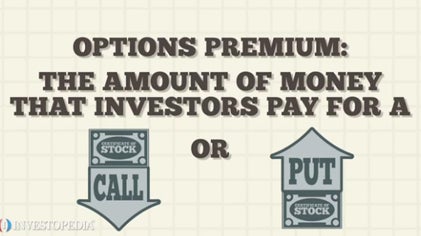
OP
What Is Intrinsic Value?
The intrinsic value of an option represents the current value of the option, or in other words how much in the money it is. So the intrinsic value represents what the buyer would receive if he decided to exercise the option right now. For in the money options, intrinsic value is calculated as the difference of the current price of the underlying asset and the strike price of the option. For options that are out of the money or at the money, the intrinsic value is always zero. This is because a buyer would never exercise an option that would result in a loss. Instead, he would let the option expire and get no payoff. Since he receives no payoff, the intrinsic value of the option is nothing to him.
The intrinsic value of an option represents the current value of the option, or in other words how much in the money it is. So the intrinsic value represents what the buyer would receive if he decided to exercise the option right now. For in the money options, intrinsic value is calculated as the difference of the current price of the underlying asset and the strike price of the option. For options that are out of the money or at the money, the intrinsic value is always zero. This is because a buyer would never exercise an option that would result in a loss. Instead, he would let the option expire and get no payoff. Since he receives no payoff, the intrinsic value of the option is nothing to him.
OP
What Is Extrinsic Value?
Extrinsic value measures the difference between the market price of an option, called the premium, and its intrinsic value. Extrinsic value is also the portion of the worth that has been assigned to an option by factors other than the underlying asset's price. Extrinsic value is also known as "time value" because the time left until the option contract expires is one of the primary factors affecting the option premium. For example, an option with one month to expiration that is out of the money will have more extrinsic value than that of an out of the money option with one week to expiration. Extrinsic value rises with increase in volatility in the market.
Extrinsic value measures the difference between the market price of an option, called the premium, and its intrinsic value. Extrinsic value is also the portion of the worth that has been assigned to an option by factors other than the underlying asset's price. Extrinsic value is also known as "time value" because the time left until the option contract expires is one of the primary factors affecting the option premium. For example, an option with one month to expiration that is out of the money will have more extrinsic value than that of an out of the money option with one week to expiration. Extrinsic value rises with increase in volatility in the market.
OP
What Is an Option Expiration Date?
An expiration date in derivatives is the last day that derivative contracts, such as options or futures, are valid. After that time, the contract has expired. On or before this day, investors will have already decided what to do with their expiring position. If you don't sell your options before expiration, there will be an automatic exercise if the option is IN THE MONEY. If the option is OUT OF THE MONEY, the option will be worthless, so you wouldn't exercise them in any event. However, you can sell your option before it expires to retain it's leftover value.
An expiration date in derivatives is the last day that derivative contracts, such as options or futures, are valid. After that time, the contract has expired. On or before this day, investors will have already decided what to do with their expiring position. If you don't sell your options before expiration, there will be an automatic exercise if the option is IN THE MONEY. If the option is OUT OF THE MONEY, the option will be worthless, so you wouldn't exercise them in any event. However, you can sell your option before it expires to retain it's leftover value.
OP
What Is a Straddle?
A straddle is a neutral options strategy that involves simultaneously buying both a put option and a call option for the underlying security with the same strike price and the same expiration date. A trader will profit from a long straddle when the price of the security rises or falls from the strike price by an amount more than the total cost of the premium paid. Profit potential is virtually unlimited, so long as the price of the underlying security moves very sharply.
A straddle is a neutral options strategy that involves simultaneously buying both a put option and a call option for the underlying security with the same strike price and the same expiration date. A trader will profit from a long straddle when the price of the security rises or falls from the strike price by an amount more than the total cost of the premium paid. Profit potential is virtually unlimited, so long as the price of the underlying security moves very sharply.
OP
What Is a Covered Call?
A covered call refers to transaction in the financial market in which the investor selling call options owns the equivalent amount of the underlying security. To execute this an investor holding a long position in an asset then writes (sells) call options on that same asset to generate an income stream. The investor's long position in the asset is the "cover" because it means the seller can deliver the shares if the buyer of the call option chooses to exercise.
A covered call refers to transaction in the financial market in which the investor selling call options owns the equivalent amount of the underlying security. To execute this an investor holding a long position in an asset then writes (sells) call options on that same asset to generate an income stream. The investor's long position in the asset is the "cover" because it means the seller can deliver the shares if the buyer of the call option chooses to exercise.

OP
What Is The Trade Price?
Trade price, or average trade price, is the mean price of an asset or security over some period of time. The trade price of an option can be used to indicate your breaking even point of an option contract. Again, the trade price is also an average of the total cost of your option contracts when buying and selling options. Not to be confused with the price at which a stock/security is currently selling.
Trade price, or average trade price, is the mean price of an asset or security over some period of time. The trade price of an option can be used to indicate your breaking even point of an option contract. Again, the trade price is also an average of the total cost of your option contracts when buying and selling options. Not to be confused with the price at which a stock/security is currently selling.
OP
What Is a Dividend Growth Rate?
The dividend growth rate is the average rate of growth a stock’s dividend has experienced for a specific period of time. Dividend growth is an immensely important statistic for investors to focus on. But often what’s more important than the current size of the dividend is the pace at which it has been growing (or shrinking). You see, growing dividends are a sign of a healthy stock, one that is committed to its shareholders, and may also be an indication of more dividend raises to come.
The dividend growth rate is the average rate of growth a stock’s dividend has experienced for a specific period of time. Dividend growth is an immensely important statistic for investors to focus on. But often what’s more important than the current size of the dividend is the pace at which it has been growing (or shrinking). You see, growing dividends are a sign of a healthy stock, one that is committed to its shareholders, and may also be an indication of more dividend raises to come.
DI
What is an ETF?
An ETF is called an exchange-traded fund since it's traded on an exchange just like stocks. But unlike a stock, which focuses on one company, an ETF tracks an index, a commodity, bonds, or a basket of securities.
An ETF is called an exchange-traded fund since it's traded on an exchange just like stocks. But unlike a stock, which focuses on one company, an ETF tracks an index, a commodity, bonds, or a basket of securities.

ST
Dividend Investing Introduction
What Is a REIT?
A real estate investment trust (REIT) is a company owning and typically operating real estate which generates income. Most REITs specialize in a specific real estate sector, focusing their time, energy, and funding on that particular segment of the entire real estate horizon.
Properties included in a REIT portfolio may include apartment complexes, data centers, health care facilities, hotels, infrastructure—in the form of fiber cables, cell towers, and energy pipelines—office buildings, retail centers, self-storage, timberland, and warehouses. One benefit of REITs for everyday investors is that they provide the opportunity to own a portion of real estate which generates dividend-based income.
A real estate investment trust (REIT) is a company owning and typically operating real estate which generates income. Most REITs specialize in a specific real estate sector, focusing their time, energy, and funding on that particular segment of the entire real estate horizon.
Properties included in a REIT portfolio may include apartment complexes, data centers, health care facilities, hotels, infrastructure—in the form of fiber cables, cell towers, and energy pipelines—office buildings, retail centers, self-storage, timberland, and warehouses. One benefit of REITs for everyday investors is that they provide the opportunity to own a portion of real estate which generates dividend-based income.

DI
What Are the Different Types of REITs?
1. Retail REITs
2. Residential REITs
3. Healthcare REITs
4. Office REITs
5. Mortgage REITs
1. Retail REITs
2. Residential REITs
3. Healthcare REITs
4. Office REITs
5. Mortgage REITs
DI
What Is a FICO Score?
A FICO score is a type of credit score created by the Fair Isaac Corporation. Lenders use borrowers' FICO scores along with other details on borrowers' credit reports to assess credit risk and determine whether to extend credit. FICO scores take into account various factors in five areas to determine creditworthiness: payment history, current level of indebtedness, types of credit used, length of credit history, and new credit accounts.
A FICO score is a type of credit score created by the Fair Isaac Corporation. Lenders use borrowers' FICO scores along with other details on borrowers' credit reports to assess credit risk and determine whether to extend credit. FICO scores take into account various factors in five areas to determine creditworthiness: payment history, current level of indebtedness, types of credit used, length of credit history, and new credit accounts.
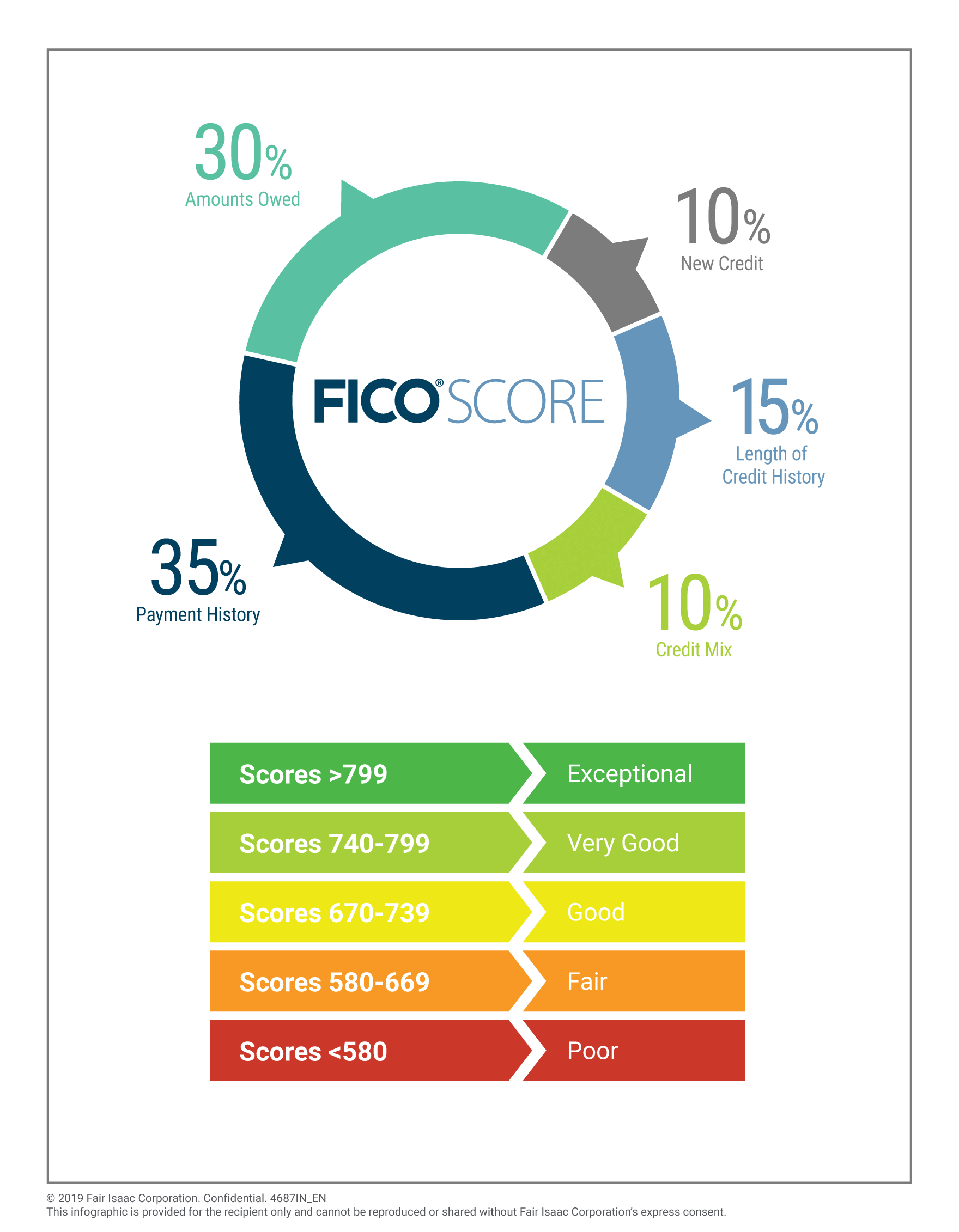
FI
What Is a DARS Rating?
The Dividend Advantage Rating System (DARS) is an exclusive and proprietary ratings model used by Dividend.com to assess the long-term sustainability, growth and safety of a stock’s underlying dividend. It works on a scale of (weak) 1-to-5 (strongest). Sophisticated algorithms filter 7,000 stocks and ETFs through five key metrics including dividend relative strength, overall yield attractiveness, reliability, uptrend and earnings growth to generate the DARS score. The highest DARS rated stocks are updated daily under Best Dividend Stocks on Dividend.com.
The Dividend Advantage Rating System (DARS) is an exclusive and proprietary ratings model used by Dividend.com to assess the long-term sustainability, growth and safety of a stock’s underlying dividend. It works on a scale of (weak) 1-to-5 (strongest). Sophisticated algorithms filter 7,000 stocks and ETFs through five key metrics including dividend relative strength, overall yield attractiveness, reliability, uptrend and earnings growth to generate the DARS score. The highest DARS rated stocks are updated daily under Best Dividend Stocks on Dividend.com.

DI
What Is an Ex-Dividend Date?
The ex-dividend date, also known as the reinvestment date, is an investment term involving the timing of payment of dividends on stocks of corporations, income trusts, and other financial holdings, both publicly and privately held.
When a company declares a dividend, it sets a record date when you must be on the company's books as a shareholder to receive the dividend. The ex-dividend date is normally two business days before the record date. If you purchase a stock on or after its ex-dividend date, you will not receive the next dividend payment.
The ex-dividend date, also known as the reinvestment date, is an investment term involving the timing of payment of dividends on stocks of corporations, income trusts, and other financial holdings, both publicly and privately held.
When a company declares a dividend, it sets a record date when you must be on the company's books as a shareholder to receive the dividend. The ex-dividend date is normally two business days before the record date. If you purchase a stock on or after its ex-dividend date, you will not receive the next dividend payment.
DI
What Is The Difference Between a Correction & a Recession?
During a correction, prices fall significantly across a single asset, industry or an entire market. Corrections can be caused by any negative event that sparks selling. Anything from a new announcement from the Fed, poor jobs numbers or higher-than-expected inflation. By contrast, a bear market is a downturn that is longer and is caused by a recession - a real contraction in the economy. A recession occurs when an entire economy contracts for several months.
During a correction, prices fall significantly across a single asset, industry or an entire market. Corrections can be caused by any negative event that sparks selling. Anything from a new announcement from the Fed, poor jobs numbers or higher-than-expected inflation. By contrast, a bear market is a downturn that is longer and is caused by a recession - a real contraction in the economy. A recession occurs when an entire economy contracts for several months.
EC
What Are Interest Rates?
Interest rates are the price you pay to borrow money (or on the flip side, the payment you receive when you lend money). They’re generally framed as percentages. Each year you either pay (if you’re borrowing) or receive (if you’re lending) this percentage of the total amount of the loan. Interest rates are one of the most important numbers in the economy because they influence how likely people are to borrow money.
When central banks like the Fed change interest rates, it has a ripple effect throughout the broader economy. Lowering rates makes borrowing money cheaper. This encourages consumer and business spending and investment and can boost asset prices. However, it can also lead to problems such as inflation and liquidity traps, which undermines the effectiveness of low rates. This is why economists are so obsessed with interest rates. This one number can be thought of as a massive lever that can either spur loads of investments (with low rates), or slow things down when everyone’s getting a bit too excited (with high rates).
Interest rates are the price you pay to borrow money (or on the flip side, the payment you receive when you lend money). They’re generally framed as percentages. Each year you either pay (if you’re borrowing) or receive (if you’re lending) this percentage of the total amount of the loan. Interest rates are one of the most important numbers in the economy because they influence how likely people are to borrow money.
When central banks like the Fed change interest rates, it has a ripple effect throughout the broader economy. Lowering rates makes borrowing money cheaper. This encourages consumer and business spending and investment and can boost asset prices. However, it can also lead to problems such as inflation and liquidity traps, which undermines the effectiveness of low rates. This is why economists are so obsessed with interest rates. This one number can be thought of as a massive lever that can either spur loads of investments (with low rates), or slow things down when everyone’s getting a bit too excited (with high rates).
EC
What Are Negative Interest Rates?
Negative interest rates are an unconventional, and seemingly counterintuitive, monetary policy tool. Central banks impose the drastic measure of negative interest rates when they fear their national economies are slipping into a deflationary spiral, in which there is no spending—and hence, dropping prices, no profits, and no growth.
In theory, negative interest rates should help to stimulate economic activity and stave off inflation, but policymakers remain cautious because there are several ways such a policy could backfire. Because banks have certain assets such as mortgages that are contractually tied to the prevailing interest rate, such negative rates could squeeze profit margins to the point where banks are actually willing to lend less. With negative interest rates, cash deposited at a bank yields a storage charge, rather than the opportunity to earn interest income.
Negative interest rates are an unconventional, and seemingly counterintuitive, monetary policy tool. Central banks impose the drastic measure of negative interest rates when they fear their national economies are slipping into a deflationary spiral, in which there is no spending—and hence, dropping prices, no profits, and no growth.
In theory, negative interest rates should help to stimulate economic activity and stave off inflation, but policymakers remain cautious because there are several ways such a policy could backfire. Because banks have certain assets such as mortgages that are contractually tied to the prevailing interest rate, such negative rates could squeeze profit margins to the point where banks are actually willing to lend less. With negative interest rates, cash deposited at a bank yields a storage charge, rather than the opportunity to earn interest income.
EC
What Is The Shadow Banking System?
The shadow banking system is a term for the collection of non-bank financial intermediaries that provide services similar to traditional commercial banks but outside normal banking regulations. Examples of intermediaries not subject to regulation include hedge funds, unlisted derivatives, and other unlisted instruments, while examples of unregulated activities by regulated institutions include credit default swaps. The shadow banking system played a major role in the expansion of housing credit in the run up to the 2008 financial crisis, but has grown in size and largely escaped government oversight even since then.
The shadow banking system is a term for the collection of non-bank financial intermediaries that provide services similar to traditional commercial banks but outside normal banking regulations. Examples of intermediaries not subject to regulation include hedge funds, unlisted derivatives, and other unlisted instruments, while examples of unregulated activities by regulated institutions include credit default swaps. The shadow banking system played a major role in the expansion of housing credit in the run up to the 2008 financial crisis, but has grown in size and largely escaped government oversight even since then.
EC
What Is a Bank Run?
A bank run occurs when a large number of customers of a bank or other financial institution withdraw their deposits simultaneously over concerns of the bank's solvency. As more people withdraw their funds, the probability of default increases, prompting more people to withdraw their deposits. In extreme cases, the bank's reserves may not be sufficient to cover the withdrawals.
A bank run occurs when a large number of customers of a bank or other financial institution withdraw their deposits simultaneously over concerns of the bank's solvency. As more people withdraw their funds, the probability of default increases, prompting more people to withdraw their deposits. In extreme cases, the bank's reserves may not be sufficient to cover the withdrawals.

EC
What Is The Great Recession?
The Great Recession is a term that represents the sharp decline in economic activity during the late 2000s. This period is considered the most significant downturn since the Great Depression. The term Great Recession applies to both the U.S. recession, officially lasting from December 2007 to June 2009, and the ensuing global recession in 2009. The economic slump began when the U.S. housing market went from boom to bust, and large amounts of mortgage-backed securities (MBS's) and derivatives lost significant value.
The Great Recession is a term that represents the sharp decline in economic activity during the late 2000s. This period is considered the most significant downturn since the Great Depression. The term Great Recession applies to both the U.S. recession, officially lasting from December 2007 to June 2009, and the ensuing global recession in 2009. The economic slump began when the U.S. housing market went from boom to bust, and large amounts of mortgage-backed securities (MBS's) and derivatives lost significant value.
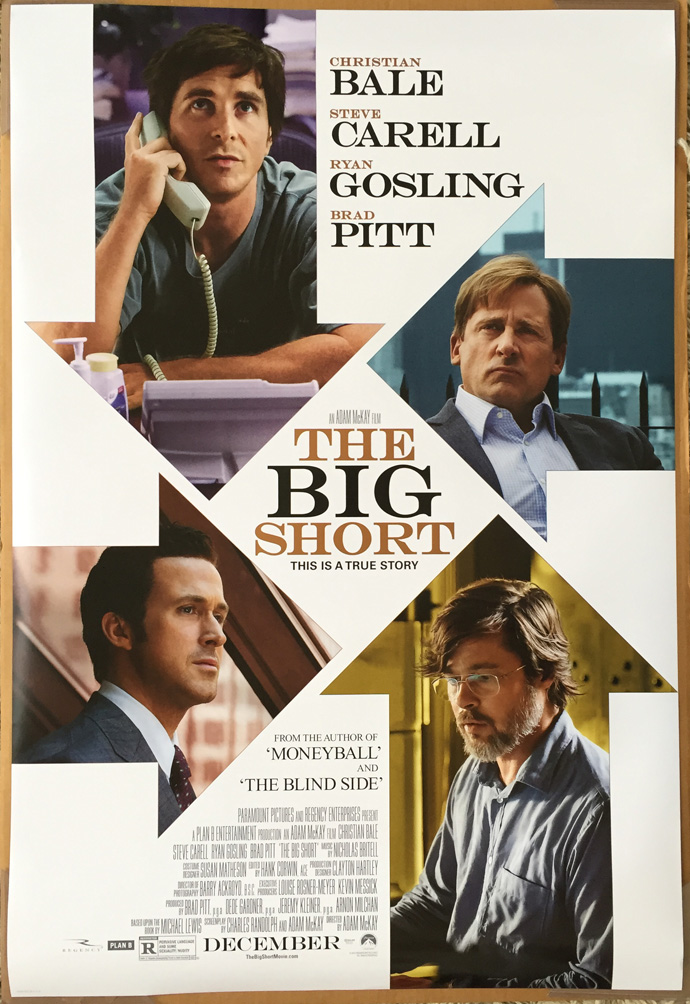
EC
What Is The Great Depression?
The Great Depression was the greatest and longest economic recession in modern world history. It began with the U.S. stock market crash of 1929 and did not end until 1946 after World War II. Economists and historians often cite the Great Depression as the most catastrophic economic event of the 20th century. During the short depression that lasted from 1920 to 1921, known as the Forgotten Depression, the U.S. stock market fell by nearly 50%, and corporate profits declined over 90%. However, the U.S. economy enjoyed robust growth during the rest of the decade. The Roaring Twenties, as the era came to be known, was a period when the American public discovered the stock market and dove in head first.
The lead-up to October 1929 saw equity prices rise to all-time high multiples of more than 30-times earnings, and the benchmark Dow Jones Industrial Average increased 500% in just five years. The NYSE bubble burst violently Oct. 24, 1929, a day that came to be known as Black Thursday. A brief rally occurred Friday the 25th and during a half-day session Saturday the 26th. However, the following week brought Black Monday, Oct. 28, and Black Tuesday, Oct. 29. The Dow Jones Industrial Index (DJIA) fell more than 20% over those two days. The stock market would eventually fall almost 90% from its 1929 peak. Ripples from the crash spread across the Atlantic Ocean to Europe triggering other financial crises such as the collapse of the Boden-Kredit Anstalt, Austria’s most important bank. In 1931, the economic calamity hit both continents in full force.
The Great Depression was the greatest and longest economic recession in modern world history. It began with the U.S. stock market crash of 1929 and did not end until 1946 after World War II. Economists and historians often cite the Great Depression as the most catastrophic economic event of the 20th century. During the short depression that lasted from 1920 to 1921, known as the Forgotten Depression, the U.S. stock market fell by nearly 50%, and corporate profits declined over 90%. However, the U.S. economy enjoyed robust growth during the rest of the decade. The Roaring Twenties, as the era came to be known, was a period when the American public discovered the stock market and dove in head first.
The lead-up to October 1929 saw equity prices rise to all-time high multiples of more than 30-times earnings, and the benchmark Dow Jones Industrial Average increased 500% in just five years. The NYSE bubble burst violently Oct. 24, 1929, a day that came to be known as Black Thursday. A brief rally occurred Friday the 25th and during a half-day session Saturday the 26th. However, the following week brought Black Monday, Oct. 28, and Black Tuesday, Oct. 29. The Dow Jones Industrial Index (DJIA) fell more than 20% over those two days. The stock market would eventually fall almost 90% from its 1929 peak. Ripples from the crash spread across the Atlantic Ocean to Europe triggering other financial crises such as the collapse of the Boden-Kredit Anstalt, Austria’s most important bank. In 1931, the economic calamity hit both continents in full force.

EC
What Is Credit?
Credit is the most important part of the economy. It is a transaction between a lender and a borrower, in which the borrower promises to pay back the money in the future along with interest. Credit leads to an increase in spending, thus increasing income levels in the economy. This, in turn, leads to higher GDP (gross domestic product) and thereby faster productivity growth. If credit is used to purchase productive resources, it helps in economic growth and adds to income. Credit further leads to the creation of debt cycles.
Credit is the most important part of the economy. It is a transaction between a lender and a borrower, in which the borrower promises to pay back the money in the future along with interest. Credit leads to an increase in spending, thus increasing income levels in the economy. This, in turn, leads to higher GDP (gross domestic product) and thereby faster productivity growth. If credit is used to purchase productive resources, it helps in economic growth and adds to income. Credit further leads to the creation of debt cycles.
EC
What Is Debt?
Debt is an obligation that requires one party, the debtor, to pay money or other agreed-upon value to another party, the creditor. Debt is a deferred payment, or series of payments, which differentiates it from an immediate purchase. A debt arrangement gives the borrowing party permission to borrow money under the condition that it is to be paid back at a later date, usually with interest. The most common forms of debt are loans, including mortgages and auto loans, personal loans, and credit card debt.
Debt is an obligation that requires one party, the debtor, to pay money or other agreed-upon value to another party, the creditor. Debt is a deferred payment, or series of payments, which differentiates it from an immediate purchase. A debt arrangement gives the borrowing party permission to borrow money under the condition that it is to be paid back at a later date, usually with interest. The most common forms of debt are loans, including mortgages and auto loans, personal loans, and credit card debt.
EC
What Is Gross Domestic Product (GDP)?
Gross Domestic Product (GDP) is the total monetary or market value of all the finished goods and services produced within a country's borders in a specific time period. As a broad measure of overall domestic production, it functions as a comprehensive scorecard of the country’s economic health.
Gross Domestic Product (GDP) is the total monetary or market value of all the finished goods and services produced within a country's borders in a specific time period. As a broad measure of overall domestic production, it functions as a comprehensive scorecard of the country’s economic health.
EC
How Does a Bank Work?
To summarize, a bank works by paying people small amounts to lend them money, then lending that money onto others for larger amounts. They manage that whole process, and then keep the difference between the large amount (interest on loans) and small amount (interest from a savings account). A bank is a business like any other business: it strives to make as much money as possible. They make money by simply moving money around.
To summarize, a bank works by paying people small amounts to lend them money, then lending that money onto others for larger amounts. They manage that whole process, and then keep the difference between the large amount (interest on loans) and small amount (interest from a savings account). A bank is a business like any other business: it strives to make as much money as possible. They make money by simply moving money around.
EC
What Is an Economic Bubble?
An economic bubble or asset bubble is a situation in which asset prices appear to be based on implausible or inconsistent views about the future. It could also be described as trade in an asset at a price or price range that strongly exceeds the asset's intrinsic value. It is created by a surge in asset prices unwarranted by the fundamentals of the asset and driven by exuberant market behavior. When no more investors are willing to buy at the elevated price, a massive sell-off occurs, causing the bubble to deflate.
An economic bubble or asset bubble is a situation in which asset prices appear to be based on implausible or inconsistent views about the future. It could also be described as trade in an asset at a price or price range that strongly exceeds the asset's intrinsic value. It is created by a surge in asset prices unwarranted by the fundamentals of the asset and driven by exuberant market behavior. When no more investors are willing to buy at the elevated price, a massive sell-off occurs, causing the bubble to deflate.
EC
What Is Debt Deflation?
Debt deflation, which often occurs after a debt bubble has burst, happens when too much debt depresses the value of properties, goods, or services. Borrowers will typically experience decreasing property values from debt deflation, which can lead to an array of other negative repercussions. In the broad market, debt deflation generally refers to a theory that identifies total outstanding debts as a catalyst for price decreases across a country’s economy. When debt issuance reaches new peaks, it can deflate the value of real currency. As debt issuance increases, the risk for default rates are also higher.
The mortgage market is one area highly prone to debt deflation since it encompasses a large portion of the total debt outstanding overall. In a debt-deflation cycle borrowers can struggle with paying their mortgage debt and decreasing property value of the collateral used to secure their debt in a mortgage loan. It can lead to higher rates of foreclosure. Declining property values can lead to underwater mortgages, even foreclosures, when debt deflation strikes the mortgage industry.
Debt deflation, which often occurs after a debt bubble has burst, happens when too much debt depresses the value of properties, goods, or services. Borrowers will typically experience decreasing property values from debt deflation, which can lead to an array of other negative repercussions. In the broad market, debt deflation generally refers to a theory that identifies total outstanding debts as a catalyst for price decreases across a country’s economy. When debt issuance reaches new peaks, it can deflate the value of real currency. As debt issuance increases, the risk for default rates are also higher.
The mortgage market is one area highly prone to debt deflation since it encompasses a large portion of the total debt outstanding overall. In a debt-deflation cycle borrowers can struggle with paying their mortgage debt and decreasing property value of the collateral used to secure their debt in a mortgage loan. It can lead to higher rates of foreclosure. Declining property values can lead to underwater mortgages, even foreclosures, when debt deflation strikes the mortgage industry.
EC
What Is a Liquidity Trap?
A liquidity trap is a contradictory economic situation in which interest rates are very low and savings rates are high, rendering monetary policy ineffective. First described by economist John Maynard Keynes, during a liquidity trap, consumers choose to avoid bonds and keep their funds in cash savings because of the prevailing belief that interest rates could soon rise (which would push bond prices down). Because bonds have an inverse relationship to interest rates, many consumers do not want to hold an asset with a price that is expected to decline. At the same time, central bank efforts to spur economic activity are hampered as they are unable to lower interest rates further to incentivize investors and consumers. While a liquidity trap is a function of economic conditions, it is also psychological since consumers are making a choice to hoard cash instead of choosing higher-paying investments because of a negative economic view.
A liquidity trap is a contradictory economic situation in which interest rates are very low and savings rates are high, rendering monetary policy ineffective. First described by economist John Maynard Keynes, during a liquidity trap, consumers choose to avoid bonds and keep their funds in cash savings because of the prevailing belief that interest rates could soon rise (which would push bond prices down). Because bonds have an inverse relationship to interest rates, many consumers do not want to hold an asset with a price that is expected to decline. At the same time, central bank efforts to spur economic activity are hampered as they are unable to lower interest rates further to incentivize investors and consumers. While a liquidity trap is a function of economic conditions, it is also psychological since consumers are making a choice to hoard cash instead of choosing higher-paying investments because of a negative economic view.
EC
What Is The IS-LM Model?
The IS-LM model, which stands for "investment-savings" (IS) and "liquidity preference-money supply" (LM) is a Keynesian macroeconomic model that shows how the market for economic goods (IS) interacts with the loanable funds market (LM) or money market. It is represented as a graph in which the IS and LM curves intersect to show the short-run equilibrium between interest rates and output. The IS-LM model describes how aggregate markets for real goods and financial markets interact to balance the rate of interest and total output in the macroeconomy. IS-LM can be used to describe how changes in market preferences alter the equilibrium levels of GDP and market interest rates, but the model lacks the precision and realism to be a useful prescription tool for economic policy.
The IS-LM model, which stands for "investment-savings" (IS) and "liquidity preference-money supply" (LM) is a Keynesian macroeconomic model that shows how the market for economic goods (IS) interacts with the loanable funds market (LM) or money market. It is represented as a graph in which the IS and LM curves intersect to show the short-run equilibrium between interest rates and output. The IS-LM model describes how aggregate markets for real goods and financial markets interact to balance the rate of interest and total output in the macroeconomy. IS-LM can be used to describe how changes in market preferences alter the equilibrium levels of GDP and market interest rates, but the model lacks the precision and realism to be a useful prescription tool for economic policy.
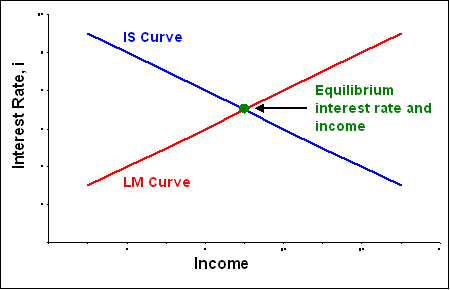
EC
What Are The Hours Of The Stock Market?
Regular trading hours for the U.S. stock market, including the New York Stock Exchange (NYSE) and the Nasdaq Stock Market (Nasdaq), are 9:30 AM to 4 PM Eastern time on weekdays (except stock market holidays). And, 8:30 AM to 3 PM Central time. On early-closure days, typically right before or right after a market holiday, regular stock trading ends at 1 PM ET (12 PM CT).
That said, trading can occur outside of normal stock market hours. For instance, on days with a regular session, there is "pre-market" trading; while hours vary, they can extend as early as 4 a.m. and go through the market open at 9:30 a.m. There are also "after-hours" sessions, which typically span from 4 to 8 p.m.
Regular trading hours for the U.S. stock market, including the New York Stock Exchange (NYSE) and the Nasdaq Stock Market (Nasdaq), are 9:30 AM to 4 PM Eastern time on weekdays (except stock market holidays). And, 8:30 AM to 3 PM Central time. On early-closure days, typically right before or right after a market holiday, regular stock trading ends at 1 PM ET (12 PM CT).
That said, trading can occur outside of normal stock market hours. For instance, on days with a regular session, there is "pre-market" trading; while hours vary, they can extend as early as 4 a.m. and go through the market open at 9:30 a.m. There are also "after-hours" sessions, which typically span from 4 to 8 p.m.
ST
What Is Technical Analysis?
Technical analysis (TA) is a trading discipline employed to evaluate investments and identify trading opportunities by analyzing statistical trends gathered from trading activity. Technical analysis tools are used to scrutinize the ways supply and demand for a security will affect changes in price, volume, and implied volatility. Technical analysis is often used to generate short-term trading signals from various charting tools, but can also help improve the evaluation of a security's strength or weakness relative to the broader market or one of its sectors. Technical analysts believe past trading activity and price changes of a security can be valuable indicators of the security's future price movements.
Technical analysis (TA) is a trading discipline employed to evaluate investments and identify trading opportunities by analyzing statistical trends gathered from trading activity. Technical analysis tools are used to scrutinize the ways supply and demand for a security will affect changes in price, volume, and implied volatility. Technical analysis is often used to generate short-term trading signals from various charting tools, but can also help improve the evaluation of a security's strength or weakness relative to the broader market or one of its sectors. Technical analysts believe past trading activity and price changes of a security can be valuable indicators of the security's future price movements.
ST
What Is Fundamental Analysis?
Fundamental analysis (FA) is a method of measuring a security's intrinsic value by examining related economic and financial factors. Fundamental analysts study anything that can affect the security's value, from macroeconomic factors such as the state of the economy and industry conditions to microeconomic factors like the effectiveness of the company's management. The end goal is to arrive at a number that an investor can compare with a security's current price in order to see whether the security is undervalued or overvalued. Fundamental analysts search for stocks that are currently trading at prices that are higher or lower than their real value. It is a method of determining a stock's real or "fair market" value.
Fundamental analysis (FA) is a method of measuring a security's intrinsic value by examining related economic and financial factors. Fundamental analysts study anything that can affect the security's value, from macroeconomic factors such as the state of the economy and industry conditions to microeconomic factors like the effectiveness of the company's management. The end goal is to arrive at a number that an investor can compare with a security's current price in order to see whether the security is undervalued or overvalued. Fundamental analysts search for stocks that are currently trading at prices that are higher or lower than their real value. It is a method of determining a stock's real or "fair market" value.

ST
What Is a Stock Split?
A stock split is a corporate action in which a company divides its existing shares into multiple shares to boost the liquidity of the shares. The primary motive is to make shares seem more affordable to small investors even though the underlying value of the company has not changed. The most common split ratios are 2-for-1 or 3-for-1, which means that the stockholder will have two or three shares, respectively, for every share held earlier. A stock split is usually done by companies that have seen their share price increase to levels that are either too high or are beyond the price levels of similar companies in their sector. The primary motive is to make shares seem more affordable to small investors even though the underlying value of the company has not changed. This has the practical effect of increasing liquidity in the stock. Stock splits do not affect short sellers in a material way.
A stock split is a corporate action in which a company divides its existing shares into multiple shares to boost the liquidity of the shares. The primary motive is to make shares seem more affordable to small investors even though the underlying value of the company has not changed. The most common split ratios are 2-for-1 or 3-for-1, which means that the stockholder will have two or three shares, respectively, for every share held earlier. A stock split is usually done by companies that have seen their share price increase to levels that are either too high or are beyond the price levels of similar companies in their sector. The primary motive is to make shares seem more affordable to small investors even though the underlying value of the company has not changed. This has the practical effect of increasing liquidity in the stock. Stock splits do not affect short sellers in a material way.
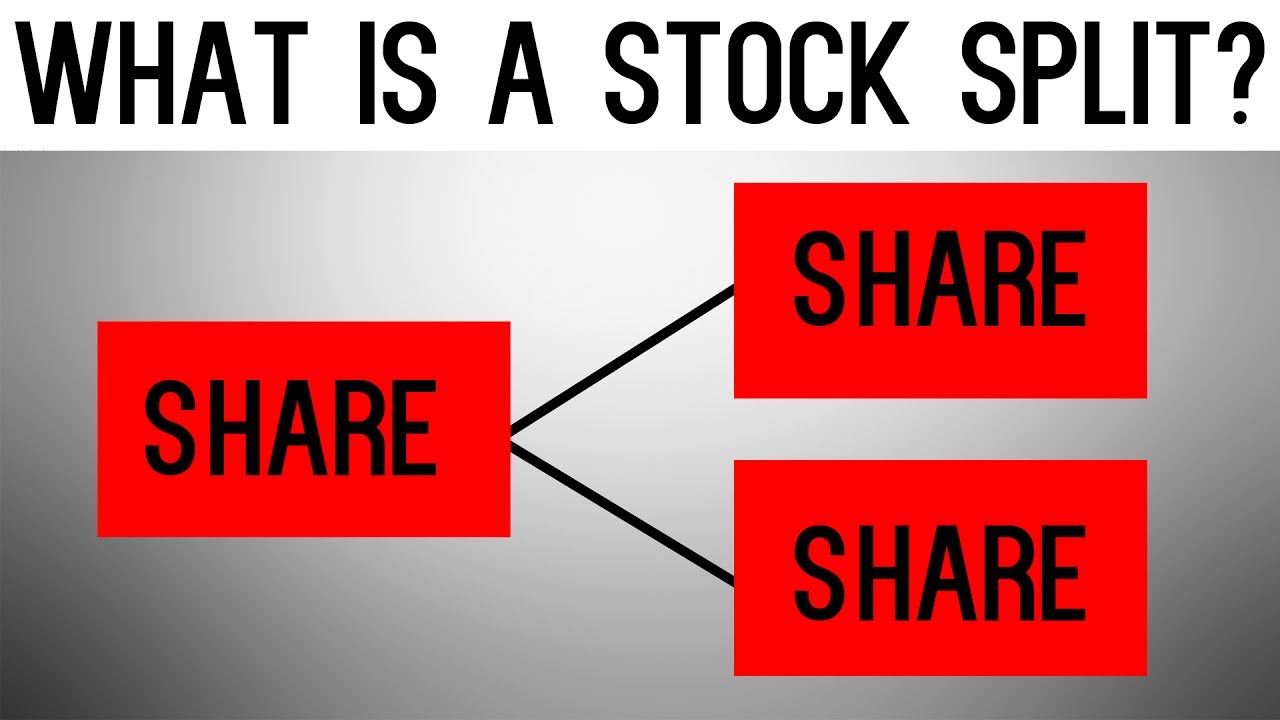
ST
What Is a Reverse Stock Split?
Another version of a stock split is the reverse split. This procedure is typically used by companies with low share prices that would like to increase these prices to either gain more respectability in the market or to prevent the company from being delisted (many stock exchanges will delist stocks if they fall below a certain price per share). Reverse stock splits are the opposite transaction, where a company divides, instead of multiplies, the number of shares that stockholders own, raising the market price accordingly. For example, in a reverse 1-for-5 split, 10 million outstanding shares at 50 cents each would now become 2 million shares outstanding at $2.50 per share. In both cases, the company is still worth $5 million.
Another version of a stock split is the reverse split. This procedure is typically used by companies with low share prices that would like to increase these prices to either gain more respectability in the market or to prevent the company from being delisted (many stock exchanges will delist stocks if they fall below a certain price per share). Reverse stock splits are the opposite transaction, where a company divides, instead of multiplies, the number of shares that stockholders own, raising the market price accordingly. For example, in a reverse 1-for-5 split, 10 million outstanding shares at 50 cents each would now become 2 million shares outstanding at $2.50 per share. In both cases, the company is still worth $5 million.

ST
What Is a Penny Stock?
Penny stocks are defined as shares of small companies with a quote or stock price value that trades at less than $5 a share. They're also otherwise known as low-capitalization stocks, meaning the total value of the company's stock is low relative to the overall market. Penny stocks include companies with market capitalization ranging from $300 million to as low as $50 million. The low-priced stock allows traders to purchase tons of shares at a bargain price with the anticipation that the price will grow resulting in a substantial gain.
Penny stocks are defined as shares of small companies with a quote or stock price value that trades at less than $5 a share. They're also otherwise known as low-capitalization stocks, meaning the total value of the company's stock is low relative to the overall market. Penny stocks include companies with market capitalization ranging from $300 million to as low as $50 million. The low-priced stock allows traders to purchase tons of shares at a bargain price with the anticipation that the price will grow resulting in a substantial gain.
ST
What Is a Candle Stick?
A candlestick is a type of price chart used that displays the high, low, open, and closing prices of a security for a specific period. It originated from Japanese rice merchants and traders to track market prices and daily momentum hundreds of years before becoming popularized in the United States. The wide part of the candlestick is called the "real body" and tells investors whether the closing price was higher or lower than the opening price (black/red if the stock closed lower, white/green if the stock closed higher).
A candlestick is a type of price chart used that displays the high, low, open, and closing prices of a security for a specific period. It originated from Japanese rice merchants and traders to track market prices and daily momentum hundreds of years before becoming popularized in the United States. The wide part of the candlestick is called the "real body" and tells investors whether the closing price was higher or lower than the opening price (black/red if the stock closed lower, white/green if the stock closed higher).
TR
What Is Heikin Ashi?
Heikin Ashi is a type of trading chart that originated in Japan, and it's similar to candlestick charts in that the color of the candlestick denotes the direction the price is moving. The main difference between traditional candlestick charts and Heikin Ashi (HA) charts is that in HA charts the average price moves, creating a smoother appearance. Because the HA price bars are averaged, they don't show the exact open and close prices for a particular time period. Some traders want additional confirmation of trend direction, and Heikin Ashi charts are often used as a technical indicator on a typical candlestick chart, to help highlight and clarify the current trend.Heikin Ashi charts are sometimes used on their own, especially by swing traders or investors. Day traders tend to use Heikin Ashi charts more as an indicator, as HA charts have certain other benefits.
Heikin Ashi is a type of trading chart that originated in Japan, and it's similar to candlestick charts in that the color of the candlestick denotes the direction the price is moving. The main difference between traditional candlestick charts and Heikin Ashi (HA) charts is that in HA charts the average price moves, creating a smoother appearance. Because the HA price bars are averaged, they don't show the exact open and close prices for a particular time period. Some traders want additional confirmation of trend direction, and Heikin Ashi charts are often used as a technical indicator on a typical candlestick chart, to help highlight and clarify the current trend.Heikin Ashi charts are sometimes used on their own, especially by swing traders or investors. Day traders tend to use Heikin Ashi charts more as an indicator, as HA charts have certain other benefits.
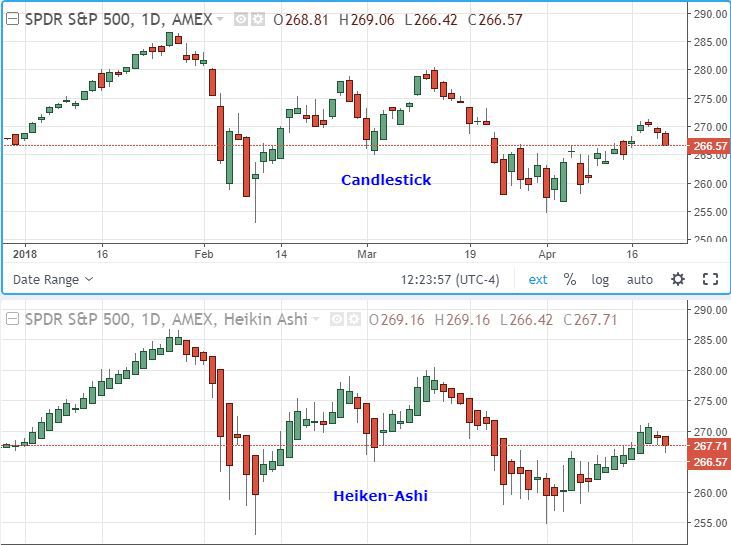
TR
What Is a Triple Bottom?
A triple bottom is a bullish chart pattern used in technical analysis that's characterized by three equal lows followed by a breakout above the resistance level. The formation of triple bottom is seen as an opportunity to enter a bullish position.
While the first bottom could simply be normal price movement, the second bottom is indicative of the bulls gaining momentum and preparing for a possible reversal. The third bottom indicates that there's strong support in place and bears may capitulate when the price breaks through resistance levels.
A triple bottom is a bullish chart pattern used in technical analysis that's characterized by three equal lows followed by a breakout above the resistance level. The formation of triple bottom is seen as an opportunity to enter a bullish position.
While the first bottom could simply be normal price movement, the second bottom is indicative of the bulls gaining momentum and preparing for a possible reversal. The third bottom indicates that there's strong support in place and bears may capitulate when the price breaks through resistance levels.

TR
What Is a Rectangle?
A Rectangle is a continuation pattern that forms as a trading range during a pause in the trend. The pattern is easily identifiable by two comparable highs and two comparable lows. The highs and lows can be connected to form two parallel lines that make up the top and bottom of a rectangle.
A Rectangle is a continuation pattern that forms as a trading range during a pause in the trend. The pattern is easily identifiable by two comparable highs and two comparable lows. The highs and lows can be connected to form two parallel lines that make up the top and bottom of a rectangle.

TR
What Is a Triple Top?
The triple top is a type of chart pattern used in technical analysis to predict the reversal in the movement of an asset's price. Consisting of three peaks, a triple top signals that the asset may no longer be rallying, and that lower prices may be on the way.
Triple tops may occur on all time frames, but in order for the pattern to be considered a triple top, it must occur after an uptrend. This pattern is known to come with a reversal, turning the trend bearish. The opposite of a triple is a triple bottom, which indicates the asset's price is no longer falling and could head higher.
The triple top is a type of chart pattern used in technical analysis to predict the reversal in the movement of an asset's price. Consisting of three peaks, a triple top signals that the asset may no longer be rallying, and that lower prices may be on the way.
Triple tops may occur on all time frames, but in order for the pattern to be considered a triple top, it must occur after an uptrend. This pattern is known to come with a reversal, turning the trend bearish. The opposite of a triple is a triple bottom, which indicates the asset's price is no longer falling and could head higher.

TR
What Is a Market Order?
A market order is a buy or sell order to be executed immediately at the current market prices. As long as there are willing sellers and buyers, market orders are filled. Market orders are used when certainty of execution is a priority over the price of execution. A market order is the simplest of the order types.
A market order is a buy or sell order to be executed immediately at the current market prices. As long as there are willing sellers and buyers, market orders are filled. Market orders are used when certainty of execution is a priority over the price of execution. A market order is the simplest of the order types.
TR
What Is a Flag?
A flag chart pattern is a technical analysis term referring to a chart pattern that gets created when a steep rise (or fall) is followed first by trading in a narrow price range and then finalized with a second steep rise (or fall).
A flag chart pattern is a technical analysis term referring to a chart pattern that gets created when a steep rise (or fall) is followed first by trading in a narrow price range and then finalized with a second steep rise (or fall).

TR
What Is a Pennant?
In technical analysis, a pennant is a type of continuation pattern formed when there is a large movement in a security, known as the flagpole, followed by a consolidation period with converging trend lines - the pennant - followed by a breakout movement in the same direction as the initial large movement, which represents the second half of the flagpole.
In technical analysis, a pennant is a type of continuation pattern formed when there is a large movement in a security, known as the flagpole, followed by a consolidation period with converging trend lines - the pennant - followed by a breakout movement in the same direction as the initial large movement, which represents the second half of the flagpole.

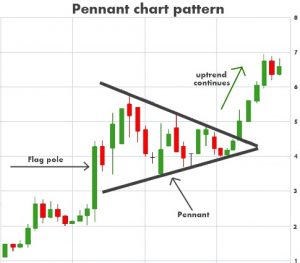
TR
What Are The Parts Of a Candlestick?
There are three main parts:
Upper Shadow: The vertical line between the high of the day and the close (bullish candle) or open (bearish candle).
Real Body: The difference between the open and close; colored portion of the candlestick.
Lower Shadow: The vertical line between the low of the day and the open (bullish candle) or close (bearish candle).
The shadow or tail is also known as a 'wick'.
There are three main parts:
Upper Shadow: The vertical line between the high of the day and the close (bullish candle) or open (bearish candle).
Real Body: The difference between the open and close; colored portion of the candlestick.
Lower Shadow: The vertical line between the low of the day and the open (bullish candle) or close (bearish candle).
The shadow or tail is also known as a 'wick'.
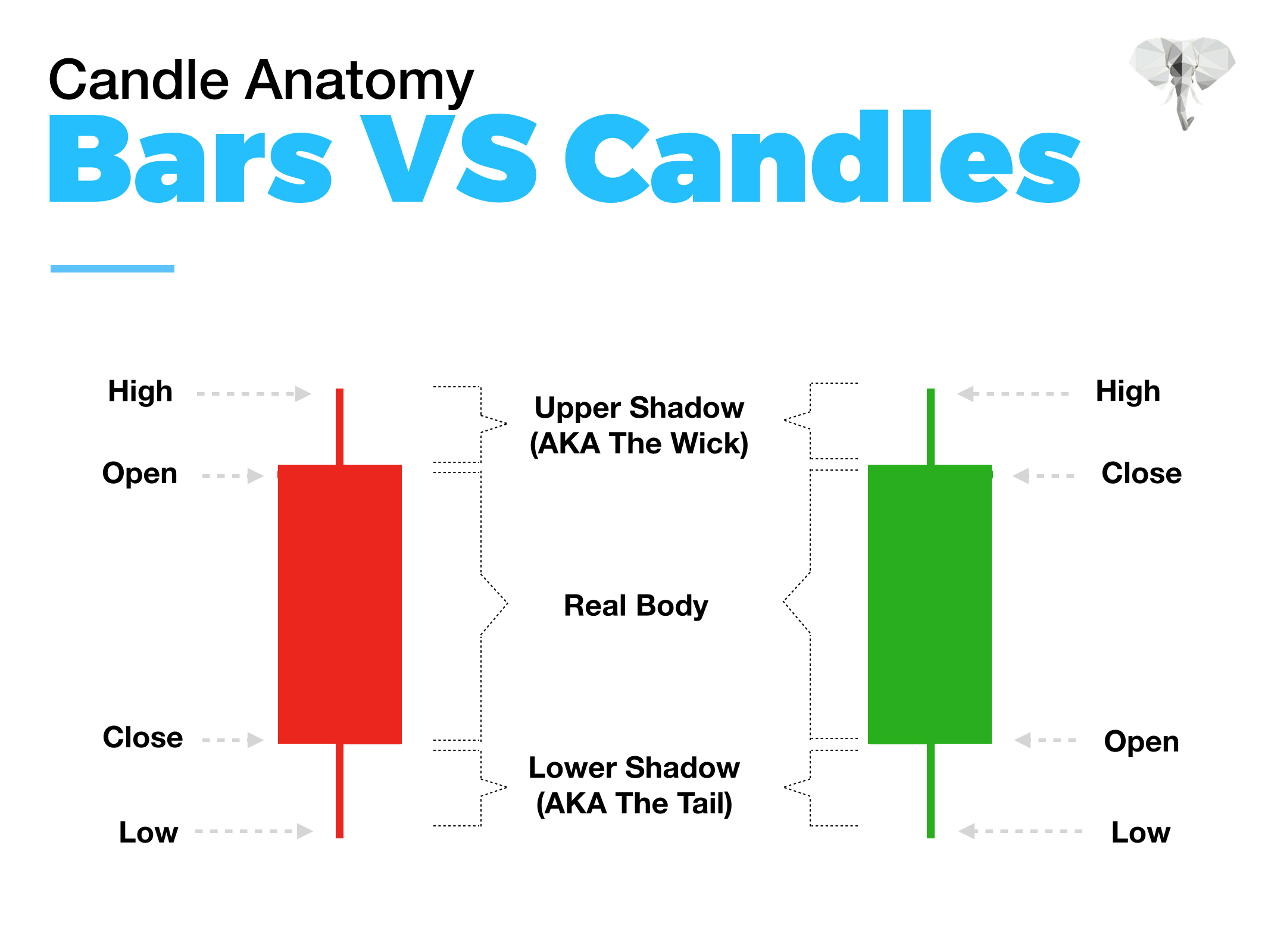

TR
What Is MACD?
Moving Average Convergence Divergence (MACD) is a trend-following momentum indicator that shows the relationship between two moving averages of a security’s price. The MACD is calculated by subtracting the 26-period Exponential Moving Average (EMA) from the 12-period EMA.
The result of that calculation is the MACD line. A nine-day EMA of the MACD called the "signal line," is then plotted on top of the MACD line, which can function as a trigger for buy and sell signals. Traders may buy the security when the MACD crosses above its signal line and sell - or short - the security when the MACD crosses below the signal line. Moving Average Convergence Divergence (MACD) indicators can be interpreted in several ways, but the more common methods are crossovers, divergences, and rapid rises/falls.
Moving Average Convergence Divergence (MACD) is a trend-following momentum indicator that shows the relationship between two moving averages of a security’s price. The MACD is calculated by subtracting the 26-period Exponential Moving Average (EMA) from the 12-period EMA.
The result of that calculation is the MACD line. A nine-day EMA of the MACD called the "signal line," is then plotted on top of the MACD line, which can function as a trigger for buy and sell signals. Traders may buy the security when the MACD crosses above its signal line and sell - or short - the security when the MACD crosses below the signal line. Moving Average Convergence Divergence (MACD) indicators can be interpreted in several ways, but the more common methods are crossovers, divergences, and rapid rises/falls.
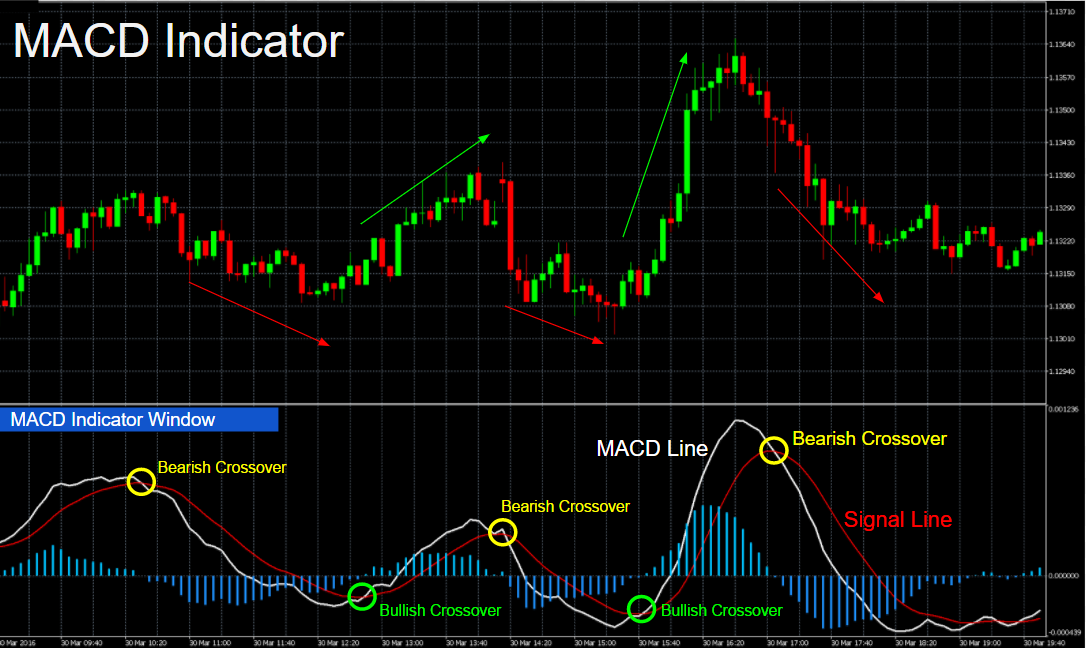
TR
What Is a Symmetrical Triangle?
A symmetrical triangle is a chart pattern characterized by two converging trend lines connecting a series of sequential peaks and troughs. These trend lines should be converging at a roughly equal slope. Trend lines that are converging at unequal slopes are referred to as a rising wedge, falling wedge, ascending triangle, or descending triangle.
A symmetrical triangle is a chart pattern characterized by two converging trend lines connecting a series of sequential peaks and troughs. These trend lines should be converging at a roughly equal slope. Trend lines that are converging at unequal slopes are referred to as a rising wedge, falling wedge, ascending triangle, or descending triangle.
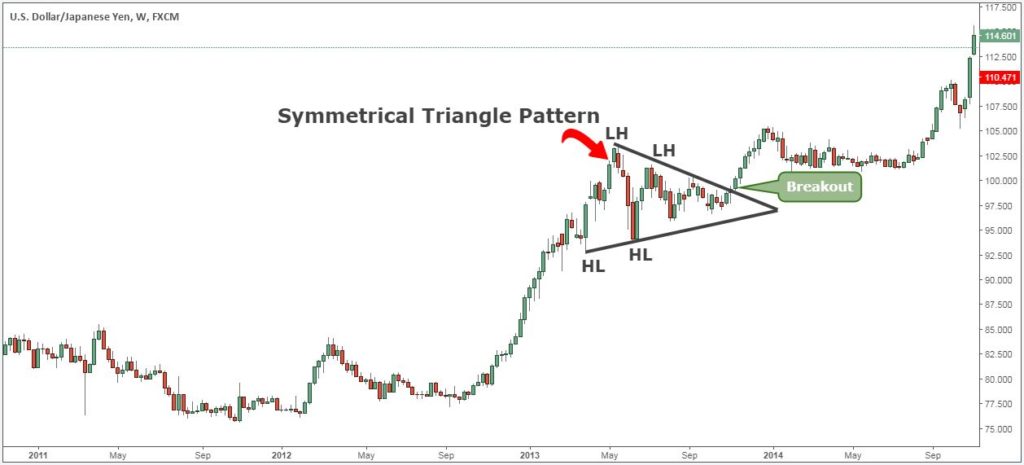
TR
What Is an Ascending Triangle?
The ascending triangle is a bullish formation that usually forms during an uptrend as a continuation pattern. It is created by price moves that allow for a horizontal line to be drawn along the swing highs, and a rising trendline to be drawn along the swing lows. The two lines form a triangle. Traders often watch for breakouts from triangle patterns. There are instances when ascending triangles form as reversal patterns at the end of a downtrend, but they are typically continuation patterns.
The ascending triangle is a bullish formation that usually forms during an uptrend as a continuation pattern. It is created by price moves that allow for a horizontal line to be drawn along the swing highs, and a rising trendline to be drawn along the swing lows. The two lines form a triangle. Traders often watch for breakouts from triangle patterns. There are instances when ascending triangles form as reversal patterns at the end of a downtrend, but they are typically continuation patterns.

TR
What Is an Descending Triangle?
A descending triangle is a bearish chart pattern used in technical analysis that is created by drawing one trend line that connects a series of lower highs and a second horizontal trend line that connects a series of lows. Oftentimes, traders watch for a move below the lower support trend line because it suggests that the downward momentum is building and a breakdown is imminent. Once the breakdown occurs, traders enter into short positions and aggressively help push the price of the asset even lower.
A descending triangle is a bearish chart pattern used in technical analysis that is created by drawing one trend line that connects a series of lower highs and a second horizontal trend line that connects a series of lows. Oftentimes, traders watch for a move below the lower support trend line because it suggests that the downward momentum is building and a breakdown is imminent. Once the breakdown occurs, traders enter into short positions and aggressively help push the price of the asset even lower.
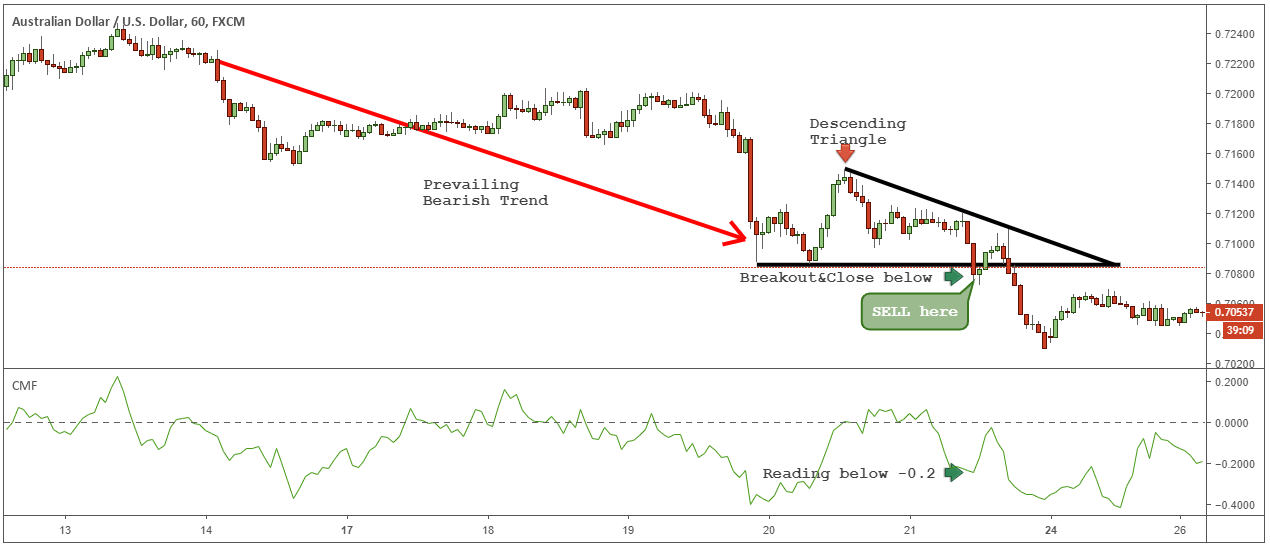
TR
What Is a Falling Wedge?
The Falling Wedge is a bullish pattern that begins wide at the top and contracts as prices move lower. This price action forms a cone that slopes down as the reaction highs and reaction lows converge. In contrast to symmetrical triangles, which have no definitive slope and no bias, falling wedges definitely slope down and have a bullish bias. However, this bullish bias cannot be realized until a resistance breakout occurs. As a reversal pattern, the falling wedge slopes down and with the prevailing trend. Regardless of the type (reversal or continuation), falling wedges are regarded as bullish patterns.
The Falling Wedge is a bullish pattern that begins wide at the top and contracts as prices move lower. This price action forms a cone that slopes down as the reaction highs and reaction lows converge. In contrast to symmetrical triangles, which have no definitive slope and no bias, falling wedges definitely slope down and have a bullish bias. However, this bullish bias cannot be realized until a resistance breakout occurs. As a reversal pattern, the falling wedge slopes down and with the prevailing trend. Regardless of the type (reversal or continuation), falling wedges are regarded as bullish patterns.
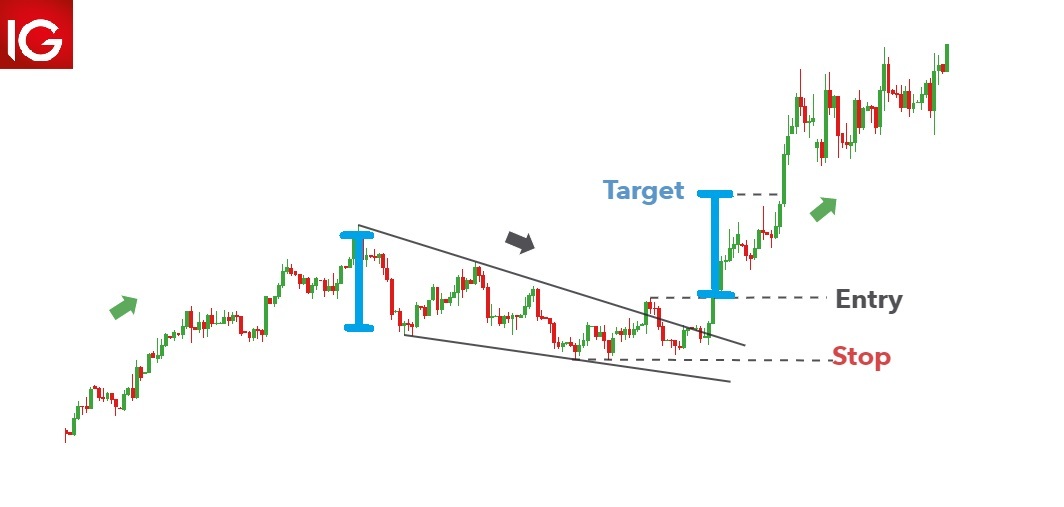
TR
What Is a Rising Wedge?
The Rising Wedge is a bearish pattern that begins wide at the bottom and contracts as prices move higher and the trading range narrows. In contrast to symmetrical triangles, which have no definitive slope and no bullish or bearish bias, rising wedges definitely slope up and have a bearish bias.
While though this article will focus on the rising wedge as a reversal pattern, the pattern can also fit into the continuation category. As a continuation pattern, the rising wedge will still slope up, but the slope will be against the prevailing downtrend. As a reversal pattern, the rising wedge will slope up and with the prevailing trend. Regardless of the type (reversal or continuation), rising wedges are bearish.
The Rising Wedge is a bearish pattern that begins wide at the bottom and contracts as prices move higher and the trading range narrows. In contrast to symmetrical triangles, which have no definitive slope and no bullish or bearish bias, rising wedges definitely slope up and have a bearish bias.
While though this article will focus on the rising wedge as a reversal pattern, the pattern can also fit into the continuation category. As a continuation pattern, the rising wedge will still slope up, but the slope will be against the prevailing downtrend. As a reversal pattern, the rising wedge will slope up and with the prevailing trend. Regardless of the type (reversal or continuation), rising wedges are bearish.
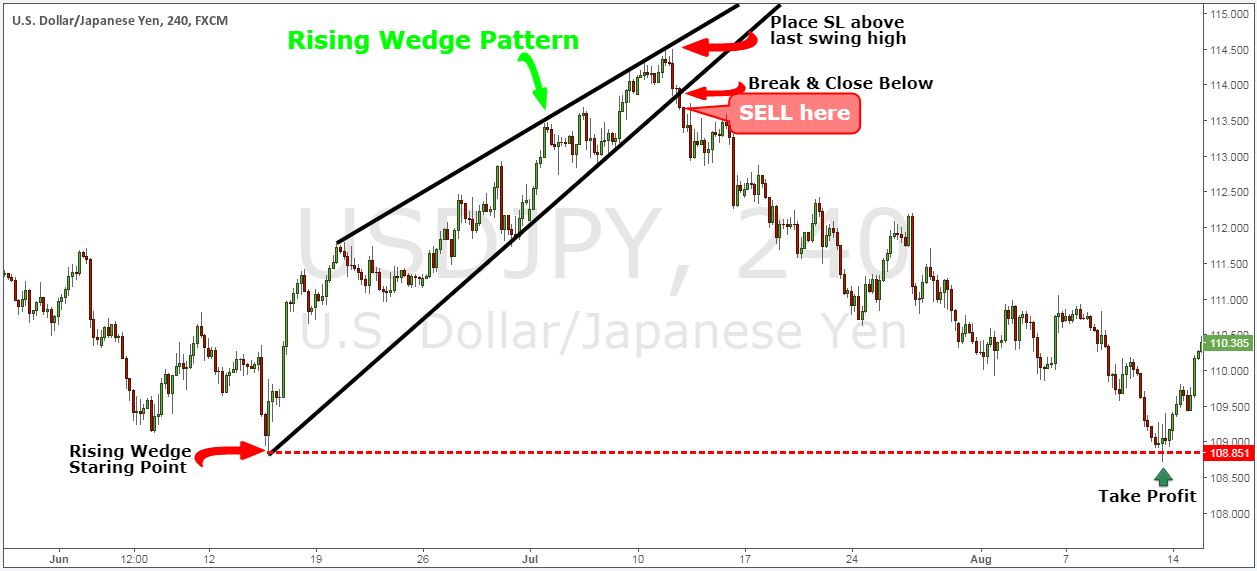
TR
What Are Head And Shoulders?
A head and shoulders pattern is a chart formation that appears as a baseline with three peaks, the outside two are close in height and the middle is highest. In technical analysis, a head and shoulders pattern describes a specific chart formation that predicts a bullish-to-bearish trend reversal. The head and shoulders pattern is believed to be one of the most reliable trend reversal patterns. It is one of several top patterns that signal, with varying degrees of accuracy, that an upward trend is nearing its end.
A head and shoulders pattern is a chart formation that appears as a baseline with three peaks, the outside two are close in height and the middle is highest. In technical analysis, a head and shoulders pattern describes a specific chart formation that predicts a bullish-to-bearish trend reversal. The head and shoulders pattern is believed to be one of the most reliable trend reversal patterns. It is one of several top patterns that signal, with varying degrees of accuracy, that an upward trend is nearing its end.
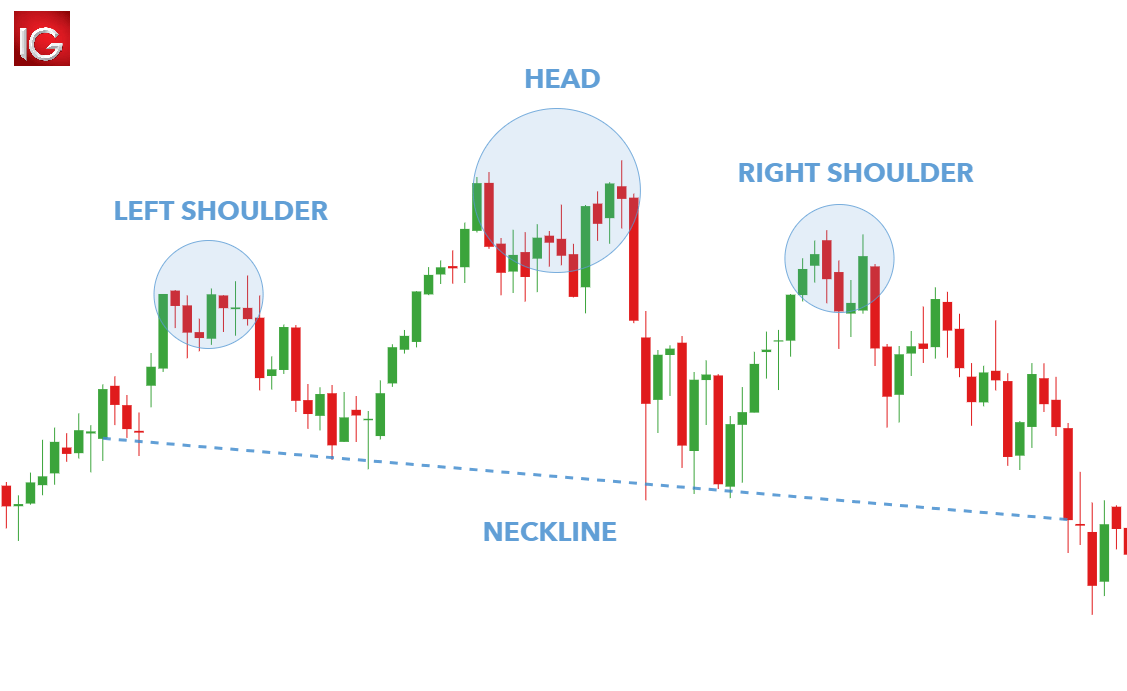
TR
What Are Inverse Head And Shoulders?
An inverse head and shoulders, also called a "head and shoulders bottom", is similar to the standard head and shoulders pattern, but inverted: with the head and shoulders top used to predict reversals in downtrends. This pattern is identified when the price action of a security meets the following characteristics: the price falls to a trough and then rises; the price falls below the former trough and then rises again; finally, the price falls again but not as far as the second trough. Once the final trough is made, the price heads upward, toward the resistance found near the top of the previous troughs.
An inverse head and shoulders, also called a "head and shoulders bottom", is similar to the standard head and shoulders pattern, but inverted: with the head and shoulders top used to predict reversals in downtrends. This pattern is identified when the price action of a security meets the following characteristics: the price falls to a trough and then rises; the price falls below the former trough and then rises again; finally, the price falls again but not as far as the second trough. Once the final trough is made, the price heads upward, toward the resistance found near the top of the previous troughs.

TR
What Is a Cup And Handle?
A cup and handle or cup with handle formation is a chart pattern consisting of a drop in the price and a rise back up to the original value, followed a smaller drop and a rise past the previous peak. The cup is in the shape of a "u", and the handle has a slight downward drift. The cup and handle is considered a bullish signal.
A cup and handle or cup with handle formation is a chart pattern consisting of a drop in the price and a rise back up to the original value, followed a smaller drop and a rise past the previous peak. The cup is in the shape of a "u", and the handle has a slight downward drift. The cup and handle is considered a bullish signal.

TR
What Is a Inverse Cup And Handle?
An Inverted Cup and Handle pattern is formed after a pullback from a swing low sells off strongly to the prior swing low and stalls due to underlying support. The security then stalls much like a bear flag with slight upward pressure before breaking down below support.
An Inverted Cup and Handle pattern is formed after a pullback from a swing low sells off strongly to the prior swing low and stalls due to underlying support. The security then stalls much like a bear flag with slight upward pressure before breaking down below support.
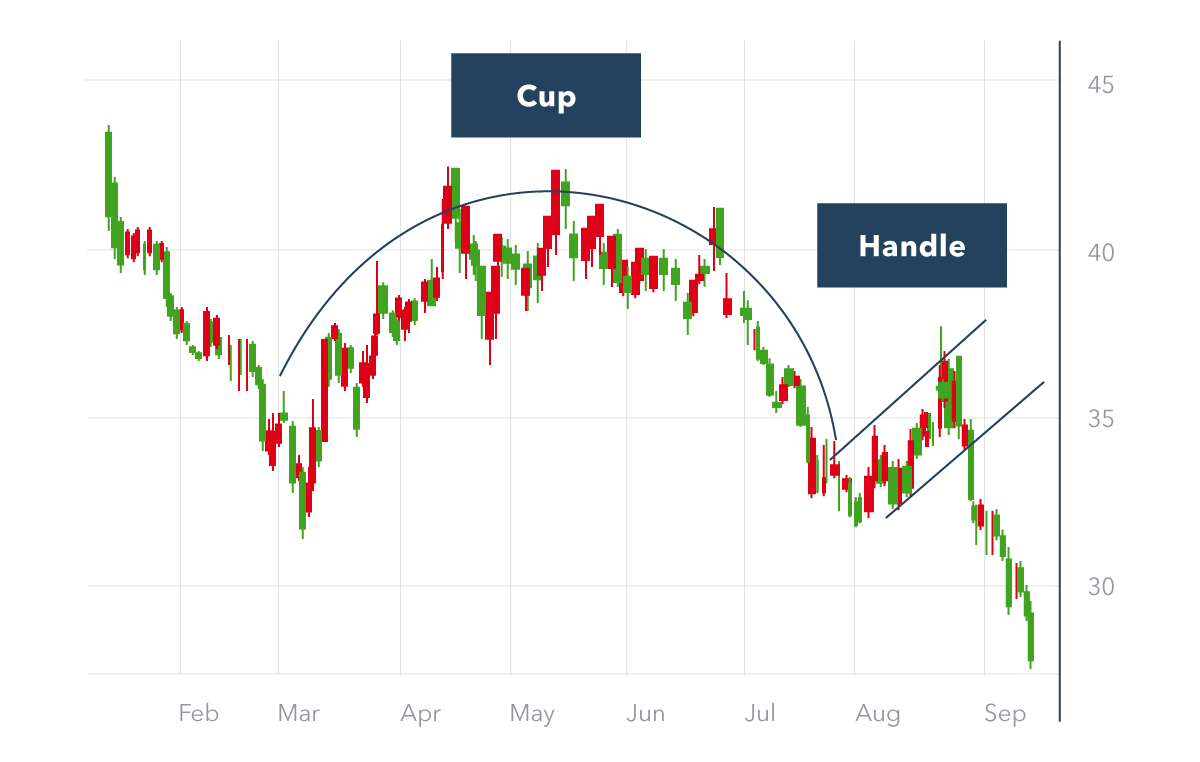
TR
What Is a Double Top?
A double top is an extremely bearish technical reversal pattern that forms after an asset reaches a high price two consecutive times with a moderate decline between the two highs. It is confirmed once the asset's price falls below a support level equal to the low between the two prior highs. The double top looks like the letter "M". The twice-touched low is considered a resistance level.
A double top is an extremely bearish technical reversal pattern that forms after an asset reaches a high price two consecutive times with a moderate decline between the two highs. It is confirmed once the asset's price falls below a support level equal to the low between the two prior highs. The double top looks like the letter "M". The twice-touched low is considered a resistance level.
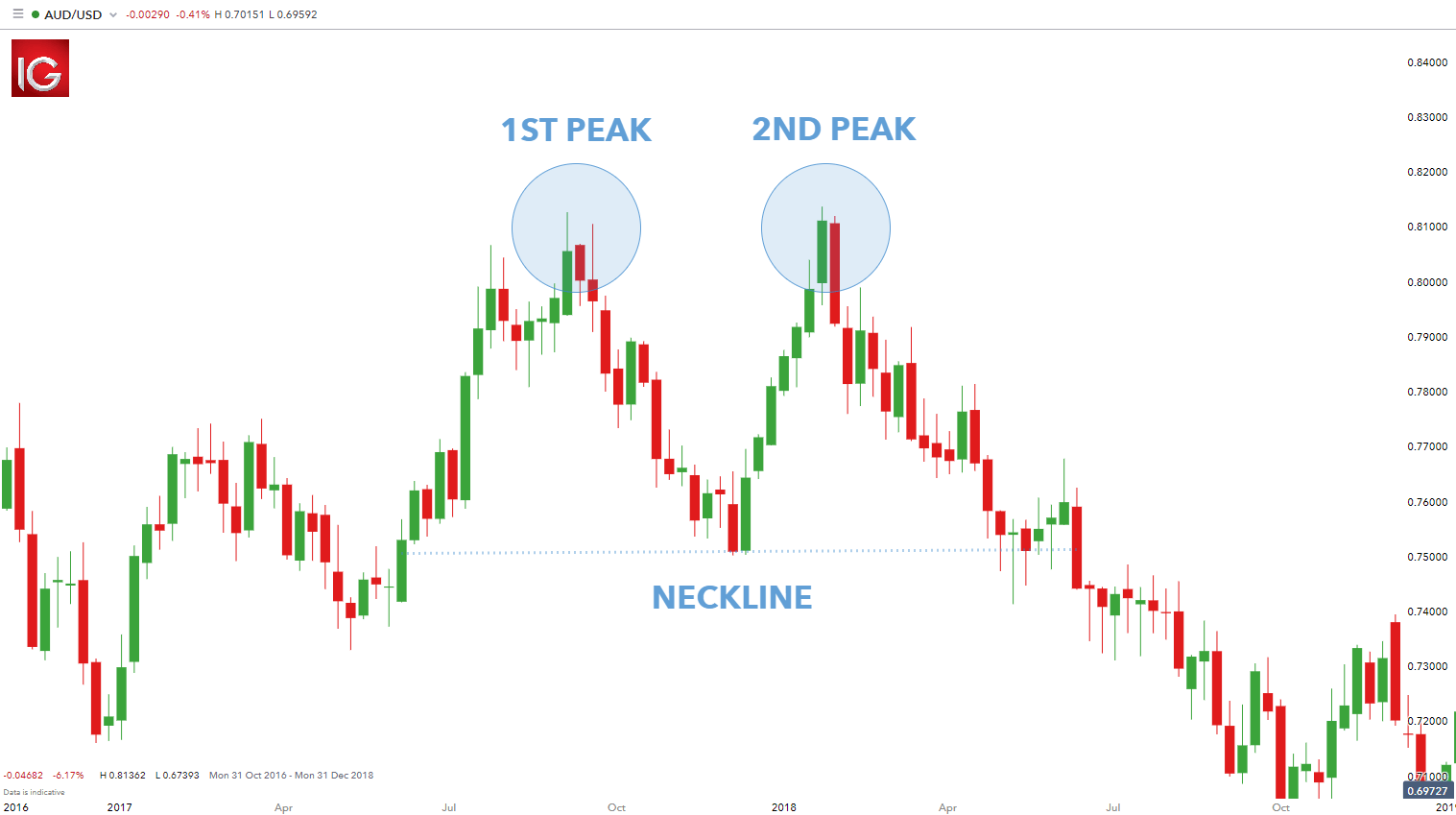
TR
What Is a Double Bottom?
A double bottom pattern is a technical analysis charting pattern that describes a change in trend and a momentum reversal from prior leading price action. It describes the drop of a stock or index, a rebound, another drop to the same or similar level as the original drop, and finally another rebound. The double bottom looks like the letter "W". The twice-touched low is considered a support level.
A double bottom pattern is a technical analysis charting pattern that describes a change in trend and a momentum reversal from prior leading price action. It describes the drop of a stock or index, a rebound, another drop to the same or similar level as the original drop, and finally another rebound. The double bottom looks like the letter "W". The twice-touched low is considered a support level.
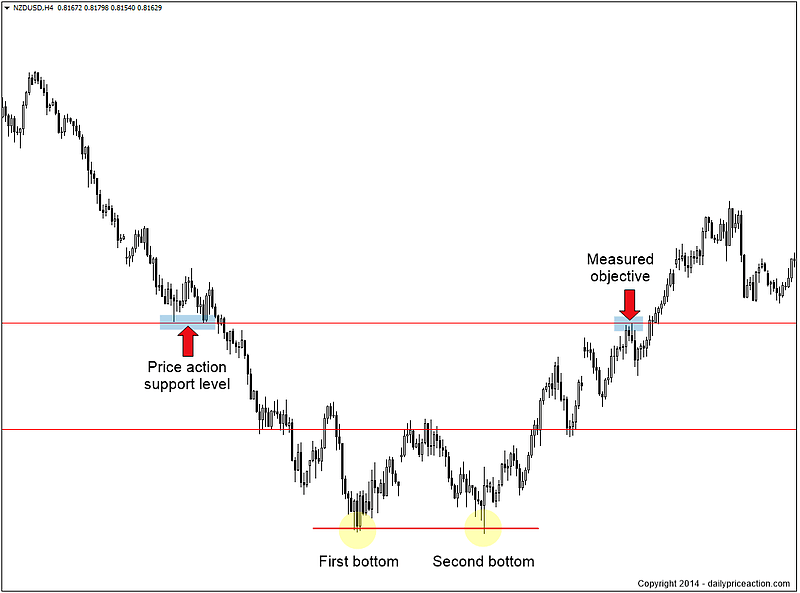
TR
What Is a Trailing Stop Order?
A trailing stop order sets the stop price at a fixed amount below the market price with an attached "trailing" amount. As the market price rises, the stop price rises by the trail amount, but if the stock price falls, the stop loss price doesn't change, and a market order is submitted when the stop price is hit. The inverse is true for shorting.
A trailing stop order sets the stop price at a fixed amount below the market price with an attached "trailing" amount. As the market price rises, the stop price rises by the trail amount, but if the stock price falls, the stop loss price doesn't change, and a market order is submitted when the stop price is hit. The inverse is true for shorting.
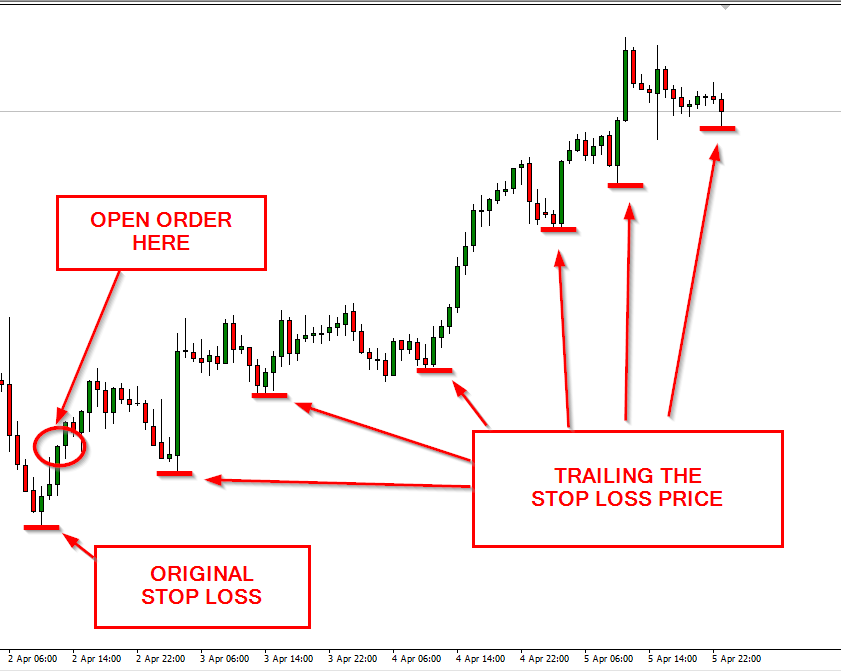
TR
What Is a Limit Order?
A limit order is an order to buy or sell a stock at a specific price or better. A buy limit order can only be executed at the limit price or lower, and a sell limit order can only be executed at the limit price or higher. A limit order is not guaranteed to execute.
A limit order is an order to buy or sell a stock at a specific price or better. A buy limit order can only be executed at the limit price or lower, and a sell limit order can only be executed at the limit price or higher. A limit order is not guaranteed to execute.
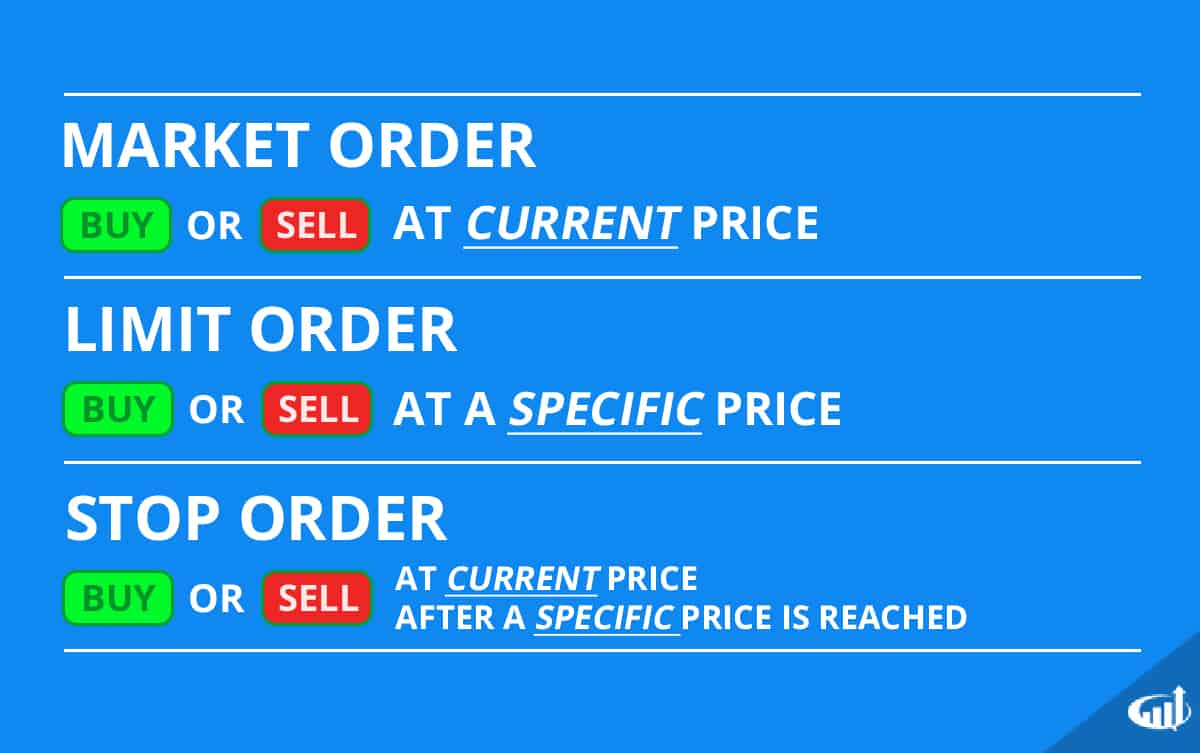
TR
What Is The Volume?
Volume is the amount of an asset or security that changes hands over some period of time, often over the course of a day. For instance, stock trading volume would refer to the number of shares of a security traded between its daily open and close. Trading volume, and changes to volume over the course of time, are important inputs for technical traders because it is used to measure the relative significance of a market move. The higher the volume during a price move, the more significant the move and the lower the volume during a price move, the less significant the move.
Volume is the amount of an asset or security that changes hands over some period of time, often over the course of a day. For instance, stock trading volume would refer to the number of shares of a security traded between its daily open and close. Trading volume, and changes to volume over the course of time, are important inputs for technical traders because it is used to measure the relative significance of a market move. The higher the volume during a price move, the more significant the move and the lower the volume during a price move, the less significant the move.

TR
What Is The Bid & Ask?
The term bid and ask (also known as bid and offer) refers to a two-way price quotation that indicates the best potential price at which a security can be sold and bought at a given point in time. The bid price represents the maximum price that a buyer is willing to pay for a share of stock or other security. The ask price represents the minimum price that a seller is willing to take for that same security. A trade or transaction occurs after the buyer and seller agree on a price for the security which is no higher than the bid and no lower than the ask. The difference between these two prices is known as the spread; the smaller the spread, the greater the liquidity of the given security.
The term bid and ask (also known as bid and offer) refers to a two-way price quotation that indicates the best potential price at which a security can be sold and bought at a given point in time. The bid price represents the maximum price that a buyer is willing to pay for a share of stock or other security. The ask price represents the minimum price that a seller is willing to take for that same security. A trade or transaction occurs after the buyer and seller agree on a price for the security which is no higher than the bid and no lower than the ask. The difference between these two prices is known as the spread; the smaller the spread, the greater the liquidity of the given security.
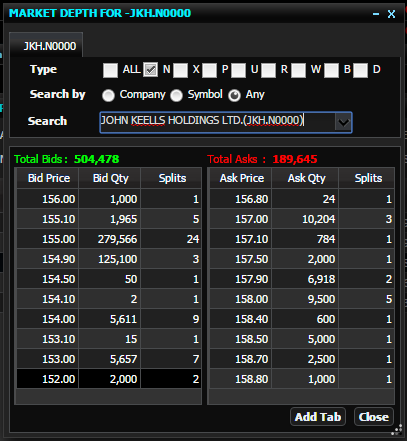
TR
What Is Consolidation?
Consolidation is the term for a stock or security that is neither continuing nor reversing a larger price trend. Consolidated stocks typically trade within limited price ranges and offer relatively few trading opportunities until another pattern emerges.
Consolidation is the term for a stock or security that is neither continuing nor reversing a larger price trend. Consolidated stocks typically trade within limited price ranges and offer relatively few trading opportunities until another pattern emerges.
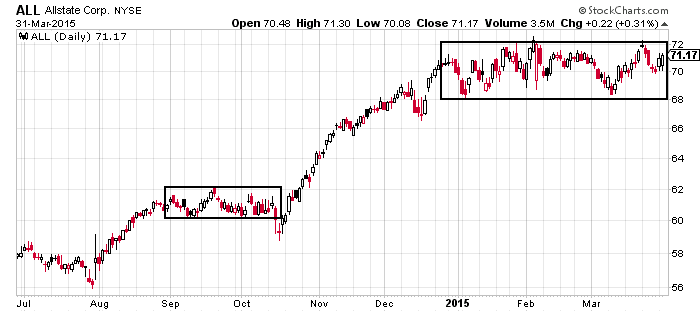
TR
What Is a Bull Market?
A bull market is the condition of a financial market in which prices are rising or are expected to rise. The term "bull market" is most often used to refer to the stock market but can be applied to anything that is traded, such as bonds, real estate, currencies and commodities.
A bull market is the condition of a financial market in which prices are rising or are expected to rise. The term "bull market" is most often used to refer to the stock market but can be applied to anything that is traded, such as bonds, real estate, currencies and commodities.
TR
What Is a Bear Market?
A bear market is when a market experiences prolonged price declines. It typically describes a condition in which securities prices fall 20% or more from recent highs amid widespread pessimism and negative investor sentiment. Bear markets are often associated with declines in an overall market or index like the S&P 500, but individual securities or commodities can also be considered to be in a bear market if they experience a decline of 20% or more over a sustained period of time—typically two months or more. Bear markets also may accompany general economic downturns such as a recession.
A bear market is when a market experiences prolonged price declines. It typically describes a condition in which securities prices fall 20% or more from recent highs amid widespread pessimism and negative investor sentiment. Bear markets are often associated with declines in an overall market or index like the S&P 500, but individual securities or commodities can also be considered to be in a bear market if they experience a decline of 20% or more over a sustained period of time—typically two months or more. Bear markets also may accompany general economic downturns such as a recession.
TR
What Is Volatility?
Volatility is a statistical measure of the dispersion of returns for a given security or market index. In most cases, the higher the volatility, the riskier the security. Volatility is often measured as either the standard deviation or variance between returns from that same security or market index.
In the securities markets, volatility is often associated with big swings in either direction. For example, when the stock market rises and falls more than one percent over a sustained period of time, it is called a "volatile" market. An asset's volatility is a key factor when pricing options contracts.
Volatility is a statistical measure of the dispersion of returns for a given security or market index. In most cases, the higher the volatility, the riskier the security. Volatility is often measured as either the standard deviation or variance between returns from that same security or market index.
In the securities markets, volatility is often associated with big swings in either direction. For example, when the stock market rises and falls more than one percent over a sustained period of time, it is called a "volatile" market. An asset's volatility is a key factor when pricing options contracts.
TR
What Are Time Frames Used For?
A swing trader, who focuses on daily charts for decisions, could use weekly charts to define the primary trend and 60-minute charts to define the short-term trend.
A day trader could trade off of 15-minute charts, use 60-minute charts to define the primary trend and a five-minute chart (or even a tick chart) to define the short-term trend.
A long-term position trader could focus on weekly charts while using monthly charts to define the primary trend and daily charts to refine entries and exits.
A swing trader, who focuses on daily charts for decisions, could use weekly charts to define the primary trend and 60-minute charts to define the short-term trend.
A day trader could trade off of 15-minute charts, use 60-minute charts to define the primary trend and a five-minute chart (or even a tick chart) to define the short-term trend.
A long-term position trader could focus on weekly charts while using monthly charts to define the primary trend and daily charts to refine entries and exits.
TR
What Is an Exponential Moving Average (EMA)?
An exponential moving average (EMA) is a type of moving average (MA) that places a greater weight and significance on the most recent data points. The exponential moving average is also referred to as the exponentially weighted moving average. An exponentially weighted moving average reacts more significantly to recent price changes than a simple moving average (SMA), which applies an equal weight to all observations in the period.
Like all moving averages, this technical indicator is used to produce buy and sell signals based on crossovers and divergences from the historical average. Traders often use several different EMA lengths, such as 10-day, 50-day, and 200-day moving averages.
An exponential moving average (EMA) is a type of moving average (MA) that places a greater weight and significance on the most recent data points. The exponential moving average is also referred to as the exponentially weighted moving average. An exponentially weighted moving average reacts more significantly to recent price changes than a simple moving average (SMA), which applies an equal weight to all observations in the period.
Like all moving averages, this technical indicator is used to produce buy and sell signals based on crossovers and divergences from the historical average. Traders often use several different EMA lengths, such as 10-day, 50-day, and 200-day moving averages.

TR
What Is a Position?
A position is the amount of a security, commodity, or currency which is owned by an individual, dealer, institution, or other fiscal entity. They come in two types: short positions, which are borrowed and then sold, and long positions, which are owned and then sold. Depending on market trends, movements and fluctuations, a position can be profitable or unprofitable. Restating the value of a position to reflect its actual current value on the open market is referred to in the industry as “mark-to-market.”
A position is the amount of a security, commodity, or currency which is owned by an individual, dealer, institution, or other fiscal entity. They come in two types: short positions, which are borrowed and then sold, and long positions, which are owned and then sold. Depending on market trends, movements and fluctuations, a position can be profitable or unprofitable. Restating the value of a position to reflect its actual current value on the open market is referred to in the industry as “mark-to-market.”
TR
What Is an Engulfing Candle?
A bearish engulfing candle occurs when the real body of a down candle completely engulfs the real body of the prior green candle. And, a bullish engulfing candle occurs when the real body of an up candle completely engulfs the real body of the prior red candle. There are many engulfing candles throughout candlesticks charts if you look for them.
A bearish engulfing candle occurs when the real body of a down candle completely engulfs the real body of the prior green candle. And, a bullish engulfing candle occurs when the real body of an up candle completely engulfs the real body of the prior red candle. There are many engulfing candles throughout candlesticks charts if you look for them.
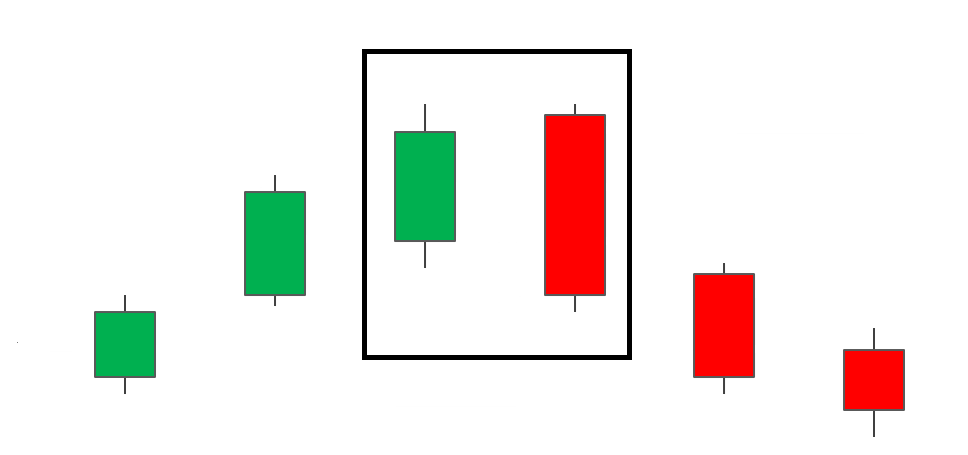
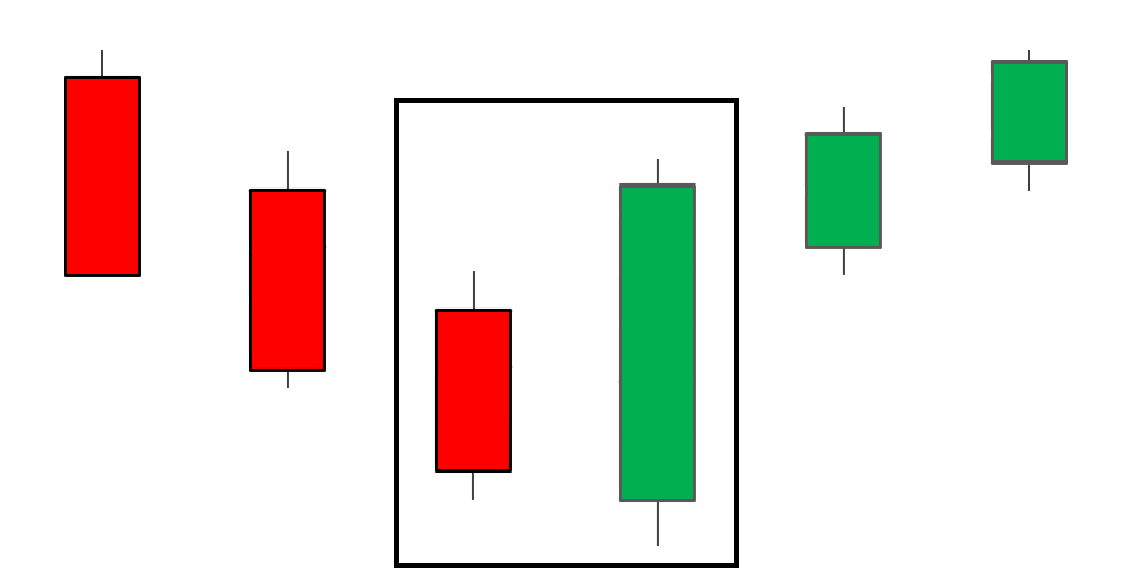
TR
What Is a Stop Loss?
A stop-loss order is an order placed with a broker to buy or sell a security when it reaches a certain price. Stop-loss orders are designed to limit an investor’s loss on a position in a security and are different from stop-limit orders. When a stock falls below the stop price the order becomes a market order and it executes at the next available price.
For example, a trader may buy a stock and places a stop-loss order 10% below the purchase price. Should the stock drop, the stop-loss order would be activated, and the stock would be sold as a market order. In many cases, stop-loss orders are used to prevent investor losses when the price of a security drops. Although most investors associate a stop-loss order with a long position, it can also protect a short position, in which case the security gets bought if it trades above a defined price.
A stop-loss order is an order placed with a broker to buy or sell a security when it reaches a certain price. Stop-loss orders are designed to limit an investor’s loss on a position in a security and are different from stop-limit orders. When a stock falls below the stop price the order becomes a market order and it executes at the next available price.
For example, a trader may buy a stock and places a stop-loss order 10% below the purchase price. Should the stock drop, the stop-loss order would be activated, and the stock would be sold as a market order. In many cases, stop-loss orders are used to prevent investor losses when the price of a security drops. Although most investors associate a stop-loss order with a long position, it can also protect a short position, in which case the security gets bought if it trades above a defined price.
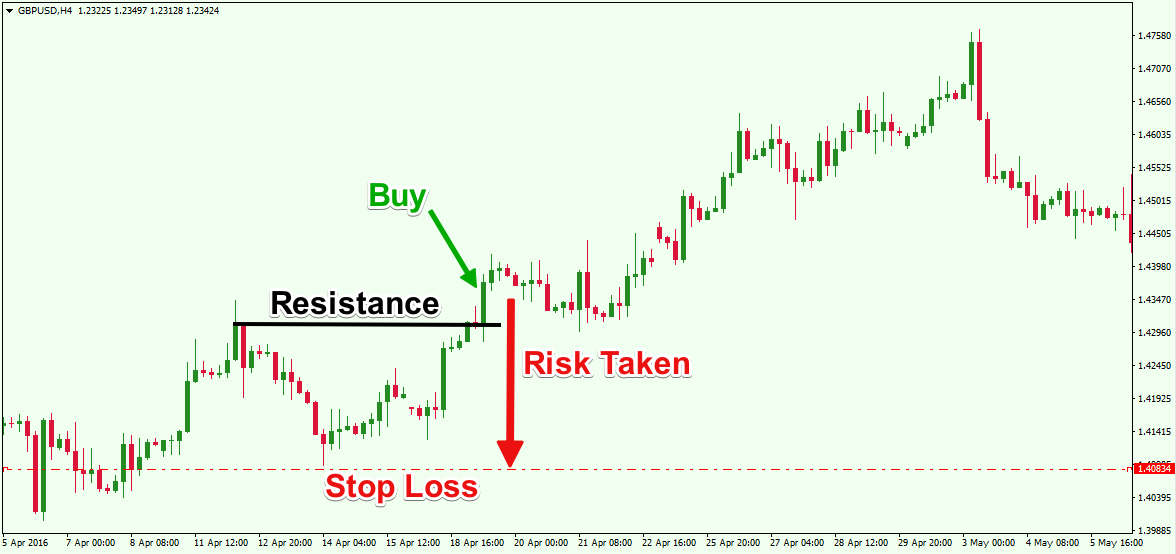
TR
What Is The Mark?
Mark price is the mid-point between the bid and the ask. It is also a reference price of a derivative that is calculated from underlying index, often calculated as a weighted index spot price of an asset across multiple exchanges (to protect from manipulation on a single exchange).
Mark price is the mid-point between the bid and the ask. It is also a reference price of a derivative that is calculated from underlying index, often calculated as a weighted index spot price of an asset across multiple exchanges (to protect from manipulation on a single exchange).
TR
What Is The Mark Change?
The mark change is the change in mark price (the mid-point between the bid and the ask) since the position was opened.
The mark change is the change in mark price (the mid-point between the bid and the ask) since the position was opened.
TR
What Is Stochastics?
In technical analysis of securities trading, the stochastic oscillator (Stochastics) is a momentum indicator that uses support and resistance levels. Dr. George Lane developed this indicator in the late 1950s. The term stochastic refers to the point of a current price in relation to its price range over a period of time. The sensitivity of the oscillator to market movements is reducible by adjusting that time period or by taking a moving average of the result.
In technical analysis of securities trading, the stochastic oscillator (Stochastics) is a momentum indicator that uses support and resistance levels. Dr. George Lane developed this indicator in the late 1950s. The term stochastic refers to the point of a current price in relation to its price range over a period of time. The sensitivity of the oscillator to market movements is reducible by adjusting that time period or by taking a moving average of the result.
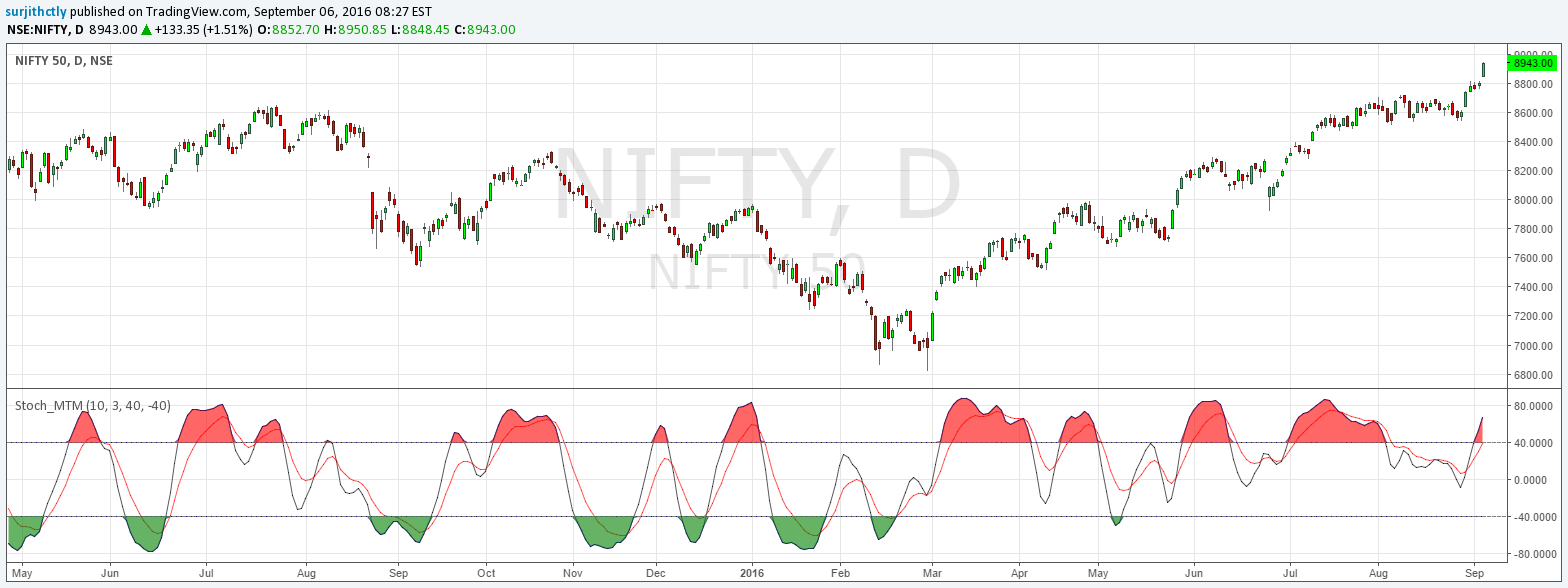
TR
What Is RSI?
The relative strength index is a technical indicator used in the analysis of financial markets. It is intended to chart the current and historical strength or weakness of a stock or market based on the closing prices of a recent trading period. The indicator should not be confused with relative strength.
It is a momentum oscillator that measures the speed and change of price movements. The RSI oscillates between zero and 100. Traditionally the RSI is considered overbought when above 70 and oversold when below 30. Signals can be generated by looking for divergences and failure swings. RSI can also be used to identify the general trend.
The relative strength index is a technical indicator used in the analysis of financial markets. It is intended to chart the current and historical strength or weakness of a stock or market based on the closing prices of a recent trading period. The indicator should not be confused with relative strength.
It is a momentum oscillator that measures the speed and change of price movements. The RSI oscillates between zero and 100. Traditionally the RSI is considered overbought when above 70 and oversold when below 30. Signals can be generated by looking for divergences and failure swings. RSI can also be used to identify the general trend.
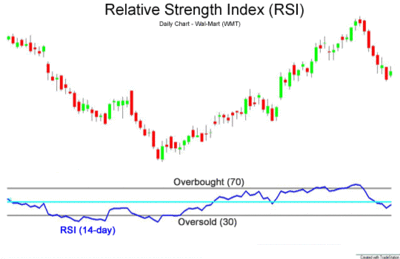
TR
What Is The Last (Price)?
The last price of a stock is just one price to consider when buying or selling shares. The last price is simply the most recent one. For example, if shares of Microsoft (MSFT) trade $50 per share, then $51, and then $50, and then $49. The last price is the most recent transaction, but it doesn't always accurately represent the price you would get if you were to buy or sell right now. The last price might have taken place at the bid or ask, or the bid or ask price might have changed as a result of or since the last price.
The last price of a stock is just one price to consider when buying or selling shares. The last price is simply the most recent one. For example, if shares of Microsoft (MSFT) trade $50 per share, then $51, and then $50, and then $49. The last price is the most recent transaction, but it doesn't always accurately represent the price you would get if you were to buy or sell right now. The last price might have taken place at the bid or ask, or the bid or ask price might have changed as a result of or since the last price.
TR
What Is The (Percent) Change?
Percentage change represents a degree of change over time; it is used for many purposes in finance, most notably to indicate the price change of a security. Percentage change can be applied to any quantity that can be measured over time. Positive values indicate a percentage increase whereas negative values indicate percentage decrease.
Percentage change represents a degree of change over time; it is used for many purposes in finance, most notably to indicate the price change of a security. Percentage change can be applied to any quantity that can be measured over time. Positive values indicate a percentage increase whereas negative values indicate percentage decrease.

TR
What Is an Uptrend?
An uptrend describes the price movement of a financial asset when the overall direction is upward. In an uptrend, each successive peak and trough is higher than the ones found earlier in the trend. As long as the price is making these higher swing lows and higher swing highs, the uptrend is considered intact.
An uptrend describes the price movement of a financial asset when the overall direction is upward. In an uptrend, each successive peak and trough is higher than the ones found earlier in the trend. As long as the price is making these higher swing lows and higher swing highs, the uptrend is considered intact.
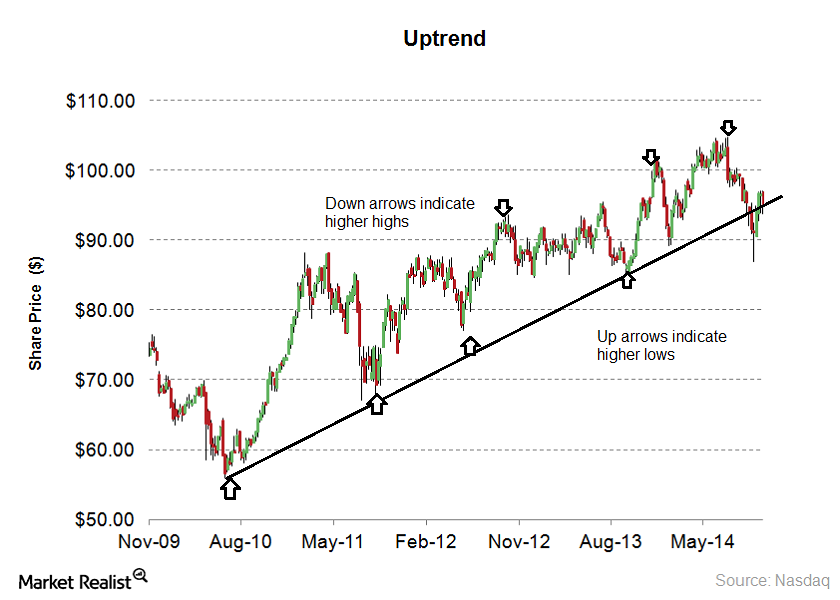
TR
What Is a Downtrend?
A downtrend refers to the price action of a security that moves lower in price as it fluctuates over time. While the price may move intermittently higher or lower, downtrends are characterized by lower peaks and lower troughs over time.
Technical analysts pay attention to downtrends because they represent something more than a random losing streak. Securities in a downtrend seem to be more likely to continue trending lower until some market condition changes, implying that a downtrend marks a fundamentally deteriorating condition.
A downtrend refers to the price action of a security that moves lower in price as it fluctuates over time. While the price may move intermittently higher or lower, downtrends are characterized by lower peaks and lower troughs over time.
Technical analysts pay attention to downtrends because they represent something more than a random losing streak. Securities in a downtrend seem to be more likely to continue trending lower until some market condition changes, implying that a downtrend marks a fundamentally deteriorating condition.
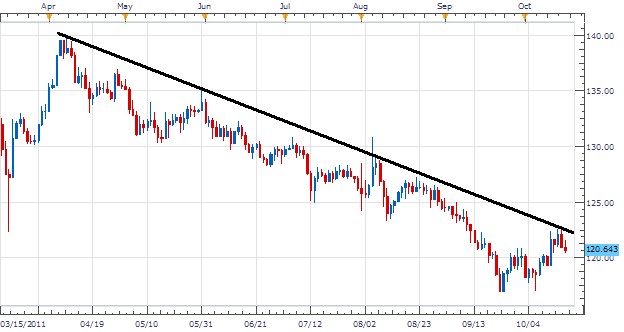
TR
What Is a Sideways Trend?
A sideways trend is the horizontal price movement that occurs when the forces of supply and demand are nearly equal. This typically occurs during a period of consolidation before the price continues a prior trend or reverses into a new trend. A sideways price trend is also commonly known as a "horizontal trend" or a "ranging market".
A sideways trend is the horizontal price movement that occurs when the forces of supply and demand are nearly equal. This typically occurs during a period of consolidation before the price continues a prior trend or reverses into a new trend. A sideways price trend is also commonly known as a "horizontal trend" or a "ranging market".
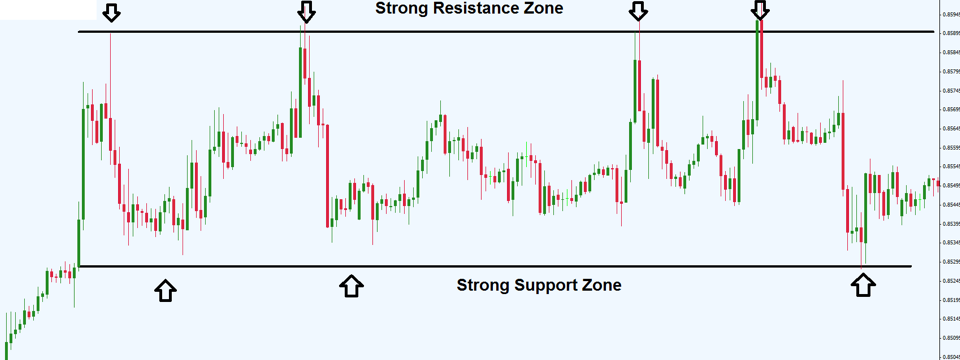
TR
What Are Higher Highs (HH) & Higher Lows (HL)?
Higher highs + higher lows define an upward trend. Watch an explanatory video by clicking on the question.
Higher highs + higher lows define an upward trend. Watch an explanatory video by clicking on the question.
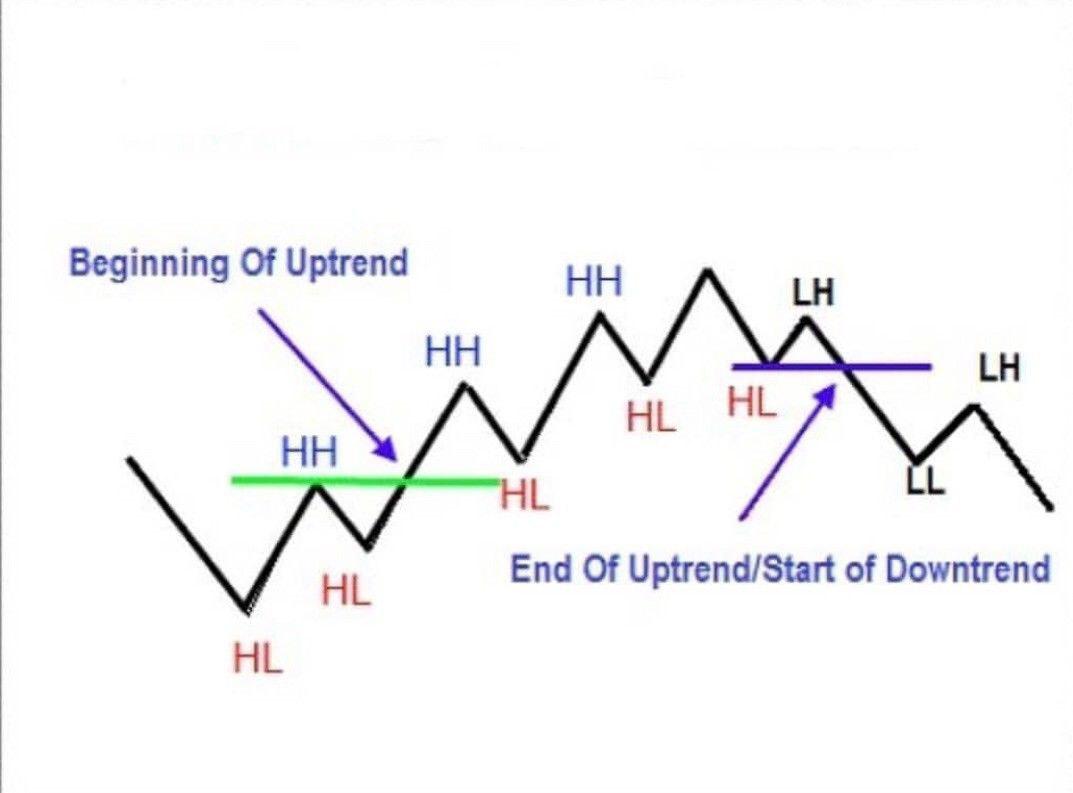

TR
What Are Lower Highs (LH) & Lower Lows (LL)?
Lower highs +lower lows define a downward trend. Watch an explanatory video by clicking on the question.
Lower highs +lower lows define a downward trend. Watch an explanatory video by clicking on the question.

TR
What Is Fibinacci Retracement?
Fibonacci retracement levels are horizontal lines that indicate where support and resistance are likely to occur. They are based on Fibonacci numbers. Each level is associated with a percentage. The percentage is how much of a prior move the price has retraced. The Fibonacci retracement levels are 23.6%, 38.2%, 61.8%, and 78.6%. While not officially a Fibonacci ratio, 50% is also used.
The indicator is useful because it can be drawn between any two significant price points, such as a high and a low. The indicator will then create the levels between those two points.
Suppose the price of a stock rises $10 and then drops $2.36. In that case, it has retraced 23.6%, which is a Fibonacci number. Fibonacci numbers are found throughout nature. Therefore, many traders believe that these numbers also have relevance in financial markets.
Fibonacci retracement levels are horizontal lines that indicate where support and resistance are likely to occur. They are based on Fibonacci numbers. Each level is associated with a percentage. The percentage is how much of a prior move the price has retraced. The Fibonacci retracement levels are 23.6%, 38.2%, 61.8%, and 78.6%. While not officially a Fibonacci ratio, 50% is also used.
The indicator is useful because it can be drawn between any two significant price points, such as a high and a low. The indicator will then create the levels between those two points.
Suppose the price of a stock rises $10 and then drops $2.36. In that case, it has retraced 23.6%, which is a Fibonacci number. Fibonacci numbers are found throughout nature. Therefore, many traders believe that these numbers also have relevance in financial markets.
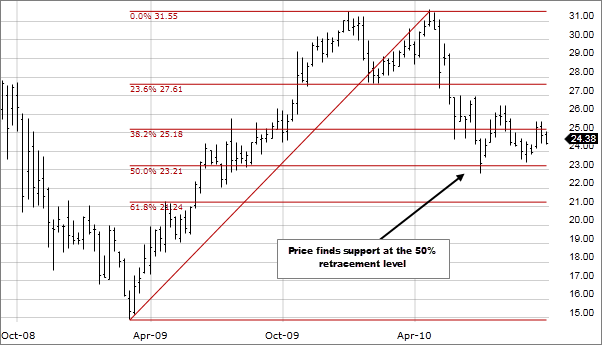
TR
What Is "Impulse, Correction, Continuation" On Candle Charts?
Impulse = Price moves up (strong).
Correction = Price comes down a little and doesnt move as strong as the impulse one.
Continuation = After the correction price moves in the direction of the first impulse move.
Generally speaking, price tends to move in waves continuously going up and down, up and down.
Impulse = Price moves up (strong).
Correction = Price comes down a little and doesnt move as strong as the impulse one.
Continuation = After the correction price moves in the direction of the first impulse move.
Generally speaking, price tends to move in waves continuously going up and down, up and down.
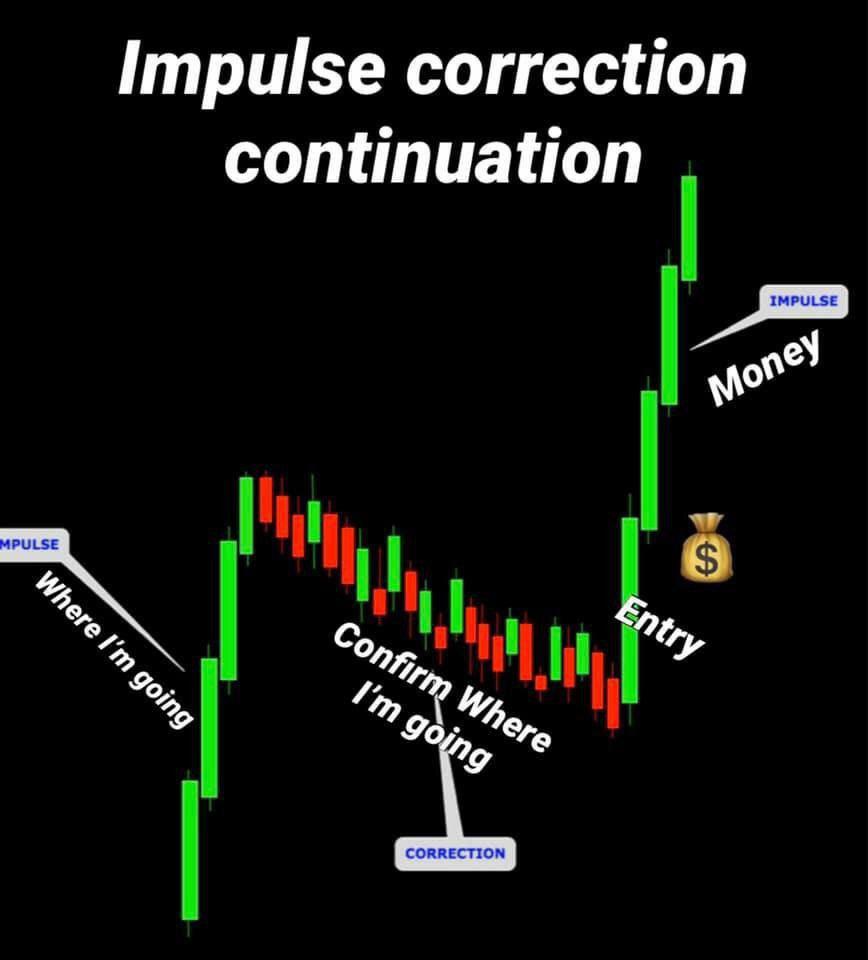
TR
What Is a Marubozu Candle?
Marubozu is used in technical analysis to indicate a stock has traded strongly in one direction. A marubozu candle is represented only by a body; it has no wicks or shadows extending from the top or bottom of the candle.
A green marubozu candle has a long green body and is formed when the open equals the low and the close equals the high. The green marubozu candle indicates that buyers controlled the price of the stock from the opening bell to the close of the day, and is considered very bullish.
A red marubozu candle has a long red body and is formed when the open equals the high and the close equals the low. A red marubozu indicates that sellers controlled the price from the opening bell to the close of the day, and is considered very bearish.
Marubozu is used in technical analysis to indicate a stock has traded strongly in one direction. A marubozu candle is represented only by a body; it has no wicks or shadows extending from the top or bottom of the candle.
A green marubozu candle has a long green body and is formed when the open equals the low and the close equals the high. The green marubozu candle indicates that buyers controlled the price of the stock from the opening bell to the close of the day, and is considered very bullish.
A red marubozu candle has a long red body and is formed when the open equals the high and the close equals the low. A red marubozu indicates that sellers controlled the price from the opening bell to the close of the day, and is considered very bearish.
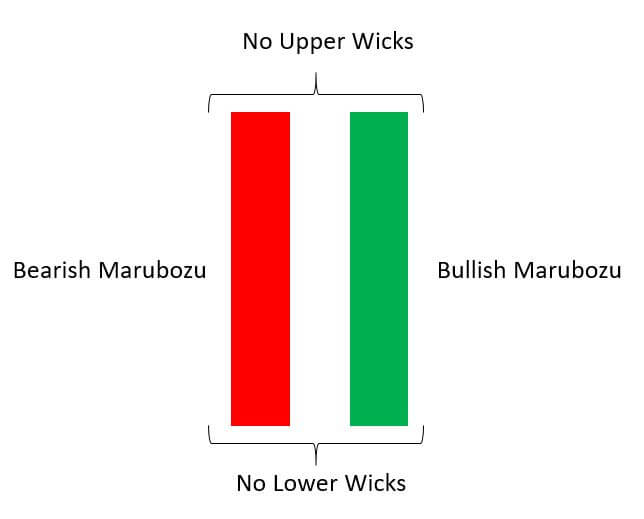
TR
What Is a Defined-Contribution (DC) Plan?
A defined-contribution (DC) plan is a retirement plan that's typically tax-deferred, like a 401k or a 403b, in which the employer, employee or both make contributions on a regular basis. Individual accounts are set up for participants and benefits are based on the amounts credited to these accounts plus any investment earnings on the money in the account.
A defined-contribution (DC) plan is a retirement plan that's typically tax-deferred, like a 401k or a 403b, in which the employer, employee or both make contributions on a regular basis. Individual accounts are set up for participants and benefits are based on the amounts credited to these accounts plus any investment earnings on the money in the account.
FI
What Is Investment Horizon?
Investment horizon is a term used to identify the length of time an investor is aiming to maintain their portfolio before selling their securities. The issuing company creates these instruments for the express purpose of raising funds to further finance business activities and expansion.
Investment horizon is a term used to identify the length of time an investor is aiming to maintain their portfolio before selling their securities. The issuing company creates these instruments for the express purpose of raising funds to further finance business activities and expansion.
FI
What Is a DRIP?
A DRIP is a dividend reinvestment plan whereby cash dividends are reinvested to purchase more stock in the company. DRIPs use a technique called dollar-cost averaging intended to average out the price at which you buy stock as it moves up or down.
To start a DRIP account, consumers can directly contact investor relations at the desired company. If the company, like Apple, doesn’t directly offer a DRIP program, but pays dividends, investors can work with a broker to set one up, though it would lack some features of a company-sponsored plan.
A DRIP is a dividend reinvestment plan whereby cash dividends are reinvested to purchase more stock in the company. DRIPs use a technique called dollar-cost averaging intended to average out the price at which you buy stock as it moves up or down.
To start a DRIP account, consumers can directly contact investor relations at the desired company. If the company, like Apple, doesn’t directly offer a DRIP program, but pays dividends, investors can work with a broker to set one up, though it would lack some features of a company-sponsored plan.
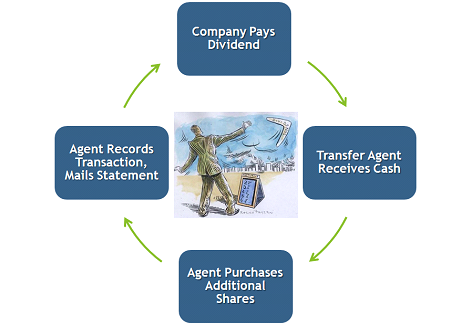
DI
What Is a Record Date?
The record date is the date that the company reviews its records to see which shareholders qualified for the next dividend payment. However, investors who buy shares on the record date will be too late to be eligible for the next dividend. The record date is merely a date for the companies that pay dividends to get their records in order.
The record date is the date that the company reviews its records to see which shareholders qualified for the next dividend payment. However, investors who buy shares on the record date will be too late to be eligible for the next dividend. The record date is merely a date for the companies that pay dividends to get their records in order.
DI
What Is a Payable Date?
The payable date refers to the date that any declared stock dividends are due to be paid out. Investors who purchased their stock before the ex-dividend date are eligible to receive dividends on the payable date. It's important to note that if the stock is sold on or after the ex-dividend date, the investor will still get paid the next scheduled dividend.
The payable date refers to the date that any declared stock dividends are due to be paid out. Investors who purchased their stock before the ex-dividend date are eligible to receive dividends on the payable date. It's important to note that if the stock is sold on or after the ex-dividend date, the investor will still get paid the next scheduled dividend.
DI
How Much Needs To Be In a Portfolio To Live Off Dividends?
One of the best reasons why stocks should be part of every investor's portfolio is, unlike the interest from bonds, stock dividends tend to grow over time. More importantly, that dividend growth has historically outpaced inflation. For those investors with a long timeline, this fact can be exploited in order to create a portfolio that can be used strictly for dividend-income living. The smart strategy lies within using those dividends to buy more shares of stock in a firm so that they will receive even more dividends and buy even more shares. By investing in quality dividend stocks with rising payouts, both young and old investors can benefit from the stocks' compounding, and historically inflation-beating, distribution growth. All it takes is a little planning and investors can live off their dividend payment streams.
One of the best reasons why stocks should be part of every investor's portfolio is, unlike the interest from bonds, stock dividends tend to grow over time. More importantly, that dividend growth has historically outpaced inflation. For those investors with a long timeline, this fact can be exploited in order to create a portfolio that can be used strictly for dividend-income living. The smart strategy lies within using those dividends to buy more shares of stock in a firm so that they will receive even more dividends and buy even more shares. By investing in quality dividend stocks with rising payouts, both young and old investors can benefit from the stocks' compounding, and historically inflation-beating, distribution growth. All it takes is a little planning and investors can live off their dividend payment streams.

DI
www.forex.com/en-us/education/glossary/
Checklist for trades etc.
- Try 50 simulated trades... or not
- Need a 75% success rate
- Correction/Recession passing over?
$75 - $100
------------
Day Trade
Goal for a $2000 account.
15% Risk, 1C @ $200 - $300 per Contract, ATM.
Out the morning gate.
Upcoming Questions:
What Is a Quote? What Is a Margin Call? What Are Indices/Indexes? What Is a Pip? What Is The Exchange Rate? What Is Cash Flow? What Is a Cash Flow Statement? What Are Assets? What Are Liabilities? What Is a Balance Sheet? What Is Considered an Expense? What Is an Income Statement? What Is Net Profit? What Is a Futures Contract? What Is P/E Ratio? What Is An LLC? What Is a Sole Propietor? What Is a Holding Company? https://www.forex.com/en-us/education/glossary/
- Try 50 simulated trades... or not
- Need a 75% success rate
- Correction/Recession passing over?
$75 - $100
------------
Day Trade
Goal for a $2000 account.
15% Risk, 1C @ $200 - $300 per Contract, ATM.
Out the morning gate.
Upcoming Questions:
What Is a Quote? What Is a Margin Call? What Are Indices/Indexes? What Is a Pip? What Is The Exchange Rate? What Is Cash Flow? What Is a Cash Flow Statement? What Are Assets? What Are Liabilities? What Is a Balance Sheet? What Is Considered an Expense? What Is an Income Statement? What Is Net Profit? What Is a Futures Contract? What Is P/E Ratio? What Is An LLC? What Is a Sole Propietor? What Is a Holding Company? https://www.forex.com/en-us/education/glossary/
